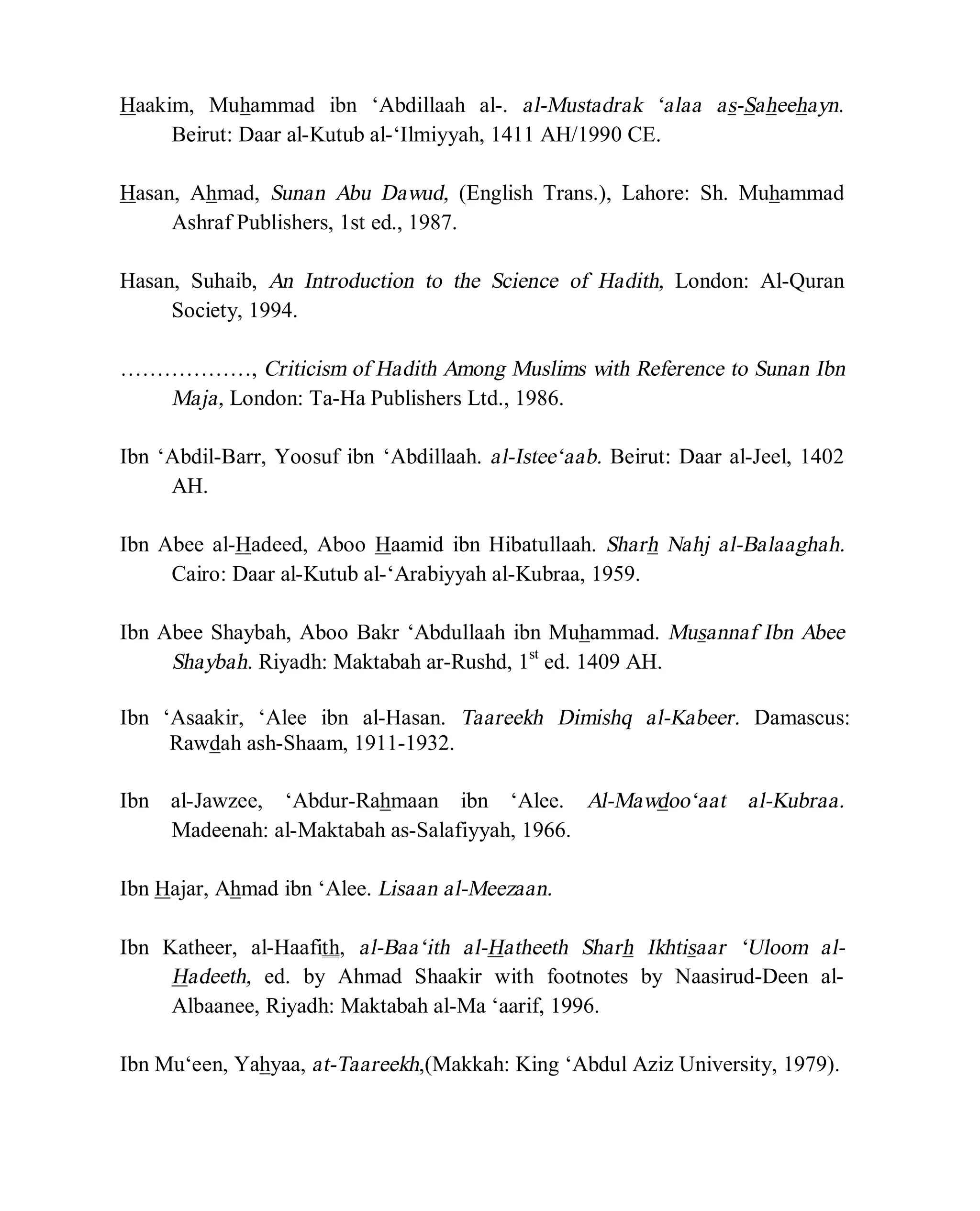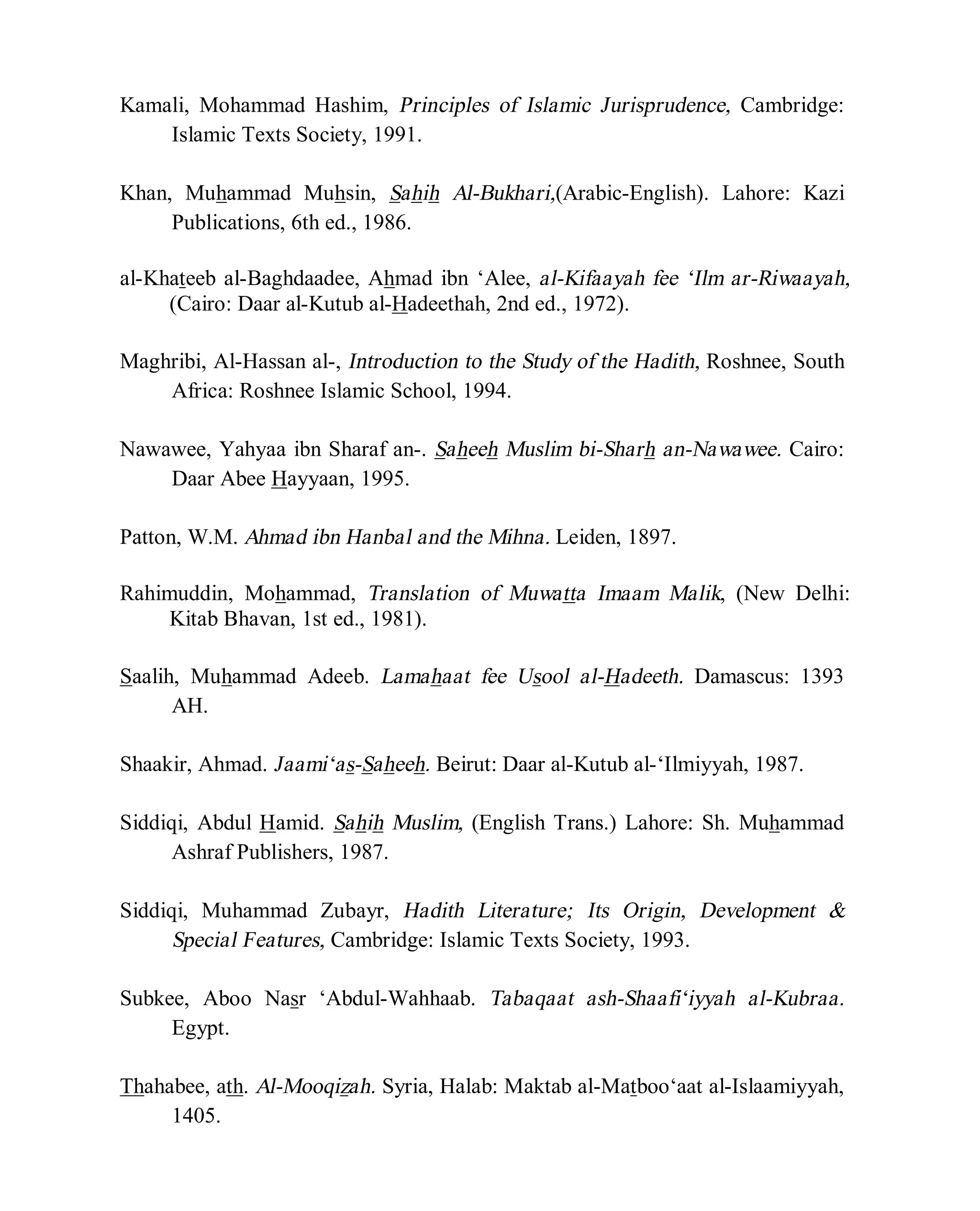The document provides definitions and explanations of the term "hadeeth" and how it is used. It defines hadeeth linguistically as news, reports or conversations, and notes that in an Islamic context it came to specifically refer to reports about the sayings and actions of the Prophet Muhammad. It then discusses three categories of usage for the term hadeeth: (1) referring to the Quran itself, (2) referring to historical stories, and (3) referring to general conversations. The document aims to clarify terminology related to evaluating and studying hadith.

![[Usool Al Hadeeth]
The Methodology of Hadith
Evaluation
In the Name of Allah, the beneficent, the merciful
All Praise is due to Allah, the Lord of the Worlds, the [One Who] Sustains the Heavens
and Earths, Director of all that is created, who sent the Messengers (may the peace and
blessings of Allah be upon all of them) to rational beings, to guide them and explain the
religious laws to them with clear proofs and undeniable arguments. I praise Him for all
of His bounties. I ask Him to increase His Grace and Generosity. I bear witness that
there is none worthy of worship except Allah alone, who has no partner, the One, Who
Subdues, the Generous, the Forgiving. I bear witness that our leader Muhammad is His
servant and Messenger, His beloved and dear one, the best of all creation. He was
honored with the Glorious Qur’an that has been an enduring miracle throughout the
years. He was also sent with his guiding Sunnah that shows the way for those who seek
guidance. Our leader Muhammad has been particularized with the characteristic of
eloquent and pithy speech, and simplicity and ease in the religion. May the peace and
blessings of Allah be upon him, the other Prophets and Messengers, all of their families
and the rest of the righteous.
NO Copyrights!!!
This book can be printed or reproduced or utilized in any form or by any electronic,
mechanical, or other means, now known or hereafter invented, including photocopying
and recording, without permission from the publisher for the sake of spreading the True
teachings of Islam.](https://image.slidesharecdn.com/usool-al-hadeeth-the-methodology-of-hadith-evaluation-130905043227-/75/Usool-al-hadeeth-the-methodology-of-hadith-evaluation-2-2048.jpg)


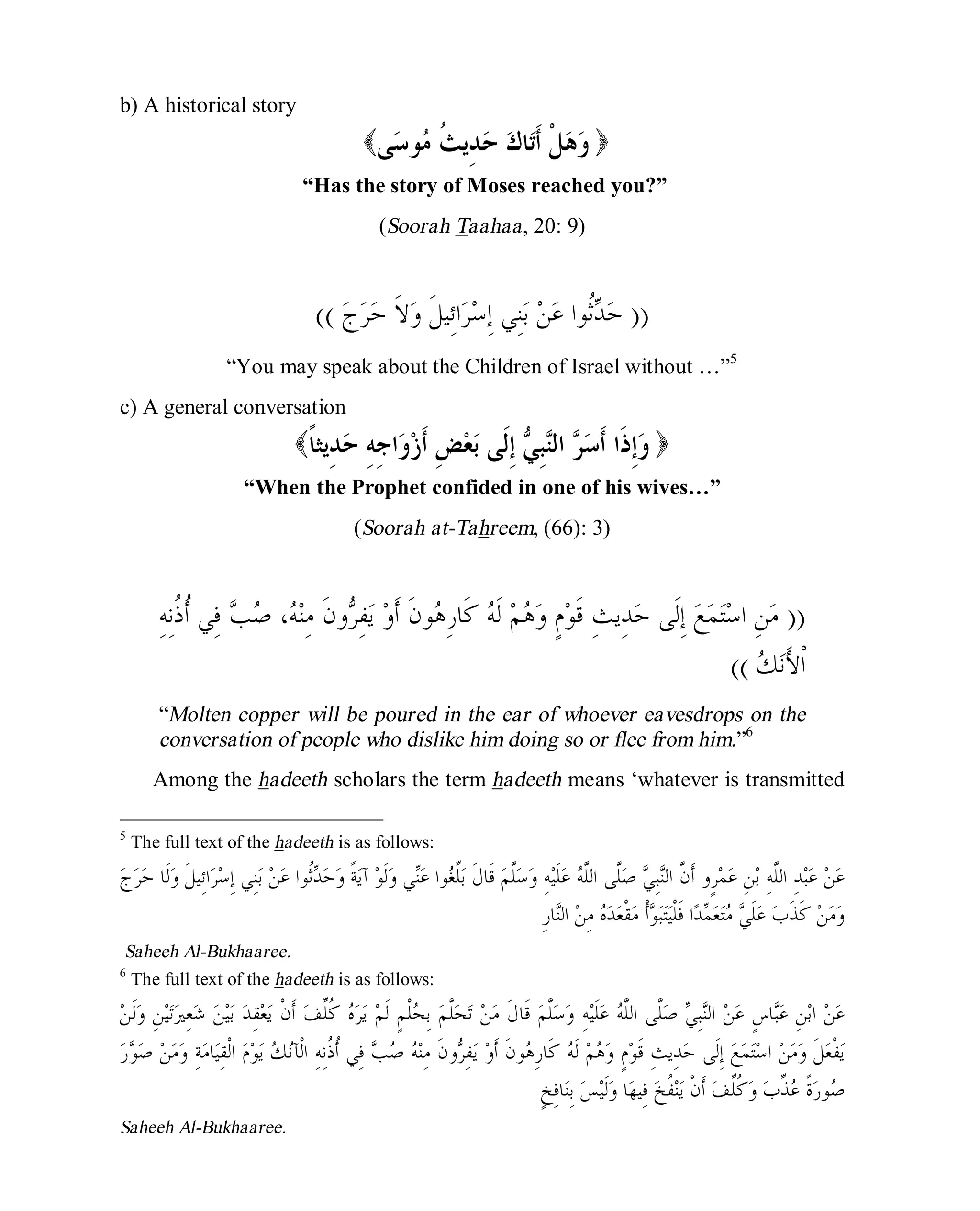
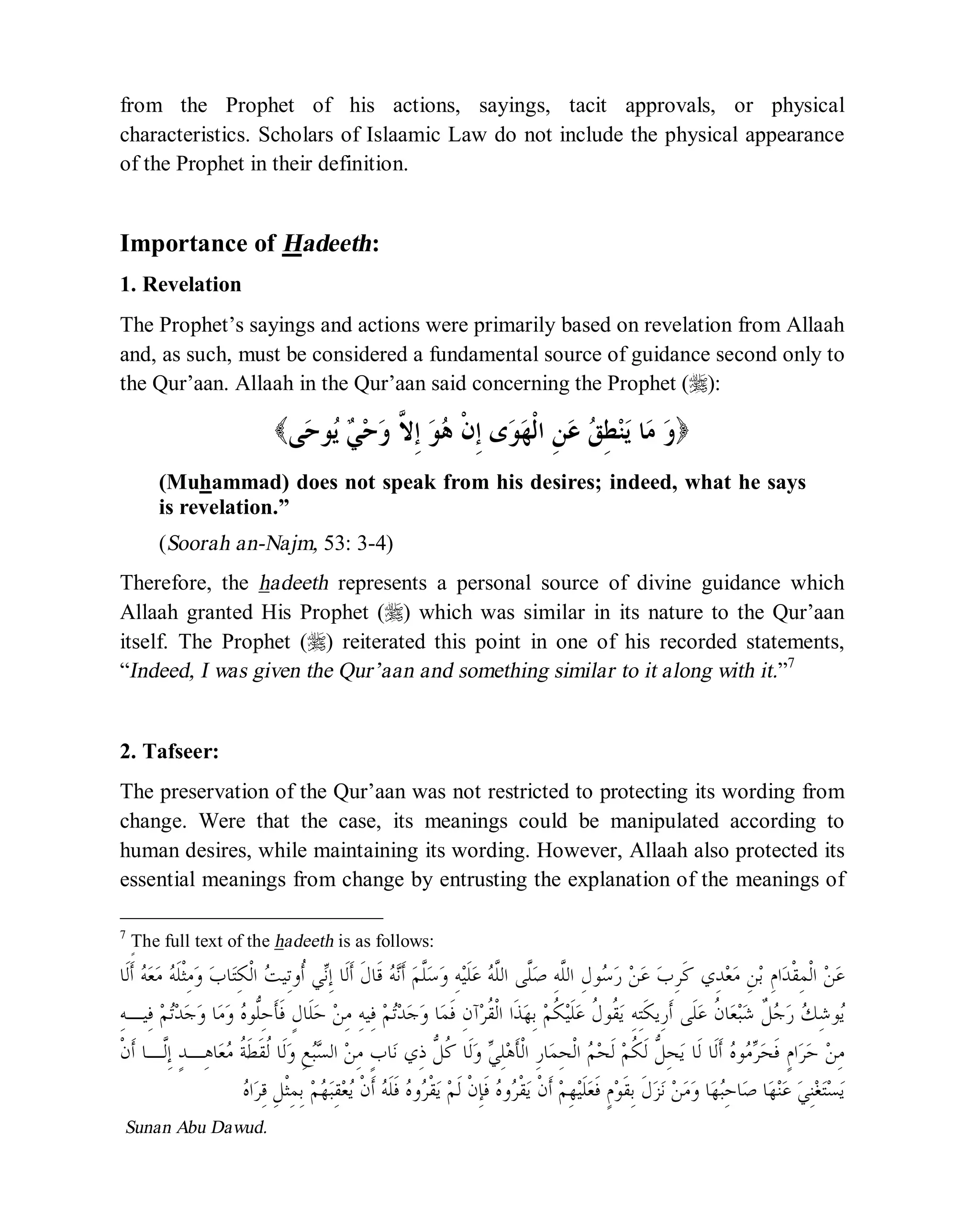
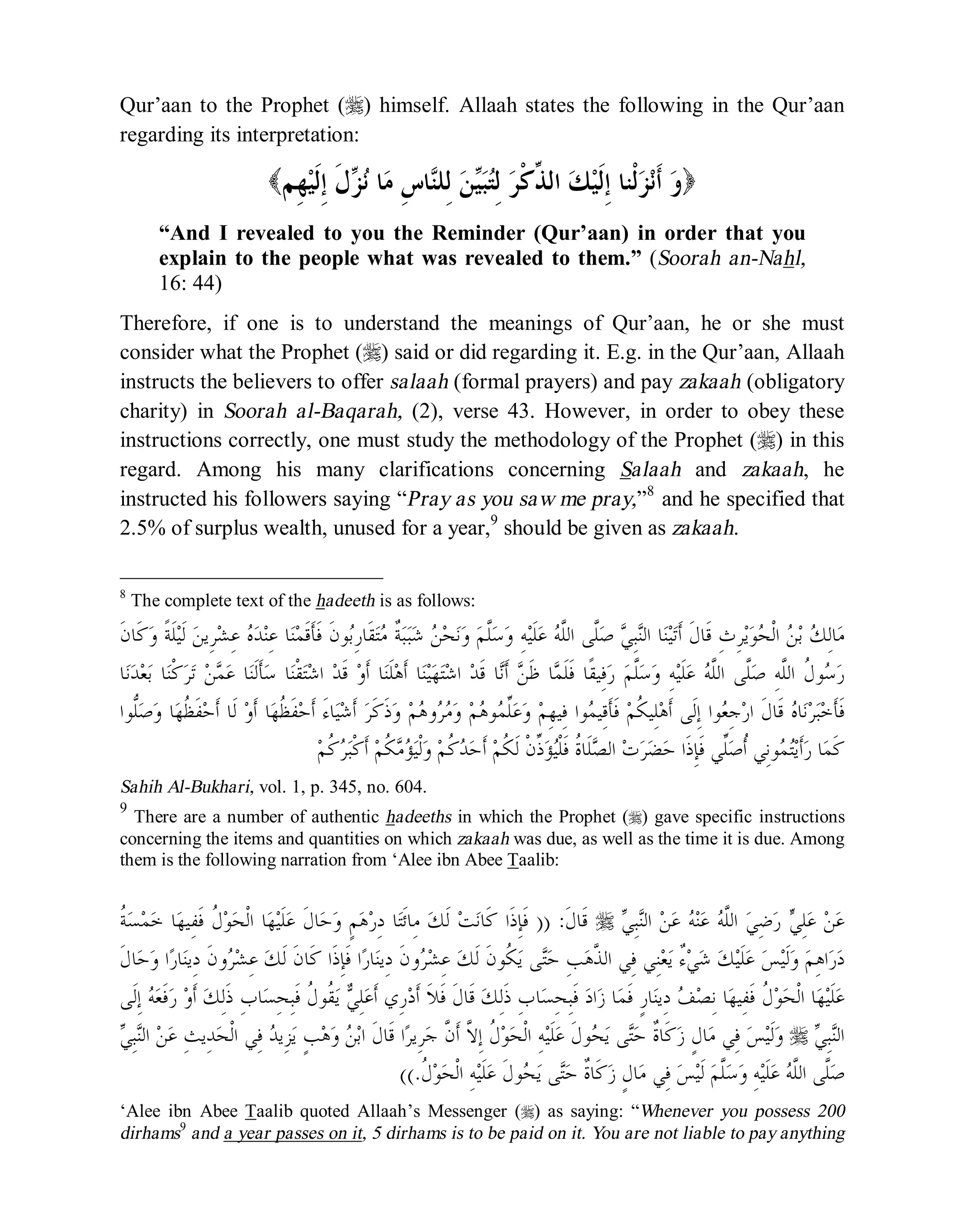



![© Islamic Online University Usool al-Hadeeth 101
http://www.islamiconlineuniversity.com 3
TTWWOO:: Compilation
1. Era of The Prophet
During the life of the Prophet (r) there was no pressing need to write down all of
his various statements or record his actions because he was present and could be
consulted at any time. As a matter of fact, the Prophet (r) himself made a general
prohibition against writing down his statements which were other than the
Qur’aan itself.1
This was to prevent the possibility of mixing up the Qur’aan with
his own words during the era of revelation. Consequently, the greatest stress
regarding writing was placed on recording the Qur’aanic verses. However, there
are many authentic narrations collected by the Scholars of Hadeeth that prove that
Hadeeth were recorded in writing even during the lifetime of the Prophet (r). For
example, ‘Abdullaah ibn ‘Amr said: “I used to write everything which I heard
from the Messenger of Allaah (r) with the intention of memorizing it. However,
some Qurayshites forbade me from doing so saying, ‘Do you write everything
that you hear from him, while the Messenger of Allaah is a human being who
speaks in anger and pleasure?’ So I stopped writing, and mentioned it to the
Messenger of Allah (r). He pointed with his finger to his mouth and said: ‘Write!
By Him in whose hand is my soul, only truth comes out from it.’2
Aboo Hurayrah said: When Makkah was conquered, the Prophet (r) stood
up and gave a sermon [Aboo Hurayrah then mentioned the sermon]. A man from
Yemen, called Aboo Shaah got up and said, “O Messenger of Allaah! Write it
down for me.” The Messenger of Allaah (r) replied, “Write it for Aboo Shaah.”3
Al-Waleed asked Aboo ‘Amr, “What are they writing?” He replied, “The sermon
which he heard that day.”4
Aboo Qaabeel said: We were with ‘Abdullaah ibn ‘Amr ibn al-‘Aas and he
1
Saheeh Muslim, zuhd, 72. This is the only authentic hadeeth on the topic and al-Bukhaaree and
others considered it to be a statement of Aboo Sa‘eed himself that was erroneously attributed to
the Prophet (r). See Studies in Hadith Methodology and Literature, p. 28.
2
Sunan Abu Dawud, vol. 3, p. 1035, no. 3639 and authenticated in Saheeh Sunan Abee Daawood,
no. 3099. The collection of Hadeeth of ‘Abdullaah ibn ‘Amr is known as as-Saheefah as-
Saadiqah.
3
Sunan Abu Dawud, vol. 3, no. 3641 and authenticated in Saheeh Sunan Abee Daawood, no.
3100.
4
Ibid., vol. 3 no. 3642 and authenticated Saheeh Sunan Abee Daawood, no. 3101.](https://image.slidesharecdn.com/usool-al-hadeeth-the-methodology-of-hadith-evaluation-130905043227-/75/Usool-al-hadeeth-the-methodology-of-hadith-evaluation-11-2048.jpg)

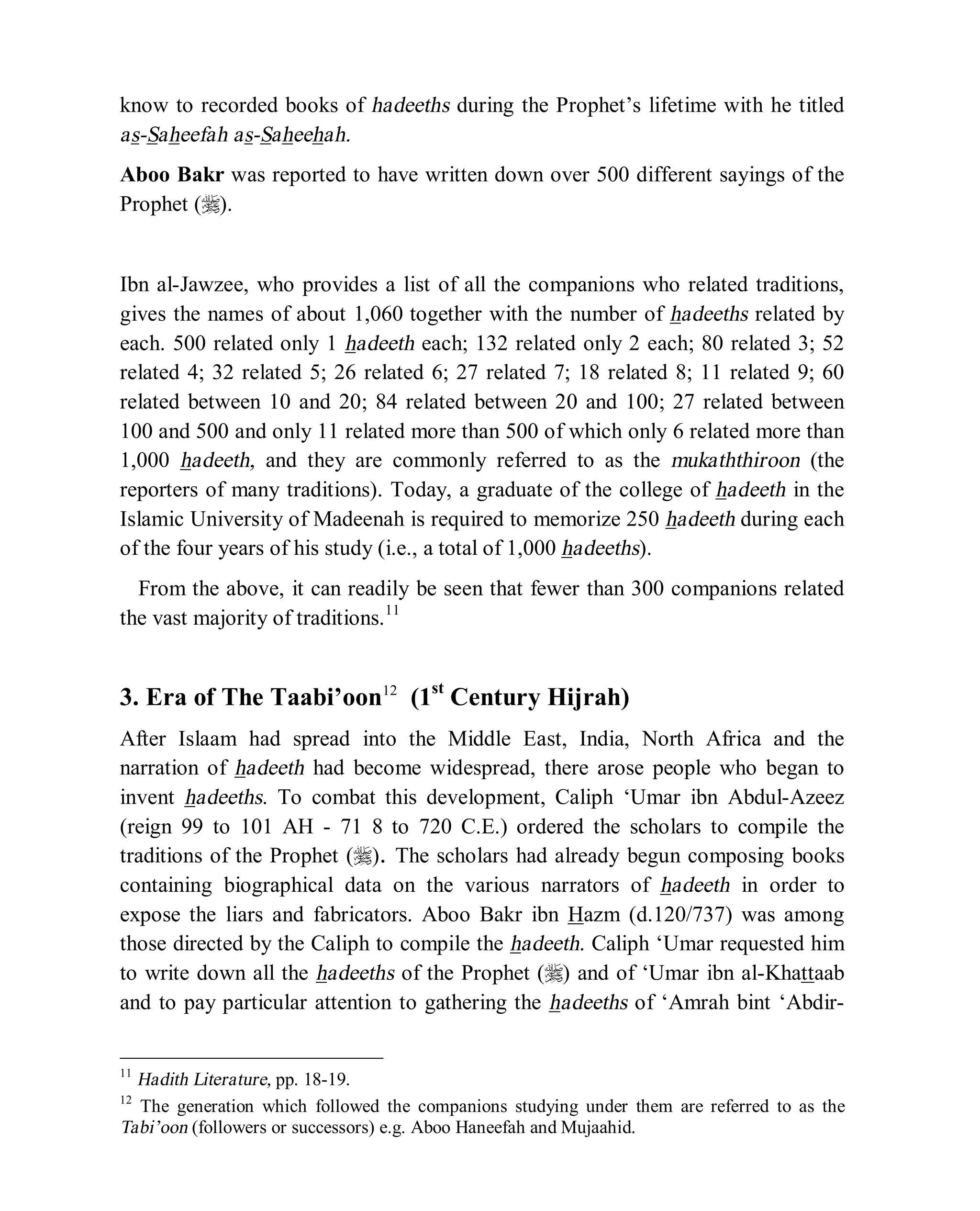
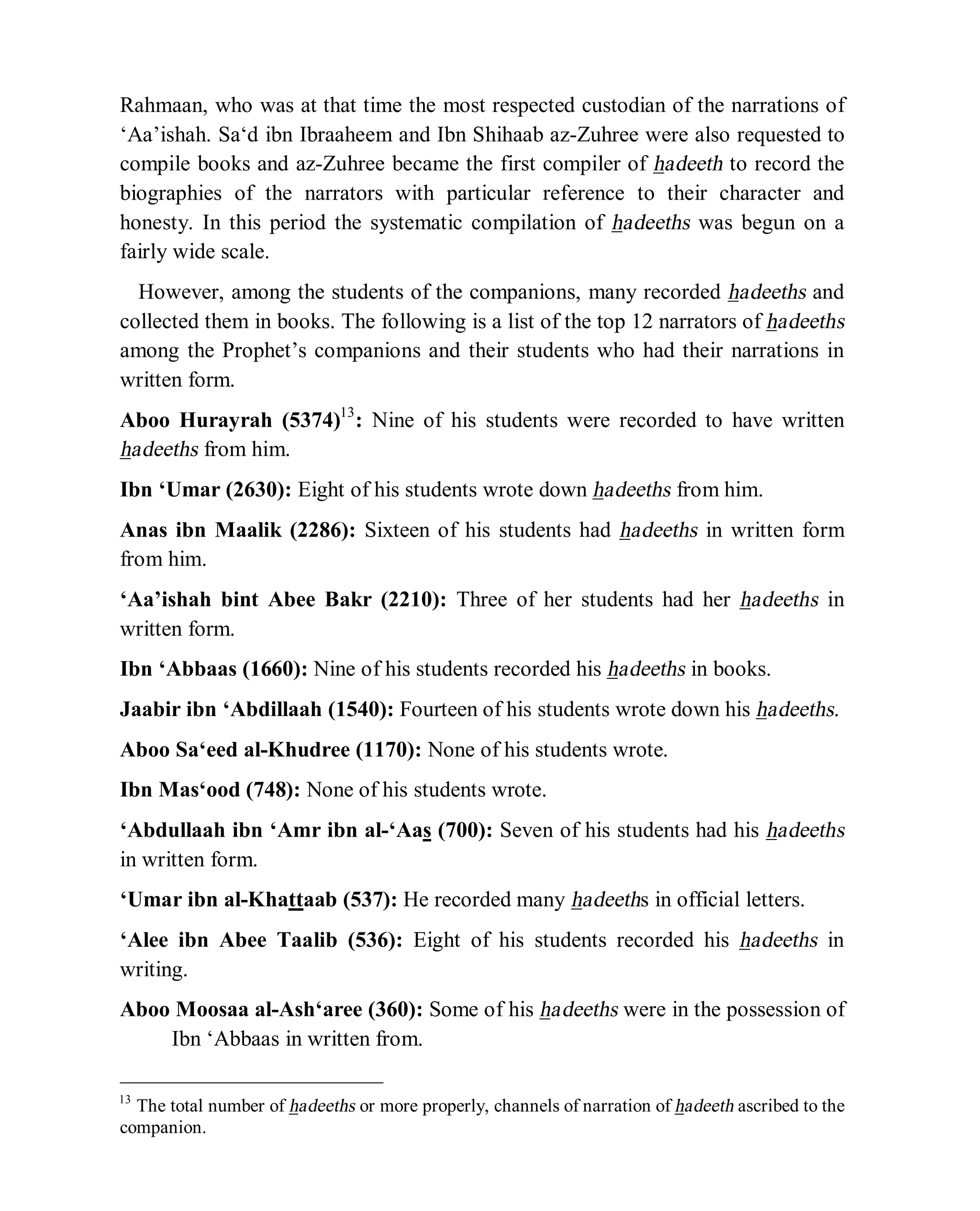
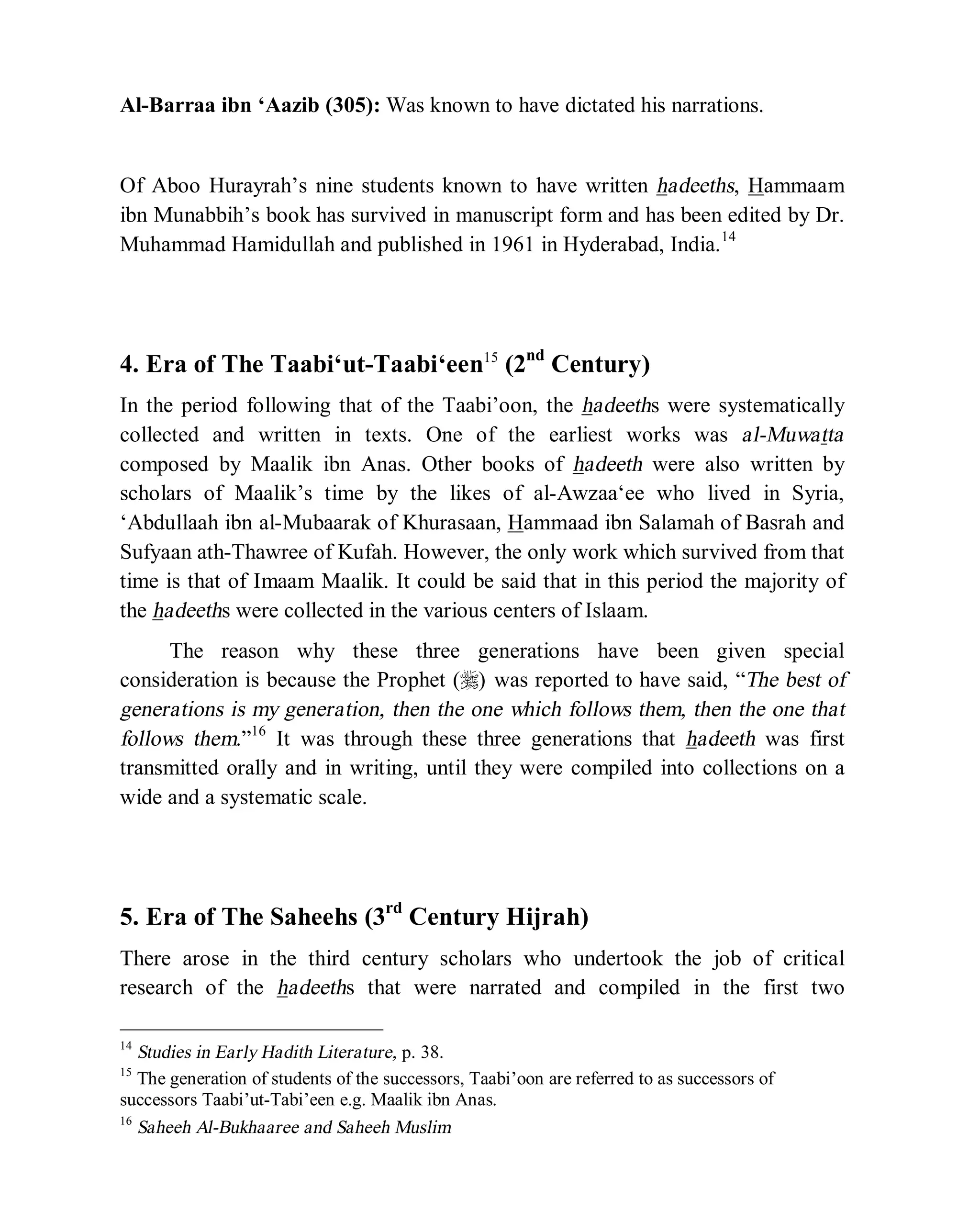



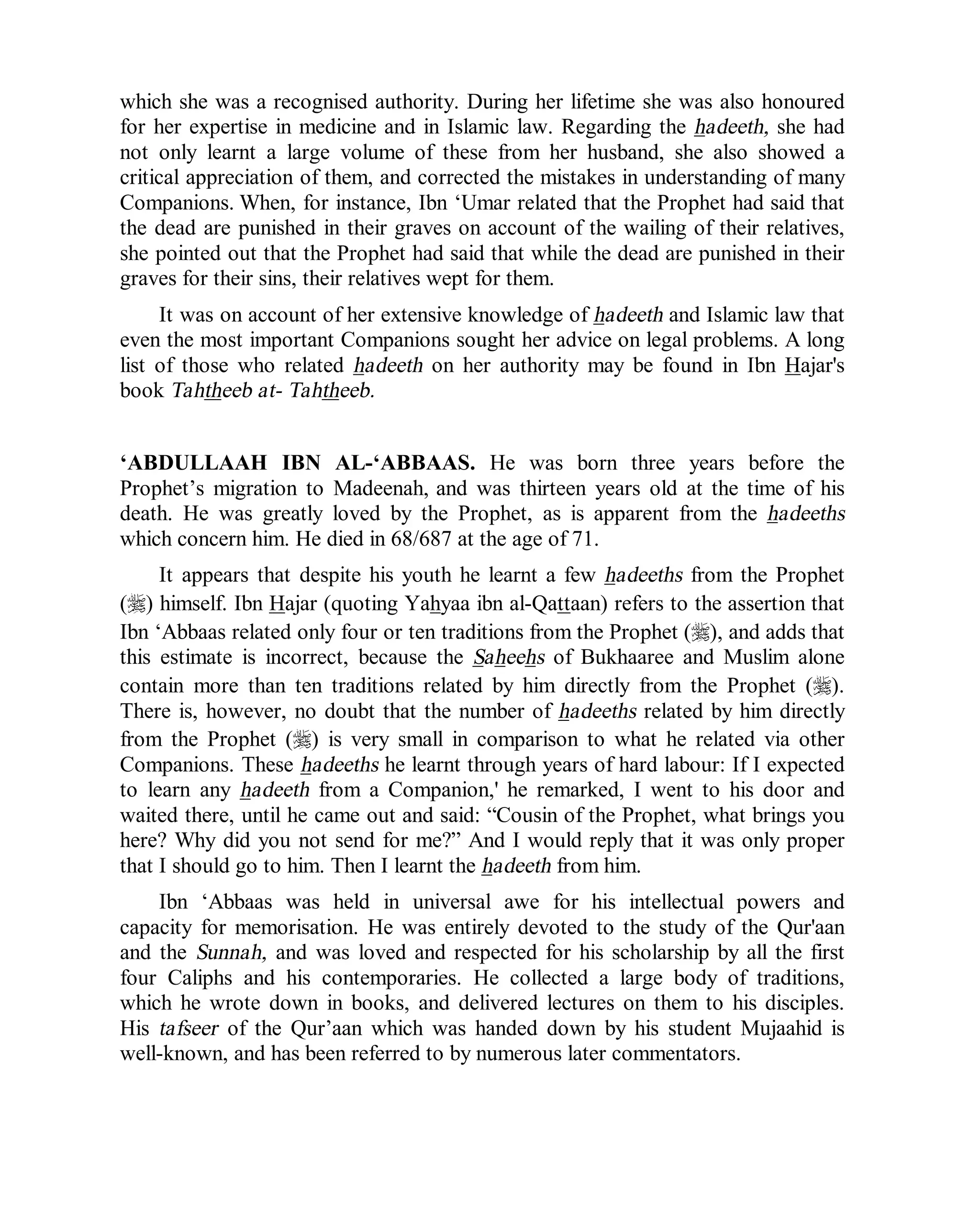





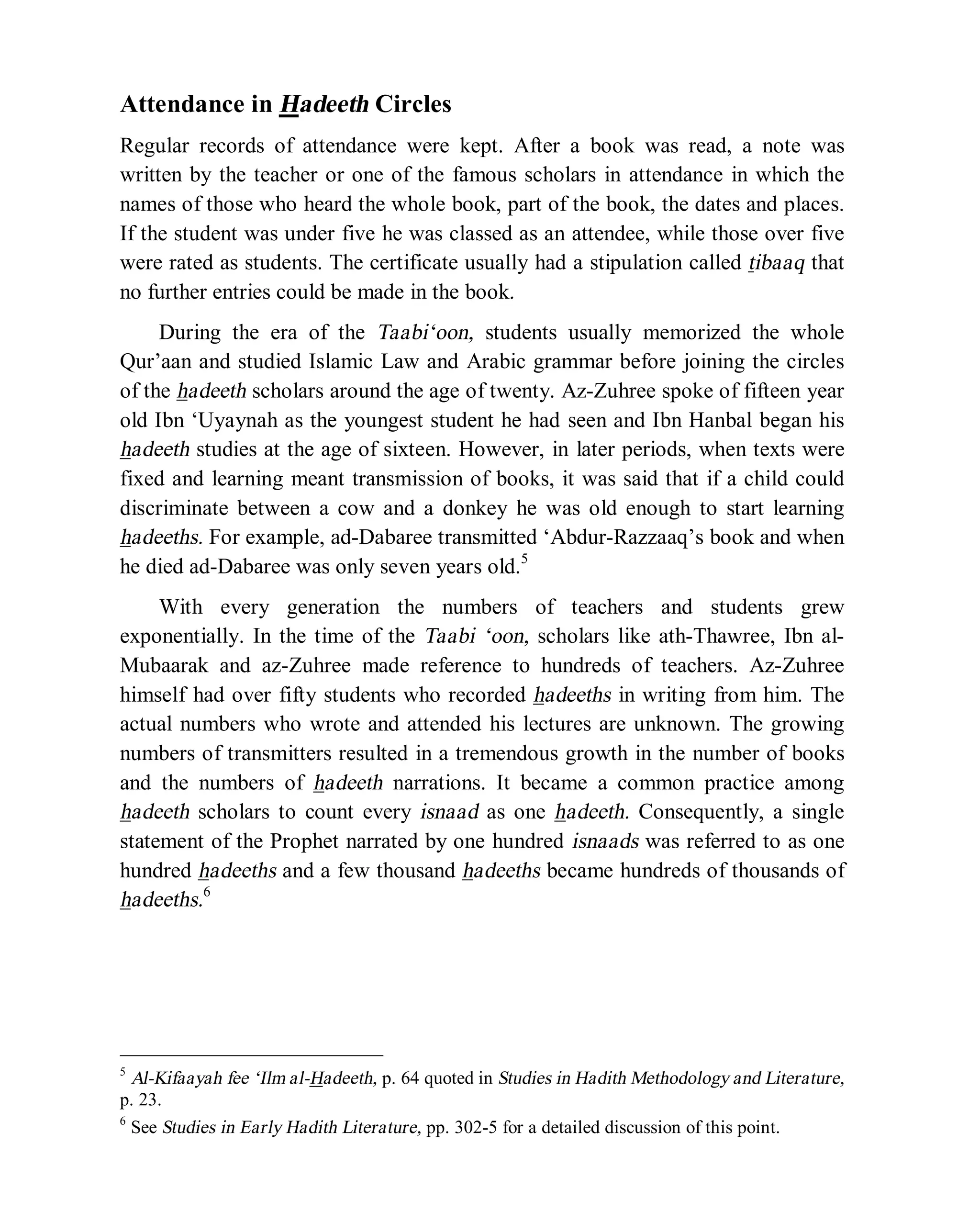
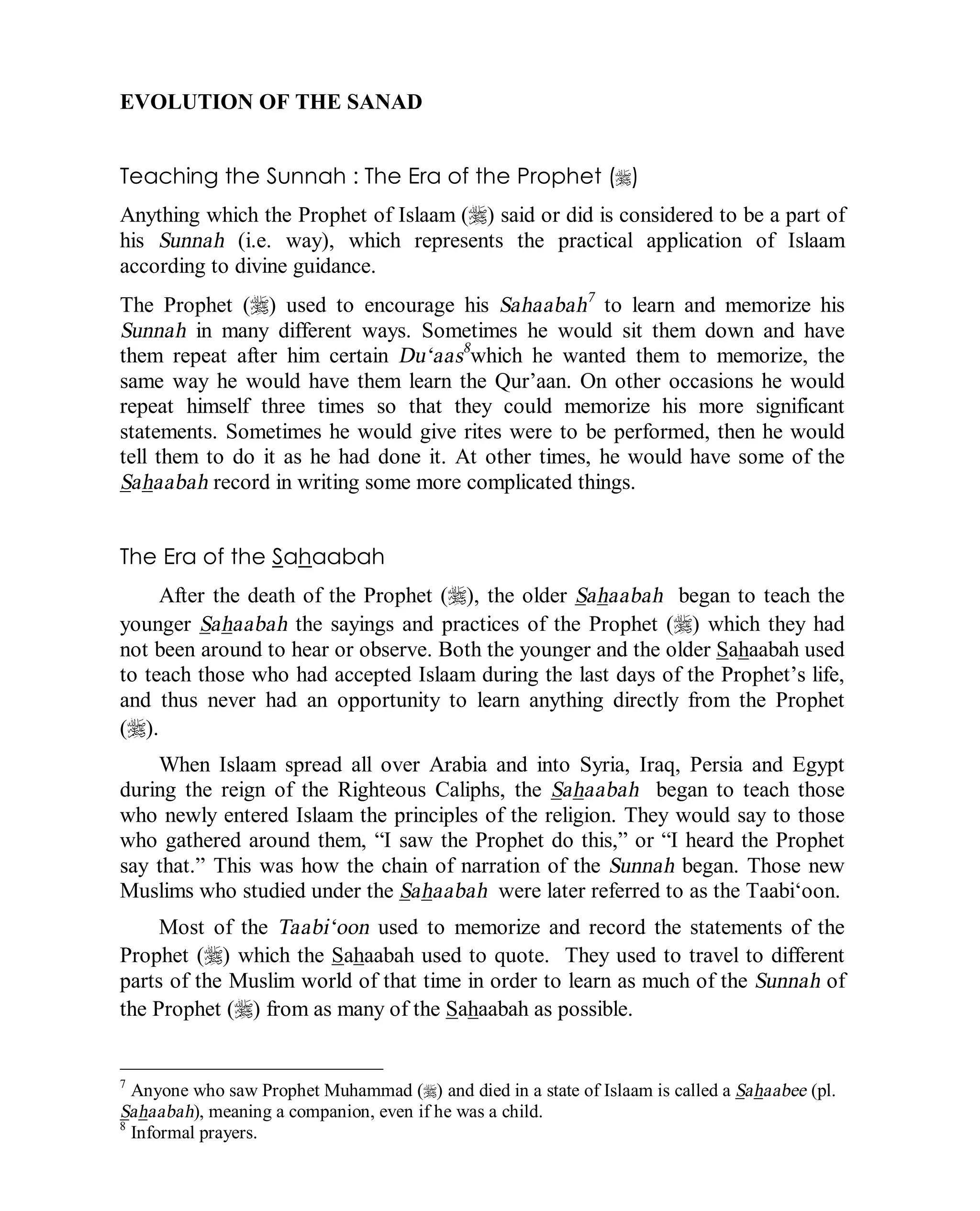
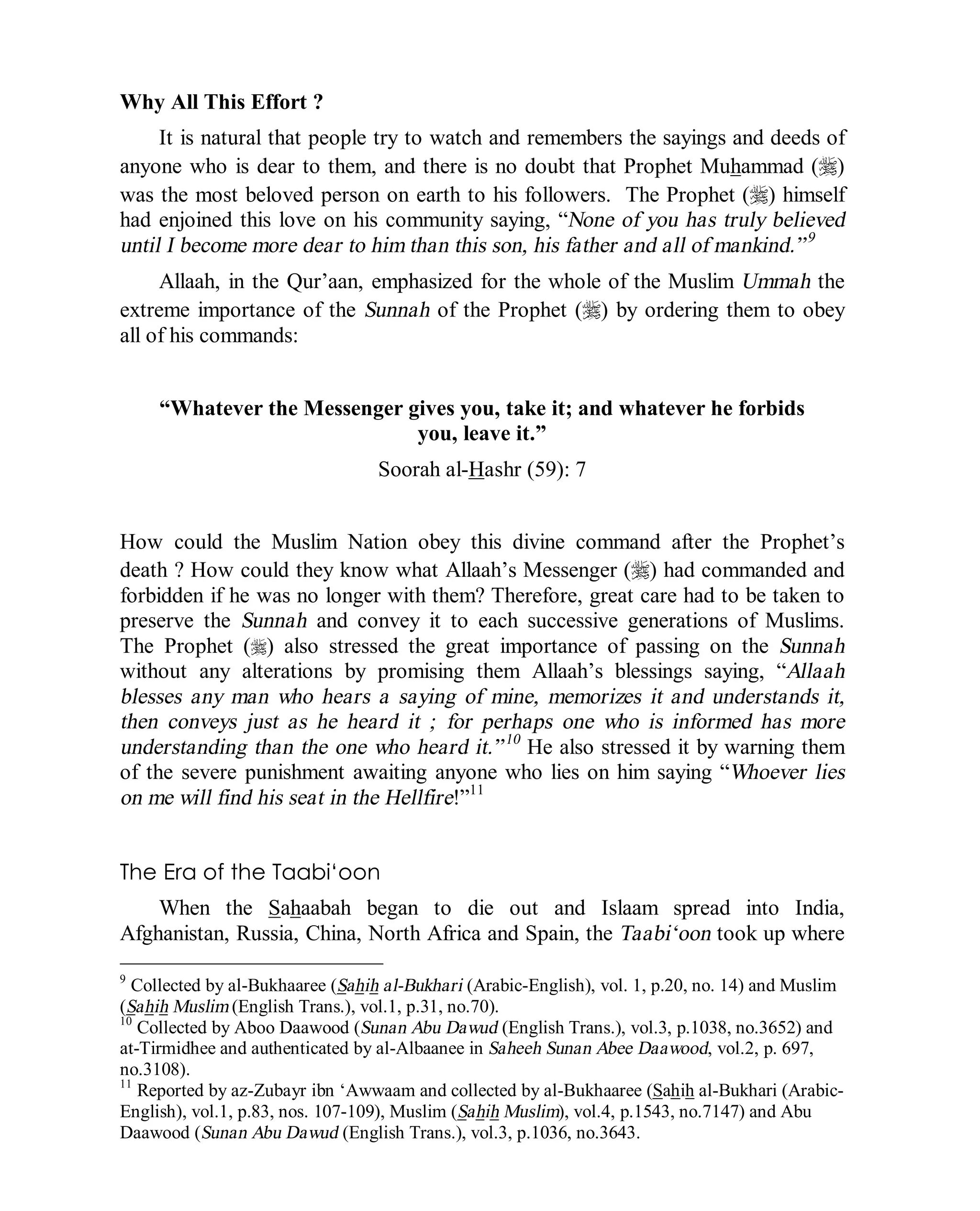



![© Islamic Online University Usool al-Hadeeth 101
http://www.islamiconlineuniversity.com 13
Chains of Transmission
Every hadeeth consists of two sections. The first section is a list of all those who
transmitted the saying of the Prophet (r) beginning with the last transmitter to
the one who collected it in his book and ending with the companion who narrated
it from the Prophet (r). The second section is the narrated saying, action,
approval or physical description of the Prophet (r). The first portion is known as
the isnaad or the sanad (chain of narrators) and the second is called the matn
(text).
For example:
ﺣﻲِﺒﻨﺍﻟ ﱠﻥﹶﺃ ﹶﺓﺮﻳﺮﻫ ِﻲﺑﹶﺃ ﻦﻋ ِﻪِﻴﺑﹶﺃ ﻦﻋ ٍﺢِﻟﺎﺻ ِﻲﺑﹶﺃ ﻦﺑ ﹲﻞﻴﻬﺳ ﹶﻨﺎﺛﺪﺣ ﹶﻝﹶﺎﻗ ِﺭﺎﺘﺨﻤﹾﻟﺍ ﻦﺑ ِﺰﻳﺰﻌﹾﻟﺍ ﺪﺒﻋ ﹶﻨﺎﺛﺪr
ﹶﻗﹶﻝﺎ:ﺟ ﺎﻤﻧِﺇِﻌﹶﻻﻭ ﻭﺍﺮﺒﹶﻜﹶﻓ ﺮﺒﹶﻛ ﹶﺍﺫِﺈﹶﻓ ،ِﻪِﺑ ﻢﺗﺆﻴِﻟ ﻡِﻣﺎﻷﹾﺍ ﹶﻞﹶﻻﻭ ﻮﺍﻌﹶﻛﺭﹶﺎﻓ ﻊﹶﻛﺭ ﹶﺍﺫِﺇﻭ ،ﺮﺒﹶﻜﻳ ﻰﺘﺣ ﻭﺍﺮﺒﹶﻜﺗ
ﹶﻝﹶﺎﻗ ﹶﺍﺫِﺇﻭ ،ﻊﹶﻛﺮﻳ ﻰﺘﺣ ﻮﺍﻌﹶﻛﺮﺗ:ﹸﻮﺍﻟﹸﻮﻘﹶﻓ ،ﻩﺪِﻤﺣ ﻦﻤِﻟ ُﷲﺍ ﻊِﻤﺳ:ﹶﺫِﺇﻭ ،ﺪﻤﺤﹾﻟﺍ ﻚﹶﻟ ﺎﻨﺑﺭ ﻢﻬﱠﻠﺍﻟﺍﺪﺠﺳ
ﺻ ﹶﺍﺫِﺇﻭ ،ﺪﺠﺴﻳ ﻰﺘﺣ ﻭﺍﺪﺠﺴﺗ ﹶﻻﻭ ﻭﺍﺪﺠﺳﹶﺎﻓﹰﺍﺩﻮﻌﹸﻗ ﱡﻮﺍﻠﺼﹶﻓ ﹰﺍِﺪﻋﹶﺎﻗ ﱠﻰﻠﺻ ﹶﺍﺫِﺇﻭ ،ﺎﻣﺎﻴِﻗ ﱡﻮﺍﻠﺼﹶﻓ ﺎﻤِﺋﹶﺎﻗ ﱠﻰﻠ
ﲔِﻌﻤﺟﹶﺃ.
‘Abdul-‘Azeez ibn al-Mukhtaar told us, saying: Suhayl ibn Abee Saalih informed
us from his father from Aboo Hurayrah that the Prophet (r) said: “The Imaam
was appointed to be followed. So when he says : Allaahu Akbar (Allaah is
Greater), say Allaahu Akbar. But do not say it until he has said it. And bow when
he bows, but don’t bow until he bows. And when he says: Sami ‘allaahu liman
hamidah (Allaah hears those who praise Him), say: Allaahumma rabbanaa lakal-
hamd (O Allaah, our Lord, all praise is Yours. ). And when he prostrates, do so,
but don’t do so before he does so. And if he prays standing, do so and if he prays
sitting you should all pray sitting.”14
In the above-mentioned hadeeth, [‘Abdul-‘Azeez ibn al-Mukhtaar told us, saying:
Suhayl ibn Abee Saalih informed us from his father from Aboo Hurayrah that the
Prophet (r) said:] is the isnaad and the remainder [“The Imaam was appointed to
be followed. So when he says: Allaahu Akbar (Allaah is Greater), say Allaahu
Akbar … and if he prays sitting you should all pray sitting.”] is the matn.
14
Sunan Abu Dawud, Saheeh Al Bukhaaree, Saheeh Muslim](https://image.slidesharecdn.com/usool-al-hadeeth-the-methodology-of-hadith-evaluation-130905043227-/75/Usool-al-hadeeth-the-methodology-of-hadith-evaluation-31-2048.jpg)
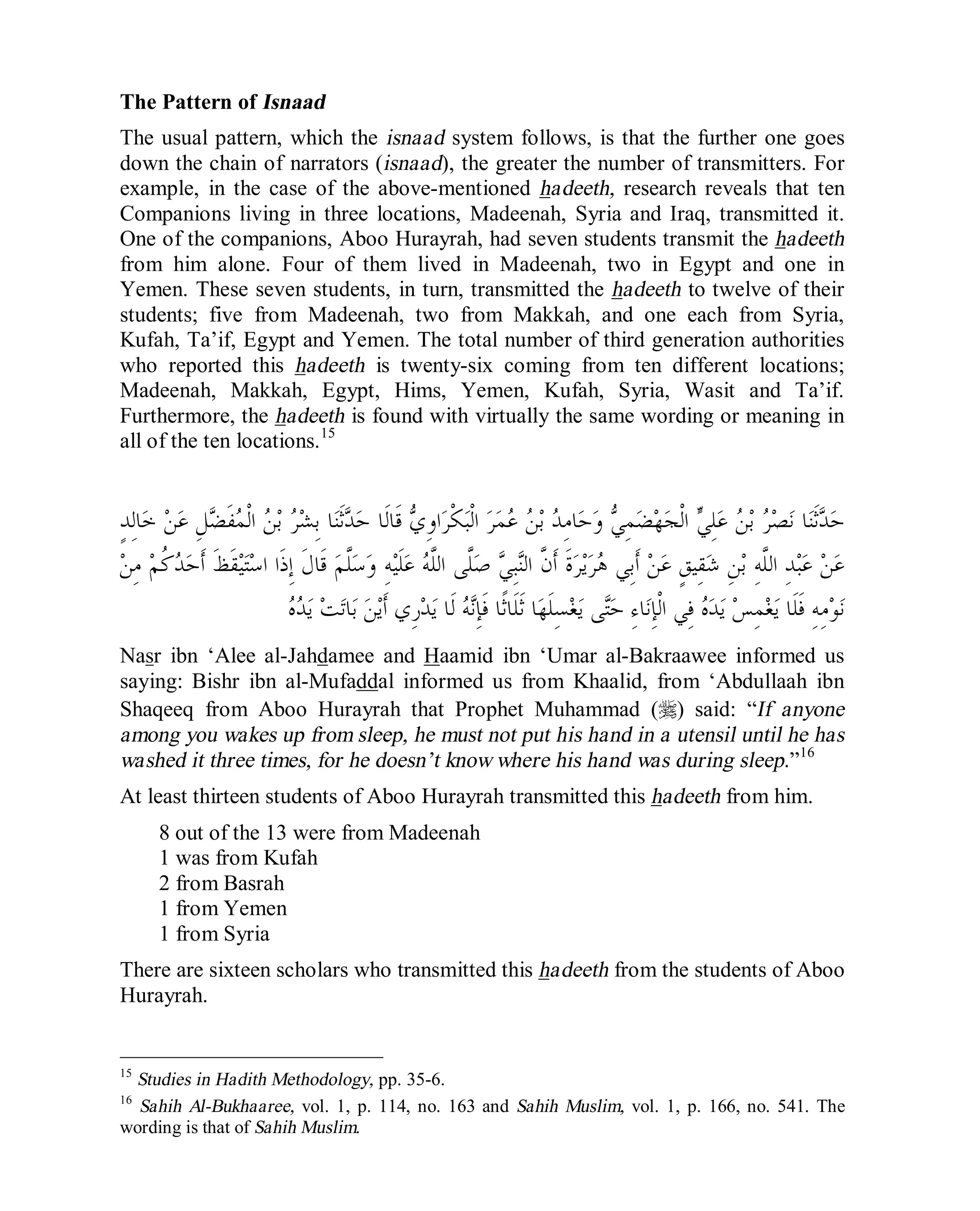


![© Islamic Online University Usool al-Hadeeth 101
http://www.islamiconlineuniversity.com 17
Origins of the Isnaad System
Every type of literature develops certain features particular to its nature and
content and the character of the people who cultivate it, and the distinctive social,
political or historical conditions in which it originates and flourishes. Hadeeth
literature is no exception to this rule.17
The isnaad system was used to transmit
pre-Islamic poetry.18
However, it was in the hadeeth literature that it reached its
peak at which it was considered an integral part of the religion itself. ‘Abdullaah
ibn al-Mubaarak (d. 181AH), one of the illustrious teachers of Imaam al-
Bukhaaree, said: “The isnaad is from the religion. Were it not for the isnaad
anyone could say anything he wished.”19
By the end of the first century the
science of isnaad was fully developed. Ibn Seereen (d. 110), a Successor, said,
“[In the beginning] they would not ask about the isnaad. But when the fitnah
(turmoil / civil war) happened, they demanded, ‘Name your men to us.’ The
narrations of the Ahlus-Sunnah (Adherents to the Sunnah) would be accepted,
while those of Ahlul-Bid‘ah (Adherents to Innovations) would be rejected.”20
That
is, prior to the turmoil the isnaad was used only occasionally, but after the turmoil
they became cautious.
In order to minimize the significance of the system in Islaam, orientalist
scholars have tried to identify non-Arab pre-Islamic sources. Joseph Horovitz
cited several instances from Jewish literature in which the isnaad was used before
its use among Arabs.21
He further tried to trace its usage back to the Mosaic
period, and by Talmudic times its chain assumed enormous length. Whether the
isnaad system really goes back to Mosaic times is open to doubt, as Horovitz did
not prove that they were not later interpolations. It has also been noted that
Indians long before Islaam used the isnaad system. Occasional use can be found
in ancient Hindu, Buddhist and Jain literature. For example, in the great epic, the
Mahabharta, it states:
17
Hadith Literature, p. 76.
18
Masaadir ash-Shi‘r al-Jaahilee, pp. 255-267 quoted in Studies in Hadith Methodology, p. 32.
19
Related by Imaam Muslim in the introduction Saheeh Muslim (ed. M.F. ‘Abdul Baqi. 5 vols.,
Cairo 1374/1955), [1:15] & Saheeh al-Muslim bi Sharh an-Nawawi (18 vols. in 6, Cairo, 1349)
[1:87].)
20
Saheeh Muslim bi Sharh an-Nawawi (Introduction) Chapter: The Isnaad is from the Deen,
p.257 [Maktabah Nazaar Mustafa al-Baaz - Riyadh [1st edition])
21
Mishna, the fathers, 446.](https://image.slidesharecdn.com/usool-al-hadeeth-the-methodology-of-hadith-evaluation-130905043227-/75/Usool-al-hadeeth-the-methodology-of-hadith-evaluation-35-2048.jpg)
![© Islamic Online University Usool al-Hadeeth 101
http://www.islamiconlineuniversity.com 18
Vysda composed it, Ganesa served as a scribe, and the work was handed down
by Vaisampayana, who communicated it to the king Janamejaya. Sauti, who
was present at the time, heard it and narrated it to the assembly of sages.22
However, regardless of where the isnaad originated, there is no doubt that having
adopted the system, Muslims came to consider the isnaad an indispensable part of
the hadeeths and developed it. They gave it a firm foundation by introducing the
chronological method, assembling biographies of the transmitters, and
establishing a science for determining the value of its contents and the
authenticity of its channel of transmission. The ancient Indians, as far as is
known, never made any attempt at a rigorous and consistent treatment of the
isnaad, nor did they develop the chronological method. Likewise, Jewish
literature had no usage of the chronological method thereby rendering their
isnaads valueless. In fact, Professor Horovitz, himself, admitted that, ‘In the
Talmudic literature there is no idea of chronological method, and the oldest extant
work attempting such an arrangement was composed after 885 AD – more than a
century later than the earliest Islamic work on isnaad-critique. From this fact,’ he
goes on to say, ‘and from the fact that the important Jewish works [of this period]
had been composed in the Islamic dominions, it may be inferred that this
historical interest was due to the Islamic influence.’23
The practice of specifying the isnaad, not only of the hadeeths but also the
books in which they were collected, was of immense value in preserving the
integrity of books in an age in which printing was unknown, and the creation of
spurious and distorted works was a relatively easy task. The scholarly practice of
certification seems to be unique in the world’s literary history, just as hadeeth
literature is unique in employing a thorough and systematic method of source
identification. Greek, Latin, Hebrew and Syriac manuscripts rarely, if ever, supply
us with such a wealth of information about a book’s origin and use.
The isnaad system, while originating in connection with the hadeeth
literature, was in due course extended by Arab authors to many other genres,
including geography, history, and prose fiction.24
22
Mahabharata, Book I, canto 1; cf. Winternitz, History of Indian Literature (Calcutta, 1927CE),
I, 323 quoted in Hadith Literature, pp. 78-9.
23
Alter und Ursprund des Isnad, 47. Quoted in Hadith Literature, p. 81.
24
Hadith Literature, p. 82-3.](https://image.slidesharecdn.com/usool-al-hadeeth-the-methodology-of-hadith-evaluation-130905043227-/75/Usool-al-hadeeth-the-methodology-of-hadith-evaluation-36-2048.jpg)
![© Islamic Online University Usool al-Hadeeth 101
http://www.islamiconlineuniversity.com 3
FFOOUURR:: Classification
Due to a variety of factors, the narration of hadeeths came under careful scrutiny
beginning with the generation of the Companions and their students. The
statement of the Taabi‘ee, Ibn Seereen (d. 110), in the previous chapter identifies
the approximate time period in which verification began.
He said, “[In the beginning] they would not ask about the isnaad. But
when the fitnah (civil war) happened, they demanded, ‘Name your men
to us.’ The narrations of the Ahlus-Sunnah would be accepted, while
those of Ahlul-Bid‘ah would be rejected.”1
Once the name of the narrator was known, it was possible to investigate whether
he was trustworthy or not and whether he actually heard the person from whom he
was reporting. Criticism of this nature later came to be known as ‘Ilm al-Jarh
wat-Ta‘deel (The Science of Validation).
The earliest recorded comments made for this purpose were reported by
Shu‘bah ibn al-Hajjaaj (701-776 CE). Ibn ‘Adee reported with his isnaad going
back to ‘Abdur-Rahmaan ibn al-Mahdee who said: “Once they differed in the
presence of Shu‘bah and said: O Aboo Bistaam, appoint a judge between you and
us.” He replied: “I agree to appoint al-Ahwal (Yahyaa ibn Sa‘eed al-Qattaan).”
After a short while, he came. So they referred the issue to him and he gave his
judgement against Shu‘bah. Shu‘bah remarked: “Who else has the ability to
examine (tanqud) like you?”2
The term used by Shu‘bah was a form of the verb
naqada which means ‘to examine or test’. Yahyaa ibn Sa‘eed (d. 804) was also
the earliest of those whose comments were recorded. Ibn Shihaab az-Zuhree, as
was earlier mentioned, was the first to record biographical material about the
hadeeth narrators along with the narrations themselves.
From these early efforts the science of hadeeth (‘Ilm Mustlah al-Hadeeth or
‘Ilm Usool al-Hadeeth) evolved to distinguish between authentic narrations and
spurious or fabricated ones. The scholars of hadeeth have dealt with each hadeeth
as an independent case, subjecting both its isnaad and its matn to close scrutiny
according to the fundamental principles of this science.3
Although the rules and criteria governing the study of hadeeth were
meticulous in the early generations, there was considerable variation in their
1
Saheeh Muslim bi Sharh an-Nawawi (Introduction) Chapter: The Isnaad is from
the Deen, p.257 [Maktabah Nazaar Mustafa al-Baaz - Riyadh [1st edition])
2
Muqaddimah al-Kaamil, p. 120.
3
Criticism of Hadith, pp. 34-5.](https://image.slidesharecdn.com/usool-al-hadeeth-the-methodology-of-hadith-evaluation-130905043227-/75/Usool-al-hadeeth-the-methodology-of-hadith-evaluation-37-2048.jpg)



![© Islamic Online University Usool al-Hadeeth 101
http://www.islamiconlineuniversity.com 7
Saheeh li Ghayrih
The hadeeth saheeh may be further subdivided into Saheeh li Thaatih and Saheeh
li Ghayrih. Hadeeths fulfilling the five conditions completely were also referred
to as Saheeh li Thaatih. That is, it is saheeh by itself, without any external
considerations. The Saheeh li Ghayrih is a hadeeth hasan that has been elevated
to the status of saheeh due to supporting narrations.
The following is an example of a Saheeh li Ghayrih narration found in Sunan
Abee Daawood:
ﹶﻝﹶﺎﻗ ﹶﺓﺮﻳﺮﻫ ِﻲﺑﹶﺃ ﻦﻋ ﹶﺔﻤﹶﻠﺳ ِﻲﺑﹶﺃ ﻦﻋ ٍﻭﺮﻤﻋ ِﻦﺑ ِﺪﻤﺤﻣ ﻦﻋ ﹶﻥﺎﻤﻴﹶﻠﺳ ﻦﺑ ﹸﺓﺪﺒﻋ ﺎﻨﹶﺛﺪﺣ ٍﺐﻳﺮﹸﻛ ﻮﺑﹶﺃ ﺎﻨﹶﺛﺪﺣ
ﻢﱠﻠﺳﻭ ِﻪﻴﹶﻠﻋ ﻪﱠﻠﺍﻟ ﱠﻰﻠﺻ ِﻪﱠﻠﺍﻟ ﹸﻝﻮﺳﺭ ﹶﻝﹶﺎﻗ)) :ﹶﺎﻟﻮﹶﻟٍﺓﹶﺎﻠﺻ ﱢﻞﹸﻛ ﺪﻨِﻋ ِﻙﺍﻮﺴِﺎﻟﺑ ﻢﻬﺗﺮﻣﹶﺄﹶﻟ ِﻲﺘﻣﹸﺃ ﹶﻰﻠﻋ ﻖﺷﹶﺃ ﹾﻥﹶﺃ
((
Aboo Kurayb informed us from ‘Abdah ibn Sulaymaan who informed them from
Muhammad ibn ‘Amr from Aboo Salamah from Aboo Hurayrah who quoted
Allaah’s Messenger (r) as saying: “Were it not that I would place a great burden
on my nation, I would have ordered them to use the miswak at the time of every
salaah.”8
Ibn Salaah stated that that Muhammad ibn ‘Amr ibn ‘Alqamah was well-
known for his truthfulness and integrity, but he was considered inaccurate
(Sadooq lahu Awhaam). Aboo Daawood stated at the end of the above-mentioned
narration: Aboo ‘Eesaa [at-Tirmithee] said: “This hadeeth has been narrated by
Muhammad ibn Is’haaq from Muhammad ibn Ibraaheem from Aboo Salamah
from Zayd ibn Khaalid from the Prophet (r) and the hadeeth of Aboo Salamah
from Aboo Hurayrah and Zayd ibn Khaalid from the Prophet (r) are both saheeh
in my opinion because this hadeeth has been narrated through more than one
channel from Aboo Hurayrah from the Prophet (r)… As for Muhammad ibn
Ismaa‘eel [al-Bukhaaree], he claimed the hadeeth of Aboo Salamah from Zayd
ibn Khaalid is more authentic. Aboo ‘Eesaa said: “On this topic [there are other
narrations] by Aboo Bakr as-Siddeeq, ‘Alee, ‘Aa’ishah, Ibn ‘Abbaas, Huthayfah,
Zayd ibn Khaalid, Anas, ‘Abdullaah ibn ‘Amr, Ibn ‘Umar, Umm Habeebah, Aboo
Umaamah, Aboo Ayyoob, Tammaam ibn ‘Abbaas, ‘Abdullaah ibn Hanzalah,
Umm Salamah, Waathilah ibn al-Asqa‘ and Aboo Moosaa.9
8
Sunan Abu Dawud, kitaab at-Tahaarah, baab: maa jaa fee as-siwaak.
9
There are 3 narrations in Sahih Al-Bukhari, Kitaab al-Jumu’ah Baab: Siwaak Yawm al-Jumu’ah
and one in Sahih Muslim, Kitaab at-Tahaarah Baab: Siwaak.](https://image.slidesharecdn.com/usool-al-hadeeth-the-methodology-of-hadith-evaluation-130905043227-/75/Usool-al-hadeeth-the-methodology-of-hadith-evaluation-41-2048.jpg)
![© Islamic Online University Usool al-Hadeeth 101
http://www.islamiconlineuniversity.com 8
Grades of Saheeh
The most correct view is that it cannot be absolutely claimed that any particular
chain of narrators is superior to any other saheeh narration. The actual grades of
authenticity depend on how the chain and text is influenced by the five conditions
for authenticity. For example, the lowest level of authentic narrations would be
those hadeeths which have transmitters whose accuracy is disputed. However,
proof in favor of their reliability is overwhelming. For example, the narration of
Suhail ibn Abee Saalih from his father from Aboo Hurayrah.
In spite of that fact, some scholars traditionally considered certain chains of
narration to be of the highest grade. For example, Ahmad ibn Hambal and Is’haaq
ibn Raahawayh considered: “Zuhree from Saalim from his father, ‘Abdullaah ibn
‘Umar,” to be the strongest chain. On the other hand, al-Bukhaaree considered:
“Maalik from Naafi‘ from ‘Abdullaah ibn ‘Umar,” to be the strongest.10
It came
to be known as the “golden chain”.
With regard to the hadeeth saheeh, it cannot be said that they are all found in
the books of al-Bukhaare and Muslim because these scholars themselves
confirmed that they did not gather all of the hadeeth saheeh. Al-Bukhaaree stated:
“I only wrote in my book, al-Jaami‘, what was authentic and I omitted some
authentic narrations to avoid it becoming too long.” Imaam Muslim also said: “I
did not include in this book every hadeeth I found to be saheeh. I only put in it
what the scholars agreed upon.” In fact the majority of authentic hadeeths are
found outside of these two compilations. Imaam al-Bukhaaree himself stated:
“And the authentic hadeeths which I have omitted are more than I have included
[in my book].” He also stated: “I memorized 100,000 authentic hadeeths and
200,000 inauthentic hadeeths.” And the total number of hadeeths in Saheeh al-
Bukhaaree is around 4,000 and in Saheeh Muslim is also around 4,000!11
The hadeeths may be graded according to criteria used by Imaams al-
Bukhaaree and Muslim which were considered to be of the highest standard.
1. Authentic hadeeths recorded by both al-Bukhaaree and Muslim. Such
narrations are often referred to by scholars as ﻪﻴﹶﻠﻋ ﻖﹶﻔﺘﻣ muttaqun ‘alayh
(agreed upon).
2. Authentic hadeeths recorded by only al-Bukhaaree.
3. Authentic hadeeths recorded by only Muslim.
4. Authentic hadeeths according to the criteria of al-Bukhaaree and Muslim
10
The Science of Authenticating the Prophet’s Traditions, p. 38.
11
The Science of Authenticating the Prophet’s Traditions, pp. 39-40](https://image.slidesharecdn.com/usool-al-hadeeth-the-methodology-of-hadith-evaluation-130905043227-/75/Usool-al-hadeeth-the-methodology-of-hadith-evaluation-42-2048.jpg)

![© Islamic Online University Usool al-Hadeeth 101
http://www.islamiconlineuniversity.com 10
ﻰﺳﻮﻣ ِﻲﺑﹶﺃ ِﻦﺑ ِﺮﹾﻜﺑ ِﻲﺑﹶﺃ ﻦﻋ ﻲِﻧﻮﺠﹾﻟﺍ ﹶﻥﺍﺮﻤِﻋ ِﻲﺑﹶﺃ ﻦﻋ ﻲِﻌﺒﻀﺍﻟ ﹶﻥﺎﻤﻴﹶﻠﺳ ﻦﺑ ﺮﹶﻔﻌﺟ ﺎﻨﹶﺛﺪﺣ ﹸﺔﺒﻴﺘﹸﻗ ﺎﻨﹶﺛﺪﺣ
ﺳﻭ ِﻪﻴﹶﻠﻋ ﻪﱠﻠﺍﻟ ﱠﻰﻠﺻ ِﻪﱠﻠﺍﻟ ﹸﻝﻮﺳﺭ ﹶﻝﹶﺎﻗ ﹸﻝﹸﻮﻘﻳ ﻭﺪﻌﹾﻟﺍ ِﺓﺮﻀﺤِﺑ ِﻲﺑﹶﺃ ﺖﻌِﻤﺳ ﹶﺎﻝﻗ ﻱِﺮﻌﺷﹶﺄﹾﻟﺍﺏﺍﻮﺑﹶﺃ ﱠﻥِﺇ ﻢﱠﻠ
ِﻑﻮﻴﺴﺍﻟ ِﻝﹶﺎﻠِﻇ ﺖﺤﺗ ِﺔﻨﺠﹾﻟﺍ...ﺐِﻳﺮﹶﻏ ﻦﺴﺣ ﹲﺚِﻳﺪﺣ ﹶﺍﺬﻫ ﻰﺴِﻴﻋ ﻮﺑﹶﺃ ﹶﻝﹶﺎﻗ
Qutaybah informed us from Ja‘far ibn Sulaymaan ad-Duba‘ee informed us from
Aboo ‘Imraan al-Jawnee from Abee Bakr ibn Abee Moosaa al-Ash‘aree who said:
I heard my father saying when we faced the enemy: The Prophet (r) said:
“Indeed paradise is under the shade of the swords.” … Aboo ‘Eesaa [at-
Tirmithee] said: This is a hadeeth hasan ghareeb.13
This hadeeth is rated hasan because Ja‘far ibn Sulaymaan was graded sadooq
(less accurate but upright) while the other narrators were all graded thiqah
(reliable).14
The ruling on a hadeeth is always according to the weakest link in its
chain of narrators. It is a hadeeth hasan li thaatih.
However, due the existence of 3 narrations of this text in Saheeh al-
Bukhaaree and 2 narrations in Saheeh Muslim it is reclassified as Saheeh li
Ghayrih. The following hadeeth is one of the corroborating narrations in Saheeh
al-Bukhaaree:
ﻦﻋ ﹶﺔﺒﹾﻘﻋ ِﻦﺑ ﻰﺳﻮﻣ ﻦﻋ ﻕﺎﺤﺳِﺇ ﻮﺑﹶﺃ ﺎﻨﹶﺛﺪﺣ ٍﻭﺮﻤﻋ ﻦﺑ ﹸﺔﻳِﻭﺎﻌﻣ ﺎﻨﹶﺛﺪﺣ ٍﺪﻤﺤﻣ ﻦﺑ ِﻪﱠﻠﺍﻟ ﺪﺒﻋ ﺎﻨﹶﺛﺪﺣ
ﻦﺑ ِﻪﱠﻠﺍﻟ ﺪﺒﻋ ِﻪﻴﹶﻟِﺇ ﺐﺘﹶﻛ ﹶﻝﹶﺎﻗ ﻪﺒِﺗﹶﺎﻛ ﹶﻥﹶﺎﻛﻭ ِﻪﱠﻠﺍﻟ ِﺪﻴﺒﻋ ِﻦﺑ ﺮﻤﻋ ﹶﻰﻟﻮﻣ ِﺮﻀﻨﺍﻟ ِﻲﺑﹶﺃ ٍﻢِﻟﺎﺳﻲِﺿﺭ ﹶﻰﻓﻭﹶﺃ ِﻲﺑﹶﺃ
ﹶﻝﹶﺎﻗ ﻢﱠﻠﺳﻭ ِﻪﻴﹶﻠﻋ ﻪﱠﻠﺍﻟ ﱠﻰﻠﺻ ِﻪﱠﻠﺍﻟ ﹶﻝﻮﺳﺭ ﱠﻥﹶﺃ ﺎﻤﻬﻨﻋ ﻪﱠﻠﺍﻟ)) :ِﻑﻮﻴﺴﺍﻟ ِﻝﹶﺎﻠِﻇ ﺖﺤﺗ ﹶﺔﻨﺠﹾﻟﺍ ﱠﻥﹶﺃ ﻮﺍﻤﹶﻠﻋﺍﻭ
.((
‘Abdullaah ibn Muhammad informed us that Mu‘aawiyah ibn ‘Amr informed
them from Aboo Is’haaq from Moosaa ibn ‘Uqbah from Saalim ibn an-Nadr, the
freed slave and scribe of ‘Umar ibn ‘Ubaydillaah, who said that ‘Abdullaah ibn
13
Sunan at-Tirmithee, no. 1583 CD, Kitaab Fadaa’il al-Jihaad, Baab al-Jannah taht. The complete
text of the hadeeth is as follows:
ِﺑﹶﺃ ﻦﻋِﻪﻴﹶﻠﻋ ﻪﱠﻠﺍﻟ ﱠﻰﻠﺻ ِﻪﱠﻠﺍﻟ ﹸﻝﻮﺳﺭ ﹶﻝﹶﺎﻗ ﹸﻝﹸﻮﻘﻳ ﻭﺪﻌﹾﻟﺍ ِﺓﺮﻀﺤِﺑ ِﻲﺑﹶﺃ ﺖﻌِﻤﺳ ﹶﺎﻝﻗ ﻱِﺮﻌﺷﹶﺄﹾﻟﺍ ﻰﺳﻮﻣ ِﻲﺑﹶﺃ ِﻦﺑ ِﺮﹾﻜﺑ ﻲ
ﺖﻧﹶﺃﹶﺃ ِﺔﹶﺌﻴﻬﹾﻟﺍ ﱡﺙﺭ ِﻡﻮﹶﻘﹾﻟﺍ ﻦِﻣ ﹲﻞﺟﺭ ﹶﻝﹶﺎﻘﹶﻓ ِﻑﻮﻴﺴﺍﻟ ِﻝﹶﺎﻠِﻇ ﺖﺤﺗ ِﺔﻨﺠﹾﻟﺍ ﺏﺍﻮﺑﹶﺃ ﱠﻥِﺇ ﻢﱠﻠﺳﻭِﻪﱠﻠﺍﻟ ِﻝﻮﺳﺭ ﻦِﻣ ﹶﺍﺬﻫ ﺖﻌِﻤﺳ
ِﻪِﺑ ﺏﺮﻀﹶﻓ ِﻪِﻔﻴﺳ ﻦﹾﻔﺟ ﺮﺴﹶﻛﻭ ﻡﹶﺎﻠﺴﺍﻟ ﻢﹸﻜﻴﹶﻠﻋ ﹸﺃﺮﹾﻗﹶﺃ ﹶﻝﹶﺎﻘﹶﻓ ِﻪِﺑﺎﺤﺻﹶﺃ ﹶﻰﻟِﺇ ﻊﺟﺮﹶﻓ ﻢﻌﻧ ﹶﻝﹶﺎﻗ ﻩﺮﹸﻛﹾﺬﻳ ﻢﱠﻠﺳﻭ ِﻪﻴﹶﻠﻋ ﻪﱠﻠﺍﻟ ﱠﻰﻠﺻ
ﹶﻞِﺘﹸﻗ ﻰﺘﺣ
14
The Science of Authenticating the Prophet’s Traditions, p. 49.](https://image.slidesharecdn.com/usool-al-hadeeth-the-methodology-of-hadith-evaluation-130905043227-/75/Usool-al-hadeeth-the-methodology-of-hadith-evaluation-44-2048.jpg)


![© Islamic Online University Usool al-Hadeeth 101
http://www.islamiconlineuniversity.com 13
Muhammad ibn Bashshaar informed us that Yahyaa ibn Sa‘eed and ‘Abdur-
Rahmaan ibn Mahdee and Muhammad ibn Ja‘far all said: Shu‘bah informed us
from ‘Aasim ibn ‘Ubaydillaah who said that he heard ‘Abdullaah ibn ‘Aamir ibn
Rabee‘ah from his father that a lady from the Fazaarah tribe was married based on
[a dowry of] a pair of sandals. The Messenger of Allaah (r) asked: “Are you
pleased to [turn over your] self and your wealth for a pair of sandals?” She
replied: Yes. So he permitted it.18
‘Aasim ibn ‘Ubaydillaah is classified as da‘eef by Yahyaa ibn Mu‘een and
Ahmad ibn Hambal and munkar by al-Bukhaaree. However, Imaam at-Tirmithee
added: [There are other narrations] on this topic from ‘Umar, Aboo Hurayrah,
Sahl ibn Sa‘d, Aboo Sa‘eed, Anas, ‘Aa’ishah, Jaabir, Aboo Hadrad al-Aslamee.
[Thus] ‘Aamir ibn Rabee‘ah’s narration is hasan saheeh.
Ruling on the Hadeeth Hasan
The hadeeth hasan is valid for establishing Islaamic rulings that should not be
rejected unless abrogated or superceded by a hadeeth saheeh. In this respect, it is
no different from a hadeeth saheeh. The both represent valid instructions
authentically transmitted from the Messenger of Allaah (r) who must be obeyed
when he instructs and whose recommendations are better taken when he advises.
Hadeeth Da‘eef
Linguistically, da‘eef means “weak”, while technically it refers to a narration
below the standard of hasan. This is a hadeeth in which any one or more of the
five conditions of Sihhah have not been met. Al-Bayqoonee defined the hadeeth
hasan in his poetry on ‘Uloom al-Hadeeth in a similar way:
ﺮﺼﹶﻗ ِﻦﺴﺤﹾﻟﺍ ِﺔﺒﺗﺭ ﻦﻋ ﺎﻣ ﱡﻞﹸﻛﻭ*ِﻌﻀﺍﻟ ﻮﻬﹶﻓﹸﺮﺜﹶﻛ ﻡﺎﺴﹾﻗﹶﺃ ﻮﻫﻭ ﻒﻴ
Whatever is short of the level of hasan * It is da‘eef and it has numerous
branches.
A sample of a da‘eef narration can be found in the following narration collected
by at-Tirmithee:
ﺳ ﻦﺑ ﻰﻴﺤﻳ ﺎﻨﹶﺛﺪﺣ ﺭﺍﺪﻨﺑ ﺎﻨﹶﺛﺪﺣﻦﺑ ﺩﺎﻤﺣ ﺎﻨﹶﺛﺪﺣ ﹸﻮﺍﻟﹶﺎﻗ ٍﺪﺳﹶﺃ ﻦﺑ ﺰﻬﺑﻭ ﻱِﺪﻬﻣ ﻦﺑ ِﻦﻤﺣﺮﺍﻟ ﺪﺒﻋﻭ ٍﺪِﻴﻌ
ﻢﱠﻠﺳﻭ ِﻪﻴﹶﻠﻋ ﻪﱠﻠﺍﻟ ﱠﻰﻠﺻ ﻲِﺒﻨﺍﻟ ﻦﻋ ﹶﺓﺮﻳﺮﻫ ِﻲﺑﹶﺃ ﻦﻋ ﻲِﻤﻴﺠﹸﳍﺍ ﹶﺔﻤِﻴﻤﺗ ِﻲﺑﹶﺃ ﻦﻋ ِﻡﺮﹾﺛﹶﺄﹾﻟﺍ ٍﻢِﻴﻜﺣ ﻦﻋ ِﺔﻤﹶﻠﺳ
18
Sunan at-Tirmithee, Kitaab Nikaah, Baab: Maa jaa fee Muhoor an-Nisaa.](https://image.slidesharecdn.com/usool-al-hadeeth-the-methodology-of-hadith-evaluation-130905043227-/75/Usool-al-hadeeth-the-methodology-of-hadith-evaluation-47-2048.jpg)
![© Islamic Online University Usool al-Hadeeth 101
http://www.islamiconlineuniversity.com 14
ﺣ ﻰﺗﹶﺃ ﻦﻣ ﹶﻝﹶﺎﻗِﻪﻴﹶﻠﻋ ﻪﱠﻠﺍﻟ ﱠﻰﻠﺻ ٍﺪﻤﺤﻣ ﹶﻰﻠﻋ ﹶﻝِﺰﻧﹸﺃ ﺎﻤِﺑ ﺮﹶﻔﹶﻛ ﺪﹶﻘﹶﻓ ﺎﻨِﻫﹶﺎﻛ ﻭﹶﺃ ﺎﻫِﺮﺑﺩ ِﻲﻓ ﹰﺓﹶﺃﺮﻣﺍ ﻭﹶﺃ ﺎﻀِﺋﺎ
ﻲِﻤﻴﺠﻬﹾﻟﺍ ﹶﺔﻤِﻴﻤﺗ ِﻲﺑﹶﺃ ﻦﻋ ِﻡﺮﹾﺛﹶﺄﹾﻟﺍ ٍﻢِﻴﻜﺣ ِﺚِﻳﺪﺣ ﻦِﻣ ﱠﺎﻟِﺇ ﹶﺚِﻳﺪﺤﹾﻟﺍ ﹶﺍﺬﻫ ﻑِﺮﻌﻧ ﹶﺎﻟ ﻰﺴِﻴﻋ ﻮﺑﹶﺃ ﹶﻝﹶﺎﻗ ﻢﱠﻠﺳﻭ
ﻋﹶﺓﺮﻳﺮﻫ ِﻲﺑﹶﺃ ﻦ
Bundaar informed us [saying] Yahyaa ibn Sa‘eed and ‘Abdur-Rahmaan ibn
Mahdee and Bahz ibn Asad said that Hamaad ibn Salamah informed them from
Hakeem al-Athram from Tameemah al-Hujaymee from Aboo Hurayray that the
Prophet (r) said: “Whoever cohabits with a menstruating woman, or enters a
woman from her anus, or goes to a fortuneteller has disbelieved in what was
revealed to Muhammad (r).” Aboo ‘Eesaa said: We do not know this hadeeth
except from the narration of Hakeem al-Athram from Aboo Tameemah al-
Hujaymee from Aboo Hurayrah.19
Hakeem al-Athram was graded weak by the
scholars and Ibn Hajar labeled him layyin in Taqreeb at-Tah’theeb.20
Grades of Da‘eef
The weakness of a hadeeth will vary according the severity of the weakness due
to breaks in the chain or defects in the narrators. As to the weakest chain, it would
be the fabricated narrations. Al-Haakim commented in his work, Ma‘rifah ‘Uloom
al-Hadeeth, about the weakest narrations attributed to certain Companions,
regions and countries. For example, he stated that the weakest narration linked to
Aboo Bakr as-Siddeeq was that of Ibn Moosaa ad-Daqeeqee from Farqad as-
Subkhee from Murrahat-Tayyib from Aboo Bakr. He further stated that the
weakest chain linked to the people of Syria was that of Muhammad ibn Qays al-
Masloob from ‘Ubaydullaah ibn Zahrah from ‘Alee ibn Yazeed form Qaasim
from Aboo Umaamah.
19
Sunan at-Tirmithee.
20
However, there are other narrations of this hadeeth which are authentic. For example:
ﻮﺳﺭ ﹶﻝﹶﺎﻗ ﹶﻝﹶﺎﻗ ﹶﺓﺮﻳﺮﻫ ِﻲﺑﹶﺃ ﻦﻋِﻪﱠﻠﺍﻟ ﹸﻝr)) :ﺪﹶﻘﹶﻓ ﹸﻝﹸﻮﻘﻳ ﺎﻤِﺑ ﻪﹶﻗﺪﺼﹶﻓ ﺎﻨِﻫﹶﺎﻛ ﻭﹶﺃ ﺎﻫِﺮﺑﺩ ِﻲﻓ ﹰﺓﹶﺃﺮﻣﺍ ﻭﹶﺃ ﺎﻀِﺋﺎﺣ ﻰﺗﹶﺃ ﻦﻣ
ٍﺪﻤﺤﻣ ﹶﻰﻠﻋ ﹶﻝِﺰﻧﹸﺃ ﺎﻤِﺑ ﺮﹶﻔﹶﻛ. ((
Aboo Hurayrah stated that the Messenger of Allaah (r) said: “Whoever cohabits with a
menstruating woman, enters a woman from her anus, or goes to a fortune-teller and believed what
he said, has disbelieved in what was revealed to Muhammad.” (Saheeh Sunan Ibn Maajah, vol. 1,
p. 198, no. 644 and Sunan Abu Dawud, vol. 3, p. 923, no. 3245). Note that “disbelief” mentioned
in this hadeeth refers to an “act of disbelief” and not “disbelief of the heart” which expels the doer
from Islaam.](https://image.slidesharecdn.com/usool-al-hadeeth-the-methodology-of-hadith-evaluation-130905043227-/75/Usool-al-hadeeth-the-methodology-of-hadith-evaluation-48-2048.jpg)

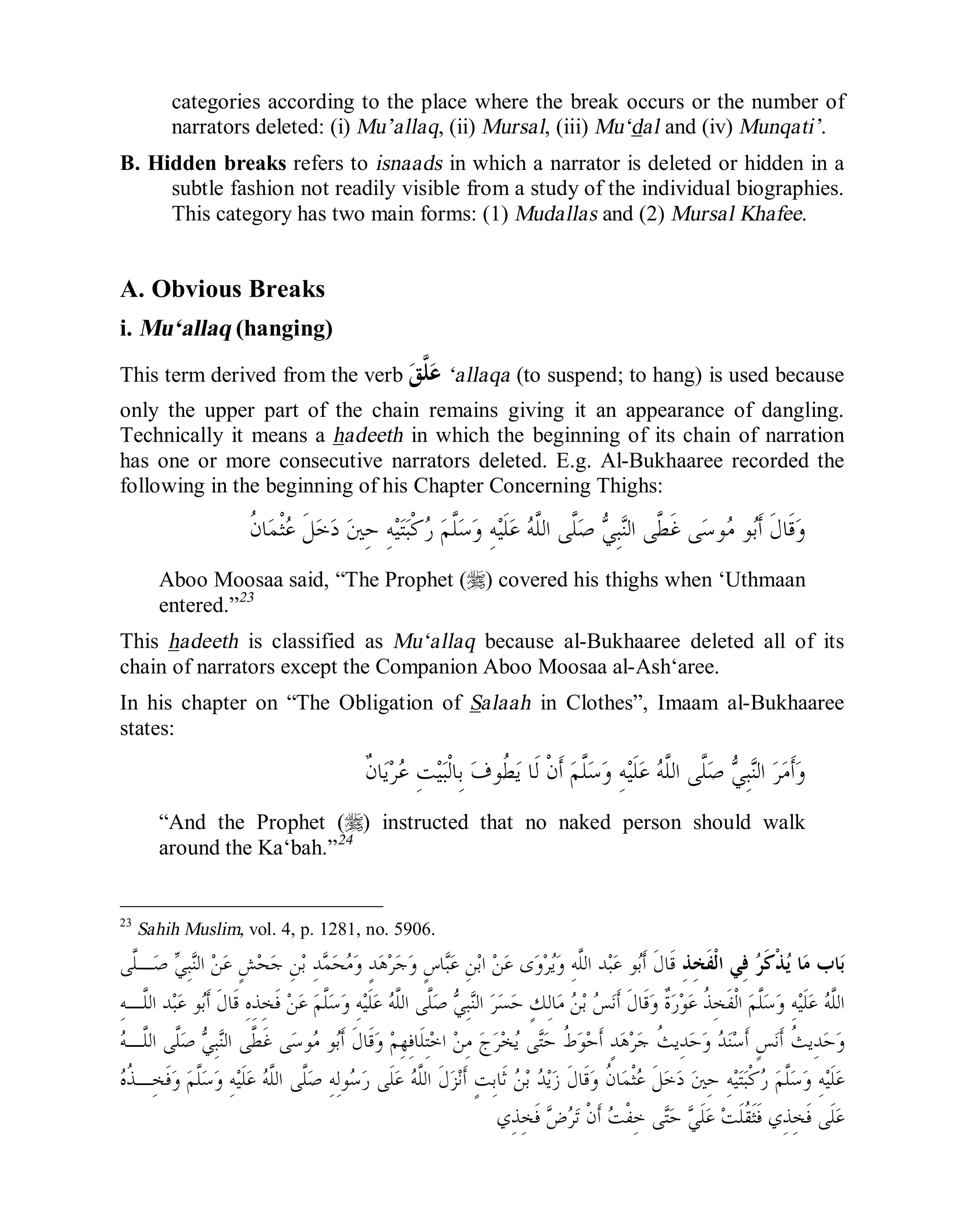
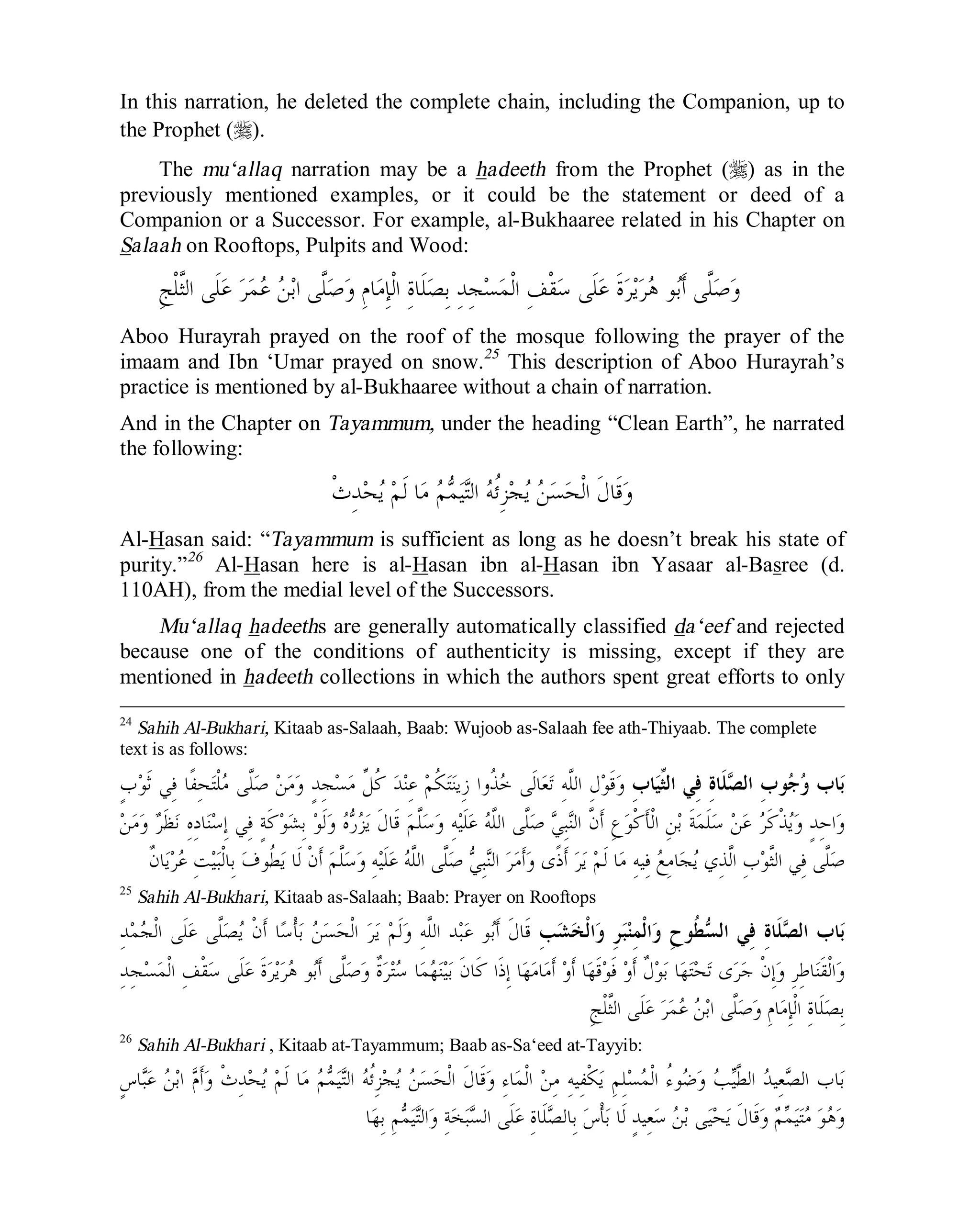

![© Islamic Online University Usool al-Hadeeth 101
http://www.islamiconlineuniversity.com 19
called Taghleeq at-Ta‘leeq (Closing Tightly the Hanging Narrations). On the
other hand, the mu‘allaq narrations in Saheeh Muslim are very few. There are
only six mu‘allaq narrations from the Prophet (r) of which Imaam Muslim
himself mentioned five of them with complete chains elsewhere in his
compilation. The remaining narration, number 369, was found by others.
Ruling on Mu‘allaq Narrations of al-Bukhaaree and Muslim
Such hadeeths are generally considered authentic if the hadeeth is narrated using
verbs in the active voice, like ﻯﻭﺭ rawaa (he narrated); ﹶﻝﹶﺎﻗ qaala (he said); ﺮﹶﻛﹶﺫ
thakara (he mentioned). On the other hand, if they are narrated using the passive
voice, like ﻱِﻭﺭ ruwiya (it was narrated); ﹶﻞِﻴﻗ qeela (it was said); ﺮِﻛﹸﺫ thukira (it
was mentioned), their status is uncertain. Some of them may be saheeh, others
hasan and yet others da‘eef. However, the weak narrations are not excessively
weak due to their presence in these books in which the authors sought to compile
only authentic hadeeths.
It should be noted, however, that those hadeeths narrated in the passive
voice due to weakness may have authentic chains which al-Bukhaaree did not
come across. For example, in the beginning of his Chapter Concerning Thighs
mentioned earlier, Imaam al-Bukhaaree stated:
ﹲﺓﺭﻮﻋ ﹸﺬِﺨﹶﻔﹾﻟﺍ ﻢﱠﻠﺳﻭ ِﻪﻴﹶﻠﻋ ﻪﱠﻠﺍﻟ ﱠﻰﻠﺻ ﻲِﺒﻨﺍﻟ ﻦﻋ ٍﺶﺤﺟ ِﻦﺑ ِﺪﻤﺤﻣﻭ ٍﺪﻫﺮﺟﻭ ٍﺱﺎﺒﻋ ِﻦﺑﺍ ﻦﻋ ﻯﻭﺮﻳﻭ
ﻭ ِﻪﱠﻠﺍﻟ ﺪﺒﻋ ﻮﺑﹶﺃ ﹶﻝﹶﺎﻗ ِﻩِﺬِﺨﹶﻓ ﻦﻋ ﻢﱠﻠﺳﻭ ِﻪﻴﹶﻠﻋ ﻪﱠﻠﺍﻟ ﱠﻰﻠﺻ ﻲِﺒﻨﺍﻟ ﺮﺴﺣ ٍﻚِﻟﺎﻣ ﻦﺑ ﺲﻧﹶﺃ ﹶﻝﹶﺎﻗﻭٍﺲﻧﹶﺃ ﹸﺚِﻳﺪﺣ
ﻢِﻬِﻓﹶﺎﻠِﺘﺧﺍ ﻦِﻣ ﺝﺮﺨﻳ ﻰﺘﺣ ﹸﻁﻮﺣﹶﺃ ٍﺪﻫﺮﺟ ﹸﺚِﻳﺪﺣﻭ ﺪﻨﺳﹶﺃ
“And it has been narrated from Ibn ‘Abbaas, Jarhad and Muhammad ibn Jahsh
from the Prophet (r): ‘The thigh is [from the] private parts.’ Anas ibn Maalik
said: The Prophet (r) uncovered his thigh. Aboo ‘Abdillaah [al-Bukhaaree] said:
Anas’ hadeeth has a better chain and that of Jarhad is more precautionary in order
to escape their contradiction.” The passive voice was used for Jarhad and active
for Anas. However, there are 4 complete narrations of Jarhad’s quotation in Sunan
at-Tirmithee, one in Sunan Abee Daawood,29
8 in Musnad Ahmad, and 2 in Sunan
29
Sunan Abu Dawud,.Kitaab al-Hammaam, Baab: an-Nahy ‘an at-ta‘arree
ﺍ ﺪﺒﻋ ﺎﻨﹶﺛﺪﺣﹶﻥﹶﺎﻛ ﹶﻝﹶﺎﻗ ِﻪِﻴﺑﹶﺃ ﻦﻋ ٍﺪﻫﺮﺟ ِﻦﺑ ِﻦﻤﺣﺮﺍﻟ ِﺪﺒﻋ ِﻦﺑ ﹶﺔﻋﺭﺯ ﻦﻋ ِﺮﻀﻨﺍﻟ ِﻲﺑﹶﺃ ﻦﻋ ٍﻚِﻟﺎﻣ ﻦﻋ ﹶﺔﻤﹶﻠﺴﻣ ﻦﺑ ِﻪﱠﻠﻟ
ﻢﱠﻠﺳﻭ ِﻪﻴﹶﻠﻋ ﻪﱠﻠﺍﻟ ﱠﻰﻠﺻ ِﻪﱠﻠﺍﻟ ﹸﻝﻮﺳﺭ ﺲﹶﻠﺟ ﹶﻝﹶﺎﻗ ِﺔﱠﻔﺼﺍﻟ ِﺏﺎﺤﺻﹶﺃ ﻦِﻣ ﹶﺍﺬﻫ ﺪﻫﺮﺟِﺬِﺨﹶﻓﻭ ﺎﻧﺪﻨِﻋﺎﻣﹶﺃ ﹶﻝﹶﺎﻘﹶﻓ ﹲﺔﹶﻔِﺸﹶﻜﻨﻣ ﻱ
ﹲﺓﺭﻮﻋ ﹶﺬِﺨﹶﻔﹾﻟﺍ ﱠﻥﹶﺃ ﺖﻤِﻠﻋ](https://image.slidesharecdn.com/usool-al-hadeeth-the-methodology-of-hadith-evaluation-130905043227-/75/Usool-al-hadeeth-the-methodology-of-hadith-evaluation-53-2048.jpg)

![© Islamic Online University Usool al-Hadeeth 101
http://www.islamiconlineuniversity.com 21
The jurists (fuqahaa) generally defined the mursal as any omission in the
chain, wherever it may occur and al-Khateeb al-Baghdaadee agreed with them.31
The Ruling on Mursal Hadeeth
Such a hadeeth is in essence da’eef and thus rejected due to the loss of the
condition of ittisaal (continuity) and the lack of knowledge about the missing
narrator who may have been a sahaabee or another Taabi‘ee. This basic ruling
stands regardless of whether the chain of narrators up to the Successor is authentic
or not. If the chain up to the Successor is authentic it is referred to as mursal
saheeh or saheeh mursal. For example, Aboo Daawood collected the following
narration in his collection of mursal narrations:
ﻦﻋ ٍﺢﻳﺮﺷ ﻦﺑ ﹸﺓﻮﻴﺣ ﺎﻧﺮﺒﺧﹶﺃ ٍﺐﻫﻭ ﻦﺑﺍ ﺎﻨﹶﺛﺪﺣ ﺩﺍﻭﺩ ﻦﺑ ﹸﻥﺎﻤﻴﹶﻠﺳ ﺎﻨﹶﺛﺪﺣِﻦﺑ ٍﺪِﻳﺰﻳ ﻦﻋ ﹶﻥﹶﻼﻴﹶﻏ ِﻦﺑ ٍﻢِﻟﺎﺳ
ﹶﻝﹶﺎﻘﹶﻓ ِﻥﺎﻴﱢﻠﺼﺗ ِﻦﻴﺗﹶﺃﺮﻣﺍ ﹶﻰﻠﻋ ﺮﻣ ﻢﱠﻠﺳﻭ ِﻪﻴﹶﻠﻋ ﻪﱠﻠﺍﻟ ﱠﻰﻠﺻ ِﻪﱠﻠﺍﻟ ﹶﻝﻮﺳﺭ ﱠﻥﹶﺃ ٍﺐِﻴﺒﺣ ِﻲﺑﹶﺃ)) :ﺎﻤﺗﺪﺠﺳ ﹶﺍﺫِﺇ
ِﻲﻓ ﺖﺴﻴﹶﻟ ﹶﺓﹶﺃﺮﻤﹾﻟﺍ ﱠﻥِﺈﹶﻓ ِﺽﺭَﻷﹾﺍ ﹶﻰﻟِﺇ ِﻢﺤﱠﻠﺍﻟ ﺾﻌﺑ ﺎﻤﻀﹶﻓِﻝﺎﺟﺮﹶﺎﻟﻛ ﻚِﻟﹶﺫ((
Sulaymaan ibn Daawood informed us [saying] Ibn Wahb informed us [saying]
Haywah ibn Shurayh informed us from Saalim ibn Ghaylaan from Yazeed ibn
Habeeb that the Messenger of Allaah (r) passed by two women who were
praying and said: “Whenever you prostrate, huddle some of your flesh towards the
ground for the woman is not like the man it that respect.”32
All of the narrators are reliable, however it is mursal because Yazeed ibn Abee
Habeeb was a minor Successor. Consequently, it is saheeh al-Isnaad mursal but
da‘eef and thus cannot be used as independent legal evidence.33
Scholars of hadeeth and others differed regarding the use of mursal
narrations as textual evidence because this type of omission differs from others.
The positions of the scholars regarding mursal narrations are summarized in the
following three categories:
a) The Mursal is weak and rejected. The majority of hadeeth scholars rejected
the mursal narration arguing that the omitted narrator is not necessarily a
Companion due to a lack of information about exactly who the omitted
narrator was.
31
The Science of Authenticating the Prophets Traditions, pp. 75-6.
32
Al-Maraaseel, no. 87.
33
Duroos fee Mustalah al-Hadeeth, p. 18.](https://image.slidesharecdn.com/usool-al-hadeeth-the-methodology-of-hadith-evaluation-130905043227-/75/Usool-al-hadeeth-the-methodology-of-hadith-evaluation-55-2048.jpg)



![© Islamic Online University Usool al-Hadeeth 101
http://www.islamiconlineuniversity.com 25
Muwatta42
with the following chain: Maalik reported from Muhammad ibn
‘Ajlaan from his father43
from Aboo Hurayrah.44
The mu‘dal and mu‘allaq are identical when the narrators are omitted in
consecutively at the beginning of the chain of narrators and different when two
are missing from the middle (i.e., mu‘dal), or one is missing from the beginning
(i.e., mu‘allaq).
Scholars of hadeeth unanimously considered the mu‘dal as weaker and more
defective than the mursal and the munqati‘ due to excessive omissions in its
chain.
B. Hidden Breaks
i. Mudallas (Counterfeit)
The word Mudallas comes from the verb ﺲﱠﻟﺩ dallasa which literally means to
hide the defects in goods from a buyer. Technically it refers to the hiding of a
defect in the sanad and the beautification of its outer appearance. It may be further
subdivided into two other groups: [a] Tadlees as-Sanad and [b] Tadlees ash-
Shuyookh.
a) Tadlees As-Sanad
This form of Tadlees has two manifestations:
(1) The first is the case where a narrator, narrates something which he did not hear
from someone whom he studied under in an ambiguous fashion. He does not
openly claim to have heard it from his teacher but only implies it by using the
42
Muwatta Malik, Kitaab al-Jaami, Baab: Rifq bil mamlook
43
Musnad Ahmad, CD no. 8154
ﻴﻫﻭ ﺎﻨﹶﺛﺪﺣ ﹸﻥﱠﺎﻔﻋ ﺎﻨﹶﺛﺪﺣٍﺪﻤﺤﻣ ِﻲﺑﹶﺃ ﹶﻥﹶﺎﻠﺠﻋ ﻦﻋ ﺞﺷﹶﺄﹾﻟﺍ ِﻦﺑ ِﻪﱠﻠﺍﻟ ِﺪﺒﻋ ِﻦﺑ ِﺮﻴﹶﻜﺑ ﻦﻋ ﹶﻥﹶﺎﻠﺠﻋ ﻦﺑ ﺪﻤﺤﻣ ﺎﻨﹶﺛﺪﺣ ﺐﻦﻋ
ﻦِﻣ ﻒﱠﻠﹶﻜﻳ ﹶﺎﻟﻭ ﻪﺗﻮﺴِﻛﻭ ﻪﻣﺎﻌﹶﻃ ِﻙﹸﻮﻠﻤﻤﹾﻠِﻟ ﹶﻝﹶﺎﻗ ﻢﱠﻠﺳﻭ ِﻪﻴﹶﻠﻋ ﻪﱠﻠﺍﻟ ﱠﻰﻠﺻ ﻲِﺒﻨﺍﻟ ﻦﻋ ﹶﺓﺮﻳﺮﻫ ِﻲﺑﹶﺃﻖِﻴﻄﻳ ﹶﺎﻟ ﺎﻣ ِﻞﻤﻌﹾﻟﺍ
44
Sahih Muslim, vol. , p. , no. Kitaab al-Eemaan, Baab: It’aam al-mamlook
ﺞﺷﹶﺄﹾﻟﺍ ﻦﺑ ﺮﻴﹶﻜﺑ ﱠﻥﹶﺃ ِﺙِﺭﺎﺤﹾﻟﺍ ﻦﺑ ﻭﺮﻤﻋ ﺎﻧﺮﺒﺧﹶﺃ ٍﺐﻫﻭ ﻦﺑﺍ ﺎﻧﺮﺒﺧﹶﺃ ٍﺡﺮﺳ ِﻦﺑ ِﻭﺮﻤﻋ ﻦﺑ ﺪﻤﺣﹶﺃ ِﺮِﻫﱠﺎﻄﺍﻟ ﻮﺑﹶﺃ ِﻲﻨﹶﺛﺪﺣ ﻭ
ﻪﻣﺎﻌﹶﻃ ِﻙﹸﻮﻠﻤﻤﹾﻠِﻟ ﹶﻝﹶﺎﻗ ﻪﻧﹶﺃ ﻢﱠﻠﺳﻭ ِﻪﻴﹶﻠﻋ ﻪﱠﻠﺍﻟ ﱠﻰﻠﺻ ِﻪﱠﻠﺍﻟ ِﻝﻮﺳﺭ ﻦﻋ ﹶﺓﺮﻳﺮﻫ ِﻲﺑﹶﺃ ﻦﻋ ﹶﺔﻤِﻃﹶﺎﻓ ﹶﻰﻟﻮﻣ ِﻥﹶﺎﻠﺠﻌﹾﻟﺍ ﻦﻋ ﻪﹶﺛﺪﺣ
ﻖِﻴﻄﻳ ﺎﻣ ﱠﺎﻟِﺇ ِﻞﻤﻌﹾﻟﺍ ﻦِﻣ ﻒﱠﻠﹶﻜﻳ ﹶﺎﻟﻭ ﻪﺗﻮﺴِﻛﻭ](https://image.slidesharecdn.com/usool-al-hadeeth-the-methodology-of-hadith-evaluation-130905043227-/75/Usool-al-hadeeth-the-methodology-of-hadith-evaluation-59-2048.jpg)
![© Islamic Online University Usool al-Hadeeth 101
http://www.islamiconlineuniversity.com 26
phrase “ ﹶﻝﹶﺎﻗ He said” or “ ﻦﻋ from”. E.g. ‘Alee ibn Khashram said that Ibn
‘Uyaynah related to us from az-Zuhree but when he was asked “Did you hear it
from az-Zuhree?” he replied, “ ‘Abdur-Razzaaq informed me from Mu‘ammar
from az-Zuhree.” In this example Ibn ‘Uyaynah had deleted two narrators
between himself and az-Zuhree.
The following is another example from Sunan Abee Daawood
ﹶﺎﻄﻋ ِﻦﺑ ِﻭﺮﻤﻋ ِﻦﺑ ِﺪﻤﺤﻣ ﻦﻋ ﻖﺤﺳِﺇ ِﻦﺑﺍ ﻦﻋ ِﻲﺑﹶﺃ ﺎﻨﹶﺛﺪﺣ ﻲﻤﻋ ﺎﻨﹶﺛﺪﺣ ٍﺪﻌﺳ ﻦﺑ ِﻪﱠﻠﺍﻟ ﺪﻴﺒﻋ ﺎﻨﹶﺛﺪﺣٍﺀ
ِﺮﺼﻌﹾﻟﺍ ﺪﻌﺑ ﱢﻲﻠﺼﻳ ﹶﻥﹶﺎﻛ ﻢﱠﻠﺳﻭ ِﻪﻴﹶﻠﻋ ﻪﱠﻠﺍﻟ ﱠﻰﻠﺻ ِﻪﱠﻠﺍﻟ ﹶﻝﻮﺳﺭ ﱠﻥﹶﺃ ﻪﺘﹶﺛﺪﺣ ﺎﻬﻧﹶﺃ ﹶﺔﺸِﺋﺎﻋ ﹶﻰﻟﻮﻣ ﹶﻥﺍﻮﹾﻛﹶﺫ ﻦﻋ
ِﻝﺎﺻِﻮﹾﻟﺍ ﻦﻋ ﻰﻬﻨﻳﻭ ﹸﻞِﺻﺍﻮﻳﻭ ﺎﻬﻨﻋ ﻰﻬﻨﻳﻭ
‘Ubaydullaah ibn Sa‘d informed us [saying], my uncle informed us [saying], my
father informed us from Ibn Is’haaq from Muhammad ibn ‘Amr ibn ‘Ataa from
Thakwaan, the freed slave of ‘Aa’ishah, that she informed him that the Messenger
of Allaah (r) used to pray after ‘Asr prayers and forbid it, and he used to fast for
twenty-four hours and forbid continual fasting.45
The narrators of this hadeeth are reliable. However, Ibn Is’haaq, whose name
was Muhammad ibn Is’haaq ibn Yasaar, was a known mudallis and he narrated
this hadeeth from Muhammad ibn ‘Amr using the phrase ﻦﻋ ‘an (from) without
clearly indicating that he actually heard it from him.
(2) The other form is where a Raawee narrates from his teacher deleting from the
chain a weak narrator between two strong narrators who met each other by using
ambiguous terminology. E.g. Aboo Haatim collected the following hadeeth in
which his father said Is’haaq ibn Raahawayh reported from Baqiyyah who said
that Aboo Wahb al-Asadee informed him from Naafi‘ from Ibn‘Umar the
hadeeth,
))ﺘﺣ ِﺀﺮﻤﹾﻟﺍ ﻡﹶﻼﺳِﺇ ﻭﺍﺪﻤﺤﺗ ﹶﻻِﻪِﻳﹾﺃﺭ ﹶﺓﺪﹾﻘﻋ ﹸﻮﺍﻓِﺮﻌﺗ ﻰ((
“Don’t praise a man’s Islaam until you know what his opinions are.”
Aboo Haatim’s father said, “This hadeeth has in it a point which few people
realize, ‘Ubaydullaah ibn ‘Amr narrated this hadeeth from Is’haaq ibn Farwah
from Naafi‘ from Ibn ‘Umar from the Prophet (r) because ‘Ubaydullaah ibn
45
Sunan Abu Dawud, Kitaab as-Salaah, Baab: Who is permitted regarding both of them if the sun
is high. Graded da‘eef in Silsilah al-Ahaadeeth ad-Da‘eefah, no. 945.](https://image.slidesharecdn.com/usool-al-hadeeth-the-methodology-of-hadith-evaluation-130905043227-/75/Usool-al-hadeeth-the-methodology-of-hadith-evaluation-60-2048.jpg)


![© Islamic Online University Usool al-Hadeeth 101
http://www.islamiconlineuniversity.com 29
Khateeb al-Baghdaadee’s book called at-Tibyaan li-Asmaa al-Mudalliseen.
ii. Mursal Khafee (Hidden Generalization)
Technically means that someone narrates something he did not hear from
someone whom he met or who was his contemporary using terminology implying
that he heard it from him. The difference between Mursal Khafiy and Tadlees as-
Sanad is that in the case of Mursal, he narrates from someone whom he did not
study under whereas in Tadlees he narrates from his teacher. E.g.
ِﺡﺎﺒﺼﺍﻟ ﻦﺑ ﺪﻤﺤﻣ ﺎﻨﹶﺛﺪﺣِﻦﺑ ﺮﻤﻋ ﻦﻋ ﹶﺓﺪِﺋﺍﺯ ِﻦﺑ ِﺪﻤﺤﻣ ِﻦﺑ ِﺢِﻟﺎﺻ ﻦﻋ ٍﺪﻤﺤﻣ ﻦﺑ ِﺰِﻳﺰﻌﹾﻟﺍ ﺪﺒﻋ ﺎﻧﹶﺄﺒﻧﹶﺃ
ﺱِﺭﺎﺣ ﻪﱠﻠﺍﻟ ﻢِﺣﺭ ﻢﱠﻠﺳﻭ ِﻪﻴﹶﻠﻋ ﻪﱠﻠﺍﻟ ﱠﻰﻠﺻ ِﻪﱠﻠﺍﻟ ﹸﻝﻮﺳﺭ ﹶﻝﹶﺎﻗ ﹶﻝﹶﺎﻗ ﻲِﻨﻬﺠﹾﻟﺍ ٍﺮِﻣﺎﻋ ِﻦﺑ ﹶﺔﺒﹾﻘﻋ ﻦﻋ ِﺰِﻳﺰﻌﹾﻟﺍ ِﺪﺒﻋ
ﺮﺤﹾﻟﺍِﺱ
Muhammad ibn as-Sabbaah informed us [saying:] ‘Abdul-‘Azeez ibn Muhammad
informed us from Saalih ibn Muhammad ibn Zaa’id from ‘Umar ibn ‘Abdul-
‘Azeez from ‘Uqbah ibn ‘Aamir al-Juhanee who quoted the Messenger of Allaah
(r) as saying, “May Allaah’s mercy be on the watch guard who watched over the
other watch guards.”48
‘Umar did not meet ‘Uqbah though he lived in his time according to al-Mizzee in
his book al-Atraaf.
The Methods of Recognition
This type of Irsaal may be identified by any one of the following three factors:
(1) The statement of one of the scholars that such and such a narrator never met
the narrator from whom he was narrating or that he never heard anything from
him.
(2) The narrator informing on himself by admitting that he never met or heard
directly from the narrator from whom he narrated.
(3) If the hadeeth comes along another chain in which people are added between a
narrator and the one from whom he was supposed to be narrating.
48
Sunan Ibn Majah , Kitaab Jihaad Baab: Fadl al Haras wa takbeeer](https://image.slidesharecdn.com/usool-al-hadeeth-the-methodology-of-hadith-evaluation-130905043227-/75/Usool-al-hadeeth-the-methodology-of-hadith-evaluation-63-2048.jpg)



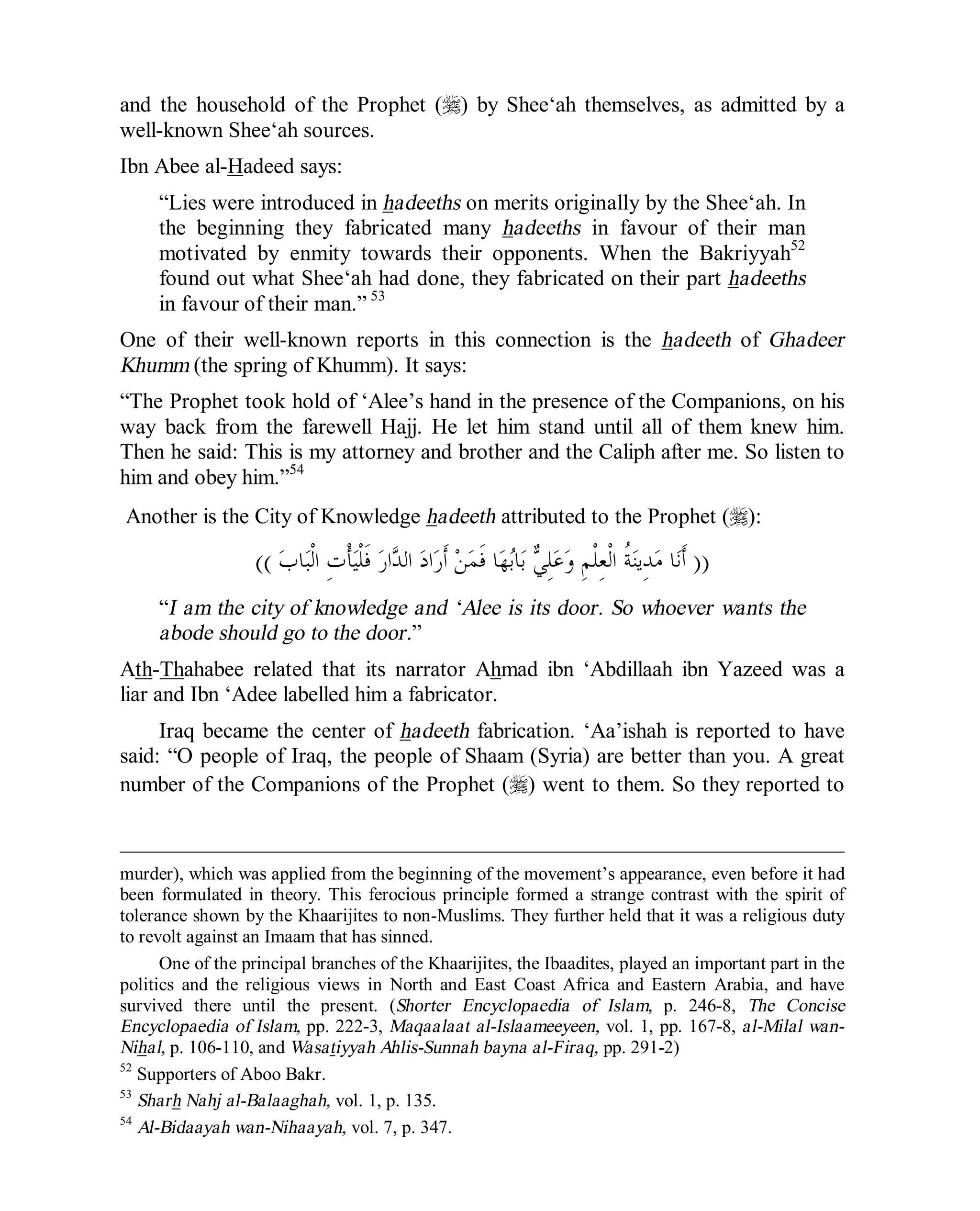
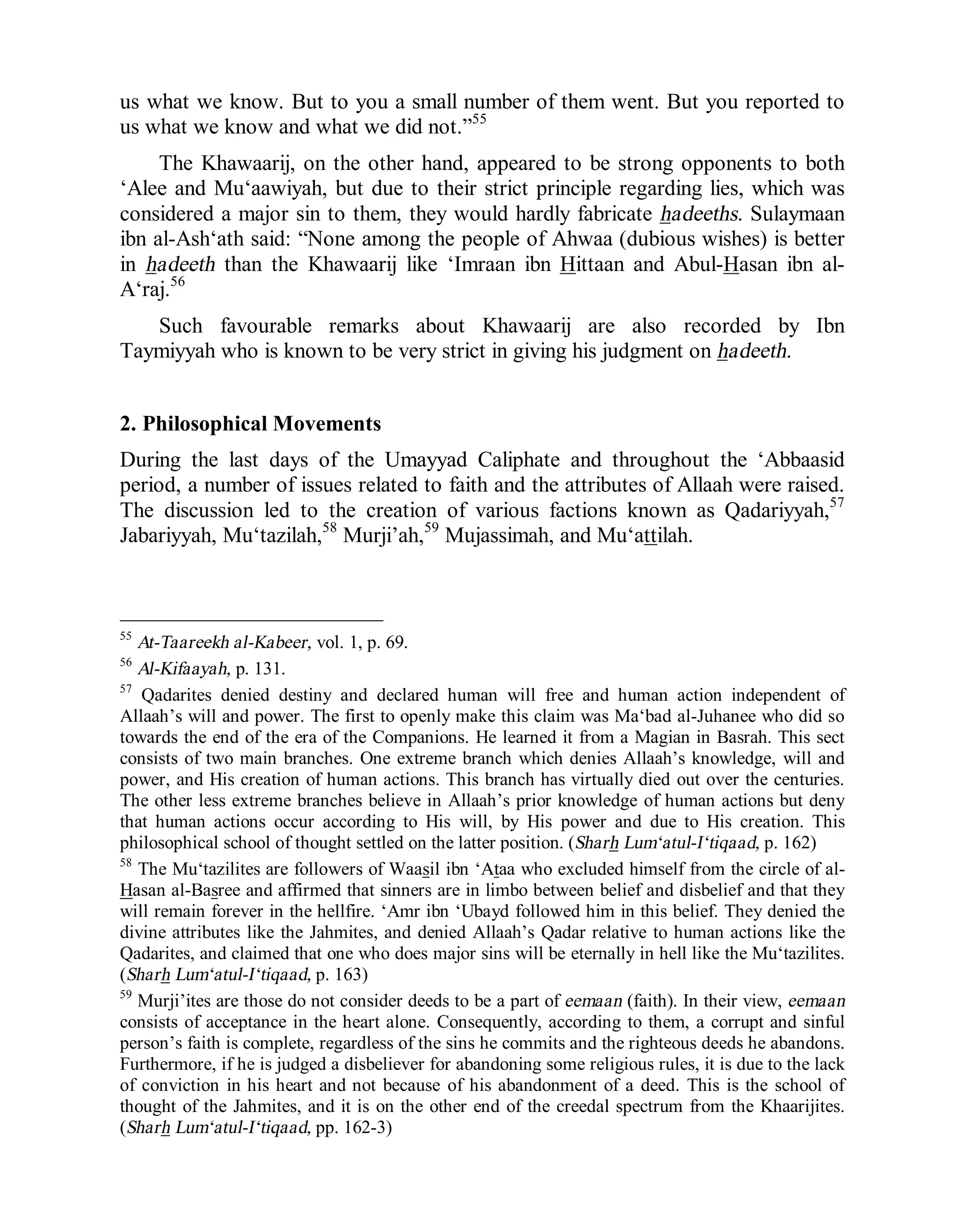
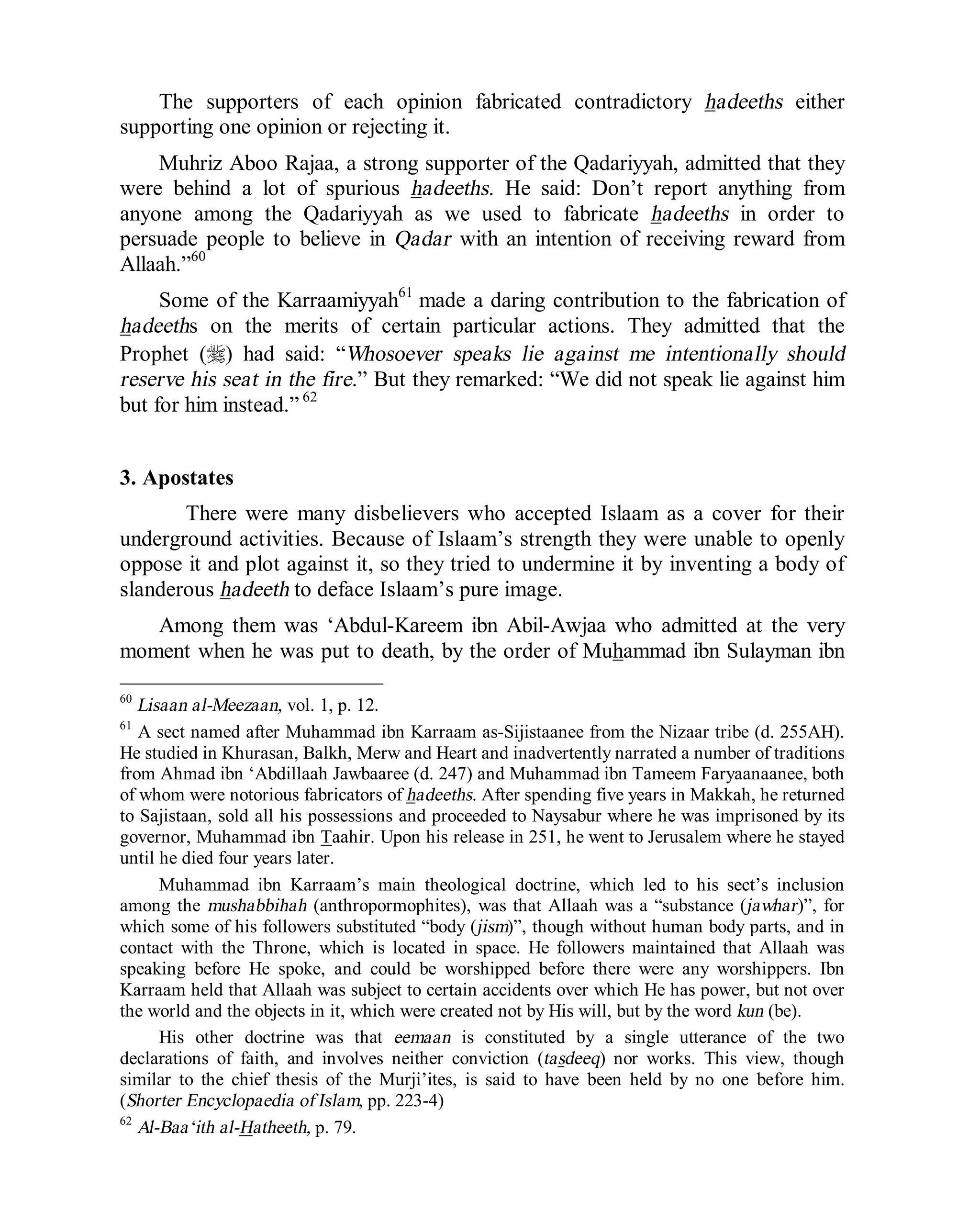

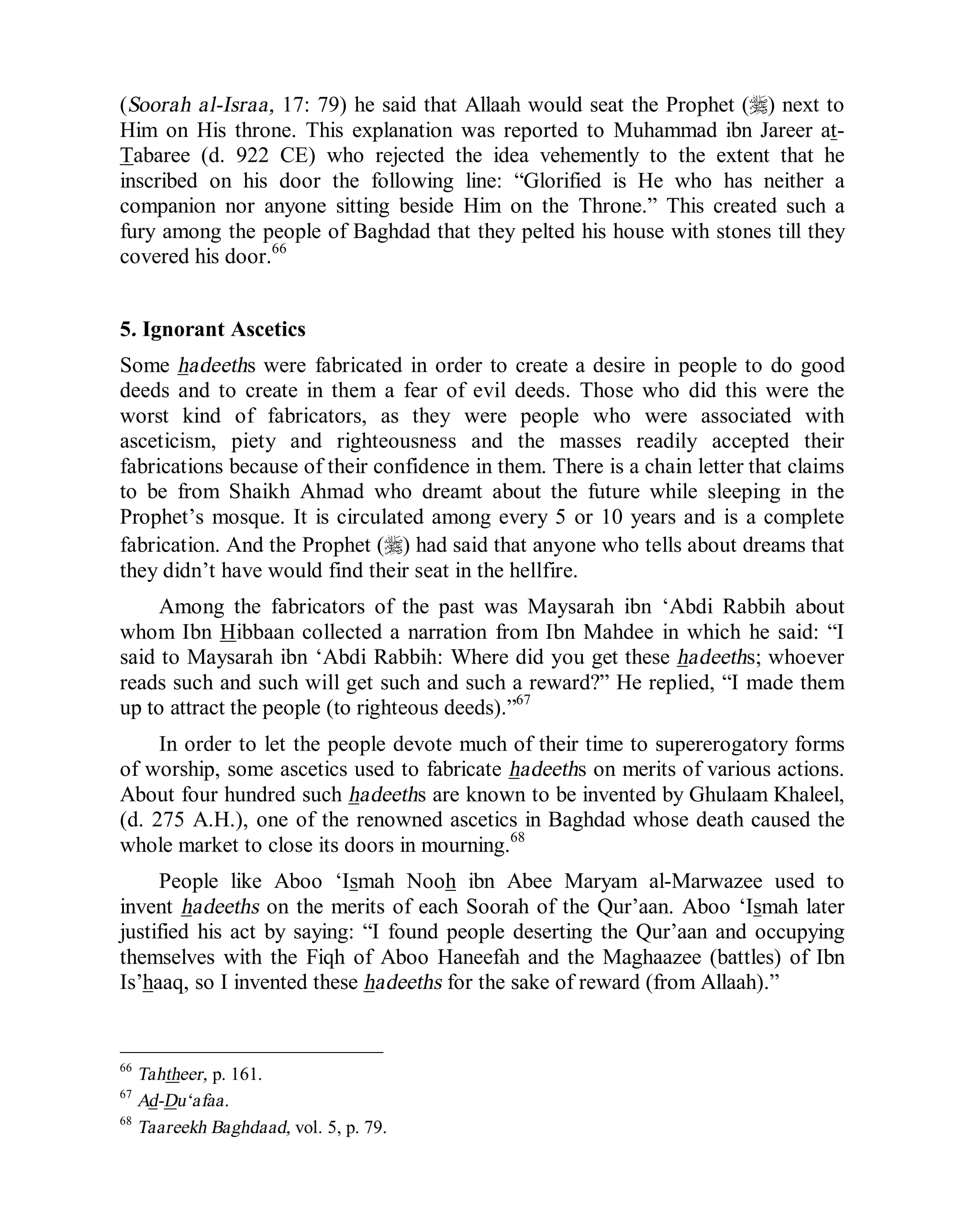


![© Islamic Online University Usool al-Hadeeth 101
http://www.islamiconlineuniversity.com 40
“Gabriel fed me some hareesah from paradise to strengthen my back for
midnight prayers.”76
Ibn Muhammad and Aboo Haatim labeled him a liar and Ibn al-Jawzee said:
“This hadeeth is a fabrication of Muhammad ibn al-Hajjaaj who used to sell
hareesah. Most of its chain center around him and other liars stole it from him.”
8. Wise Sayings Turned into Hadith77
:
Some reporters have tried to credit to the Prophet (r) different parables and
sayings of wisdom. For example the following saying is known to be that of
Haarith ibn Kaldah, a well-known doctor among the Arabs: “The abdomen is the
house of disease and prevention is the head of remedies.” But it was wrongly
attributed to the Prophet (r).78
Other examples are the popular sayings: “Seek
knowledge even on to China,” and “Seek knowledge from the cradle to the grave.”
ﹸﺓﻮﻴﺣ ﺎﻨﹶﺛﺪﺣﻦﻋ ﻲِﻔﹶﻘﱠﺜﺍﻟ ٍﺪﻤﺤﻣ ِﻦﺑ ِﺪِﻟﺎﺧ ﻦﻋ ﻢﻳﺮﻣ ِﻲﺑﹶﺃ ِﻦﺑ ِﺮﹾﻜﺑ ِﻲﺑﹶﺃ ﻦﻋ ﹸﺔﻴِﻘﺑ ﺎﻨﹶﺛﺪﺣ ٍﺢﻳﺮﺷ ﻦﺑ
ﹶﻝﹶﺎﻗ ﻢﱠﻠﺳﻭ ِﻪﻴﹶﻠﻋ ﻪﱠﻠﺍﻟ ﱠﻰﻠﺻ ﻲِﺒﻨﺍﻟ ﻦﻋ ِﺀﺍﺩﺭﺪﺍﻟ ِﻲﺑﹶﺃ ﻦﻋ ِﺀﺍﺩﺭﺪﺍﻟ ِﻲﺑﹶﺃ ِﻦﺑ ِﻝِﻼﺑ))ﻌﻳ َﺀﻲﺸﺍﻟ ﻚﺒﺣِﻲﻤ
ﻢِﺼﻳﻭ.((
Haywah ibn Shurayh informed us [saying that] Baqiyyah informed us from Aboo
Bakr ibn Abee Maryam from Khaalid ibn Muhammad ath-Thaqafee from Bilaal
ibn Abid-Dardaa from Abud-Dardaa from the Prophet (r) that he said: “Your
love of something blinds and deafens.”79
Its chain is weak due to Aboo Bakr ibn Abee Maryam who had a poor memory
and his narrations were confused.
Forged Hadeeths in Tafseer
Many Qur’aanic commentators used forged traditions in their commentaries
without explaining their status. The fabricated hadeeths attributed to Ubay ibn
Ka‘b on the excellence of the chapters of the Qur’aan were among the most
popular. They can be found in the Tafseers of ath-Tha‘labee, al-Waahidee, az-
76
Ibid., no. 690.
77
Criticism of Hadith, pp. 35-43.
78
Lamahaat fee Usool al-Hadeeth, p. 305.
79
Tareekh al-Kabeer, vol. 2, p. 1, no. 175 and in Sunan Abu Dawud,. as well as Musnad Ahmad,
vol. 5, p. 194 and vol. 6, p. 650.](https://image.slidesharecdn.com/usool-al-hadeeth-the-methodology-of-hadith-evaluation-130905043227-/75/Usool-al-hadeeth-the-methodology-of-hadith-evaluation-74-2048.jpg)

![© Islamic Online University Usool al-Hadeeth 101
http://www.islamiconlineuniversity.com 42
his Sunan:
ﺤﻤﹾﻟﺍ ﺎﻳِﺮﹶﻛﺯ ِﻦﺑ ِﻢِﺳﹶﺎﻘﹾﻟﺍ ﻦﺑ ﺪﻤﺤﻣ ﺎﻨﹶﺛﺪﺣﻦﺑ ﺪِﻴﻌﺳ ﺎﻨﹶﺛ ِﺪِﺣﺍﻮﹾﻟﺍ ِﺪﺒﻋ ِﻦﺑ ٍﺪﻤﺤﻣ ﻦﺑ ﻦﺴﺤﹾﻟﺍ ﺎﻨﹶﺛَﻲِﺑِﺭﺎ
ِﺮﺳﺎﻳ ِﻦﺑ ٍﺭﺎﻤﻋﻭ ٍﺐِﻟﹶﺎﻃ ِﻲﺑﹶﺃ ِﻦﺑ ﻲِﻠﻋ ﻦﻋ ِﻞﻴﹶﻔﱡﻄﺍﻟ ِﻲﺑﹶﺃ ﻦﻋ ٍﺮِﺑﺎﺟ ﻦﻋ ٍﺮﻤِﺷ ﻦﺑ ﻭﺮﻤﻋ ِﻲﻨﹶﺛﺪﺣ ﹶﻥﺎﻤﹾﺜﻋ
ﱠﻰﻠﺻ ِﷲﺍ ﹸﻝﻮﺳﺭ ﺎﻌِﻤﺳ ﺎﻤﻬﻧﹶﺃِﻲﻓ ِﻢِﻴﺣﺮﺍﻟ ِﻦﻤﺣﺮﺍﻟ ِﷲﺍ ِﻢﺴِﺒِﺑ ِﺕﺎﺑﻮﺘﹾﻜﻤﹾﻟﺍ ِﻲﻓ ﺮﻬﺠﻳ ﻢﱠﻠﺳﻭ ِﻪﻴﹶﻠﻋ ﻪﱠﻠﺍﻟ
ِﺓﹶﻼﺻ ِﻞﺒﹶﻗ ﻦِﻣ ِﺔﺑﻮﺘﹾﻜﻤﹾﻟﺍ ِﺕﺍﻮﹶﻠﺼﺍﻟ ِﺮﺑﺩ ِﻲﻓ ﺮﺒﹶﻜﻳﻭ ِﺮﺗِﻮﹾﻟﺍﻭ ِﺮﺠﹶﻔﹾﻟﺍ ِﺓﹶﻼﺻ ِﻲﻓ ﺖﻨﹾﻘﻳﻭ ِﻥﺁﺮﹸﻘﹾﻟﺍ ِﺔﺤِﺗﹶﺎﻓ
ﺮﻋ ﹶﺓﺍﺪﹶﻏ ِﺮﺠﹶﻔﹾﻟﺍِﻚِﻳﺮﺸﺘﺍﻟ ِﻡﺎﻳﹶﺃ ﺮِﺧﺁ ِﺮﺼﻌﹾﻟﺍ ِﺓﹶﻼﺻ ﹶﻰﻟِﺇ ﹶﺔﹶﻓ
Muhammad ibn al-Qaasim ibn Zakariyyaa al-Muhaaribee informed us [saying]
that al-Hasan ibn Muhammad ibn ‘Abdil-Waahid informed us [saying] that
Sa‘eed ibn ‘Uthmaan informed us [saying] that ‘Amr ibn Shimr informed me
from Jaabir from Aboo at-Tufayl from ‘Alee ibn Abee Taalib and ‘Ammaar ibn
Yaasir that they both heard the Messenger of Allaah (r) recite the bismillaah ir-
Rahmaan ir-Raheem aloud in the Faatihah of obligatory prayers, make qunoot in
Fajr and Witr prayers, and say Allaahu akbar at the end of the obligatory prayers
from Fajr in the morning of the Day of Arafat until the ‘Asr prayers on the last
Days of Tashreek.80
This chain is very weak due mainly to ‘Amr ibn Shimr al-Ja‘fee al-Koofee
about whom Ibn Hajar said in Lisaan al-Meezaan from Yahyaa ibn Ma‘een: He is
nothing. Al-Joorjaanee called him a deviated liar and Ibn Hibbaan labeled him a
Shi’ite who cursed the Companions and narrated forgeries from reliable narrators.
An-Nasaa’ee and ad-Daaraqutnee both said his narrations were matrook. Also
Jaabir ibn Yazeed al-Ja‘fee is also weak.
Terminology:
The hadeeth matrook is often described as “very weak” (da‘eef jiddan).
Munkar (Rejected)
The label munkar is the passive participle derived from the verb ﺮﹶﻜﻧﹶﺃ Ankara
which means to reject. The mawdoo‘ and matrook narrations were weak due to
defects in ‘adaalah (integrity). The munkar narration is weak due to defect in dabt
(accuracy). Technically, it refers to a weak hadeeth which contradicts an authentic
hadeeth. This was the definition preferred by Ibn Hajar. The two most common
80
Irwaa al-Ghaleel, no. 654.](https://image.slidesharecdn.com/usool-al-hadeeth-the-methodology-of-hadith-evaluation-130905043227-/75/Usool-al-hadeeth-the-methodology-of-hadith-evaluation-76-2048.jpg)
![© Islamic Online University Usool al-Hadeeth 101
http://www.islamiconlineuniversity.com 43
definitions by other scholars are:
1. A narration containing a transmitter known for committing excessive
mistakes.
2. A narration containing a transmitter known for indecent conduct.
Al-Bayqoonee defined it poetically as follows:
ﹰﺍﹶﺪﻏ ٍﻭﺍﻭ ِﻪِﺑ ﺩﺮﹶﻔﹾﻟﺍ ﺮﹶﻜﻨﻣﻭ*ﺍﺩﺮﹶﻔﺘﺍﻟ ﹸﻞِﻤﺤﻳ ﹶﻻ ﻪﹸﻠِﻳﺪﻌﺗ
The munkar is only narrated by a single bad narrator * who cannot stand alone
with the responsibility of narration
The Difference between Munkar and Shaathth
Both categories involve contradiction of stronger narrations. However, in the case
of shaathth narrations it is a reliable authentic chain which a reliable narrator is in
contradiction to another or other narrators who are stronger. While, in the case of
munkar narrations, it is a weak transmitter in contradiction to reliable narrators.
The following are two examples of a munkar narration:
The first is found in Sunan at-Tirmithee in the chapter on the merits of ‘Alee.
ٍﻞﻴﻬﹸﻛ ِﻦﺑ ﹶﺔﻤﹶﻠﺳ ﻦﻋ ﻚِﻳﺮﺷ ﺎﻨﹶﺛﺪﺣ ﻲِﻣﻭﺮﺍﻟ ِﻦﺑ ﺮﻤﻋ ﻦﺑ ﺪﻤﺤﻣ ﺎﻨﹶﺛﺪﺣ ﻰﺳﻮﻣ ﻦﺑ ﹸﻞِﻴﻌﻤﺳِﺇ ﺎﻨﹶﺛﺪﺣ
ﱠﻠﺻ ِﻪﱠﻠﺍﻟ ﹸﻝﻮﺳﺭ ﹶﻝﹶﺎﻗ ﹶﻝﹶﺎﻗ ﻪﻨﻋ ﻪﱠﻠﺍﻟ ﻲِﺿﺭ ﻲِﻠﻋ ﻦﻋ ﻲِﺤِﺑﺎﻨﺼﺍﻟ ﻦﻋ ﹶﺔﹶﻠﹶﻔﹶﻏ ِﻦﺑ ِﺪﻳﻮﺳ ﻦﻋِﻪﻴﹶﻠﻋ ﻪﱠﻠﺍﻟ ﻰ
ﻢﱠﻠﺳﻭ)) :ﺎﻬﺑﺎﺑ ﻲِﻠﻋﻭ ِﺔﻤﹾﻜِﺤﹾﻟﺍ ﺭﺍﺩ ﺎﻧﹶﺃ.((ﻯﻭﺭﻭ ﺮﹶﻜﻨﻣ ﺐِﻳﺮﹶﻏ ﹲﺚِﻳﺪﺣ ﹶﺍﺬﻫ ﻰﺴِﻴﻋ ﻮﺑﹶﺃ ﹶﻝﹶﺎﻗ
ﹶﺚِﻳﺪﺤﹾﻟﺍ ﹶﺍﺬﻫ ﻑِﺮﻌﻧ ﹶﺎﻟﻭ ﻲِﺤِﺑﺎﻨﺼﺍﻟ ﻦﻋ ِﻪِﻴﻓ ﻭﺍﺮﹸﻛﹾﺬﻳ ﻢﹶﻟﻭ ٍﻚِﻳﺮﺷ ﻦﻋ ﹶﺚِﻳﺪﺤﹾﻟﺍ ﹶﺍﺬﻫ ﻢﻬﻀﻌﺑﻦﻋ
ٍﺱﺎﺒﻋ ِﻦﺑﺍ ﻦﻋ ﺎﺏﺒﹾﻟﺍ ِﻲﻓﻭ ٍﻚِﻳﺮﺷ ﻦﻋ ِﺕﹶﺎﻘﱢﺜﺍﻟ ﻦِﻣ ٍﺪِﺣﺍﻭ
Ismaa‘eel ibn Moosaa informed us [saying] that Muhammad ibn ‘Umar ibn ar-
Roomee informed us [saying] that Shareek informed us from Salamah ibn Kuhayl
from Suwayd ibn Ghaflah from as-Sunaabihee from ‘Alee that he quoted the
Messenger of Allaah (r) as saying: “I am the abode of wisdom and ‘Alee is its
door.”81
Aboo ‘Eesaa said: This hadeeth is ghareeb (unusual) munkar. Some of
them narrate it from Shareek and do not mention “from as-Sunaabihee” and we do
not know of this hadeeth being narrated by a reliable narrator from Shareek.
81
Sunan at-Tirmithee, Kitaab: Manaaqib; Baab: Manaaqib ‘Alee.](https://image.slidesharecdn.com/usool-al-hadeeth-the-methodology-of-hadith-evaluation-130905043227-/75/Usool-al-hadeeth-the-methodology-of-hadith-evaluation-77-2048.jpg)
![© Islamic Online University Usool al-Hadeeth 101
http://www.islamiconlineuniversity.com 44
The second is found in Sunan Ibn Maajah in the chapter on foods.
ﻤﹾﻟﺍ ٍﺲﻴﹶﻗ ِﻦﺑ ِﺪﻤﺤﻣ ﻦﺑ ﻰﻴﺤﻳ ﺎﻨﹶﺛﺪﺣ ٍﻒﹶﻠﺧ ﻦﺑ ﺮﹾﻜﺑ ٍﺮﺸِﺑ ﻮﺑﹶﺃ ﺎﻨﹶﺛﺪﺣﻦﻋ ﹶﺓﻭﺮﻋ ﻦﺑ ﻡﺎﺸِﻫ ﺎﻨﹶﺛﺪﺣ ﻲِﻧﺪ
ﻢﱠﻠﺳﻭ ِﻪﻴﹶﻠﻋ ﻪﱠﻠﺍﻟ ﱠﻰﻠﺻ ِﻪﱠﻠﺍﻟ ﹸﻝﻮﺳﺭ ﹶﻝﹶﺎﻗ ﺖﹶﻟﹶﺎﻗ ﹶﺔﺸِﺋﺎﻋ ﻦﻋ ِﻪِﻴﺑﹶﺃ)) :ﻖﹶﻠﺨﹾﻟﺍ ﹸﻮﺍﻠﹸﻛ ِﺮﻤﺘِﺎﻟﺑ ﺢﹶﻠﺒﹾﻟﺍ ﹸﻮﺍﻠﹸﻛ
ﻡﺩﺁ ﻦﺑﺍ ﻲِﻘﺑ ﹸﻝﹸﻮﻘﻳﻭ ﺐﻀﻐﻳ ﹶﻥﹶﺎﻄﻴﺸﺍﻟ ﱠﻥِﺈﹶﻓ ِﺪِﻳﺪﺠﹾﻟِﺎﺑِﺪِﻳﺪﺠﹾﻟِﺎﺑ ﻖﹶﻠﺨﹾﻟﺍ ﹶﻞﹶﻛﹶﺃ ﻰﺘﺣ((
Aboo Bish Bakr ibn Khalaf informed us [saying] that Yahyaa ibn Muhammad ibn
Qays al-Madanee informed us [saying] that Hishaam ibn ‘Urwah informed us
from his father from ‘Aa’ishah that she quoted the Messenger of Allaah (r) as
saying: “Eat half ripe dates with dried dates. Eat the old with the new, for Satan
gets angry and says: Adam’s child has remained until he has eaten the old with
the new.”82
Ibn Ma‘een and others rated Aboo Zakariyyaa Yahyaa ibn Muhammad as
da‘eef. On the other hand, Ibn ‘Adee stated that his narrations were authentic
except in four cases, this being one of them. An-Nasaa’ee said: “This hadeeth is
munkar because it is the only narration on eating half ripe dates with dried dates,
and Aboo Zakariyyaa has no corroboration for it. Aboo Zakariyyaa is graded by
hadeeth critics as shaykh saalih (a good man) on the fifth and sixth level.
Therefore, his narrations can only be considered after corroboration by other
narrations.” Imaam Muslim selected some of Aboo Zakariyyaa’s narrations for
his book on supporting narrations called al-Mutaaba‘aat.
82
Sunan Ibn-i-Majah, Kitaab al-At’imah; Baab: Akl al Balah ma at-tamr](https://image.slidesharecdn.com/usool-al-hadeeth-the-methodology-of-hadith-evaluation-130905043227-/75/Usool-al-hadeeth-the-methodology-of-hadith-evaluation-78-2048.jpg)
![© Islamic Online University Usool al-Hadeeth 101
http://www.islamiconlineuniversity.com 3
FFIIVVEE:: Conflict
In vast number of narrations of saying actions and approvals of the Prophet (r),
some apparent contradictions do occur. The first scholar to specifically address
this topic in writing was Imaam ash-Shaafi‘ee in his text, Ikhtilaaf al-Hadeeth.
Ibn Qutaybah also wrote on the topic in his classic, Ta’weel Mukhtalaf al-
Hadeeth and so did Aboo Ja‘far at-Tahaawee in his work called, Mushkil al-
Aathaar, in which he attempted to resolve the apparent contradictions in many
well-known narrations.
This field of knowledge is regarded as being among the most significant areas
of the science of hadeeth. All scholars are obliged to acquire it. Those who
became skilled in its application combined the disciplines of both hadeeth and
fiqh and were firmly grounded in Usool al-Fiqh.
Before attempting to resolve apparent conflict, it must be established that all
the texts involved are, in fact, authentic. The authentic text would naturally take
precedence over any inauthentic text. It would also have to be confirmed that
neither of the texts are shaathth, as the confirmed authentic text would be given
precedence over the exceptional texts.
1. Jam‘ (Harmonization)
The general rule for harmonizing and reconciling (jam‘) contradicting texts is to
try to utilize both hadeethic texts rather than nullify one. This is done by treating
one as a general text (‘aamm) and the other as a specific text (khaas). For
example, the hadeeths which prohibit prayers after Salaatul-Fajr until sunrise and
after Salaatul-‘Asr until sunset1
appear to contradict the Prophet’s authentically
recorded practice of praying missed sunnah prayers of Salaatuz-Zuhr after
Salaatul-‘Asr2
as well as his permitting one of his companions to pray the missed
1
Aboo Sa‘eed al-Khudree quoted Allaah’s Messenger (r) as saying: “No prayer is valid after the
‘Asr prayer until the sun sets and no prayer is valid after the dawn prayer until the sun rises.”
(Sahih Muslim, vol. 2, p. 395, no. 1805)
2
Umm Salamah said: I heard the Messenger of Allaah (r) prohibiting them [two units after the
afternoon prayer], but later on I saw him praying them. When he prayed them, he had offered the
afternoon prayer. He then came to me while a number of women from the Haraam clan of the
Ansaar were sitting with me. He prayed these two units of prayer. I sent a slave-girl to him and
told her: Stand beside him and tell him that Umm Salamah has asked: Messenger of Allaah, I
heard you prohibiting these two units of prayer [after the afternoon prayer] but I see you praying
them yourself. If he makes a sign with his hand, step backward from him. The slave-girl did so.
He made a sign with his hand, so she turned away from him. When he finished his prayer, he said:](https://image.slidesharecdn.com/usool-al-hadeeth-the-methodology-of-hadith-evaluation-130905043227-/75/Usool-al-hadeeth-the-methodology-of-hadith-evaluation-79-2048.jpg)
![© Islamic Online University Usool al-Hadeeth 101
http://www.islamiconlineuniversity.com 4
sunnah prayer of Fajr after the Fard.3
The first set of hadeeths are taken as a
general prohibition of unspecified voluntary prayers, while the second set are
taken as specified voluntary prayers which may be done at the prohibited times.
If there is a contradiction between the Prophet’s statement and his actions, the
general principle is to give preference to his statement over his action because his
act may have been specific to himself. For example, the Prophet (r) forbade his
followers from twenty-four hour fasts (wisaal)4
but was recorded to have done so
himself. He told his followers who had more than four wives to choose four and
divorce the remainder5
while he, himself, was married to nine wives at the same
time.6
Sometimes his actions clarified the permissibility of certain acts. For
example, ‘Aa’ishah related that the Prophet (r) never urinated standing.7
However, another Companion, Huthayfah, reported that while on a journey with
the Prophet (r), he observed him go to a village’s dump and urinate standing.8
Or
it may indicate that his statement regarding the prohibition of an act was meant to
indicate great dislike and not absolute prohibition. As in the case of his
prohibiting drinking standing9
only to openly drink Zamzam standing during his
“O daughter of Aboo Umayyah, you asked about the praying of two units of prayer after the
afternoon prayer. In fact, some people from the ‘Abul-Qays clan had come to me with the news
that their people had embraced Islaam. They hindered me from praying the two units after the
noon prayer. It is those two units.” (Sunan Abu Dawud, vol. 1, p. 334-5, no. 1268 and
authenticated in Saheeh Sunan Abee Daawood,)
3
Qays ibn ‘Amr said: Allaah’s Messenger (r) saw a person praying after the congregational
prayer at dawn was over, so he told him: “There are only two units of Dawn Prayer.” The man
replied: I did not pray the two units before the Dawn Prayer, so I offered them now. The
Messenger of Allaah (r) remained silent. (Sunan Abu Dawud, vol. 1, p. 333, no. 1262 and
authenticated in Saheeh Sunan Abee Daawood,)
4
Sahih Al-Bukhaaree, vol. 3, p. 80, no. 145 and Sahih Muslim, vol. 2, p. 535, no. 2528.
5
The Prophet (r) told Gheelaan ath-Thaqafee who accepted Islaam and had ten wives, “Retain
four and divorce the rest.” (al-Muwatta, Book 29, no. 29)
6
Anas said: “The Prophet (r) used to have nine wives at one time. Whenever he divided his time
among them, he would not return to the first until nine days had passed. And, all the wives used to
gather each night in the house which he was going to.” (Sahih Muslim, vol. 2, p. 747, no. 3450)
7
‘Aa’ishah said: “Do not believe anyone who tells you that Allaah’s Messenger urinated standing.
He only urinated sitting.” (Sunan Ibn-i-Majah, Sunan an-Nasaa’i, and authenticated in Saheeh
Sunan at-Tirmithee, vol. 1, p. 6, no. 11 [old ed.])
8
Sunan Abu Dawud, vol. 1, p. 6, no. 22, Sunan Ibn-i-Majah, and authenticated in Saheeh Sunan
at-Tirmithee, vol. 1, p. 6, no. 23 [old ed.])
9
Aboo Hurayrah quoted Allaah’s Messenger (r) as saying: “None of you should drink while
standing. If anyone forgets, he should vomit.” (Sahih Muslim, vol. 3, p. 1117, no. 5022)](https://image.slidesharecdn.com/usool-al-hadeeth-the-methodology-of-hadith-evaluation-130905043227-/75/Usool-al-hadeeth-the-methodology-of-hadith-evaluation-80-2048.jpg)
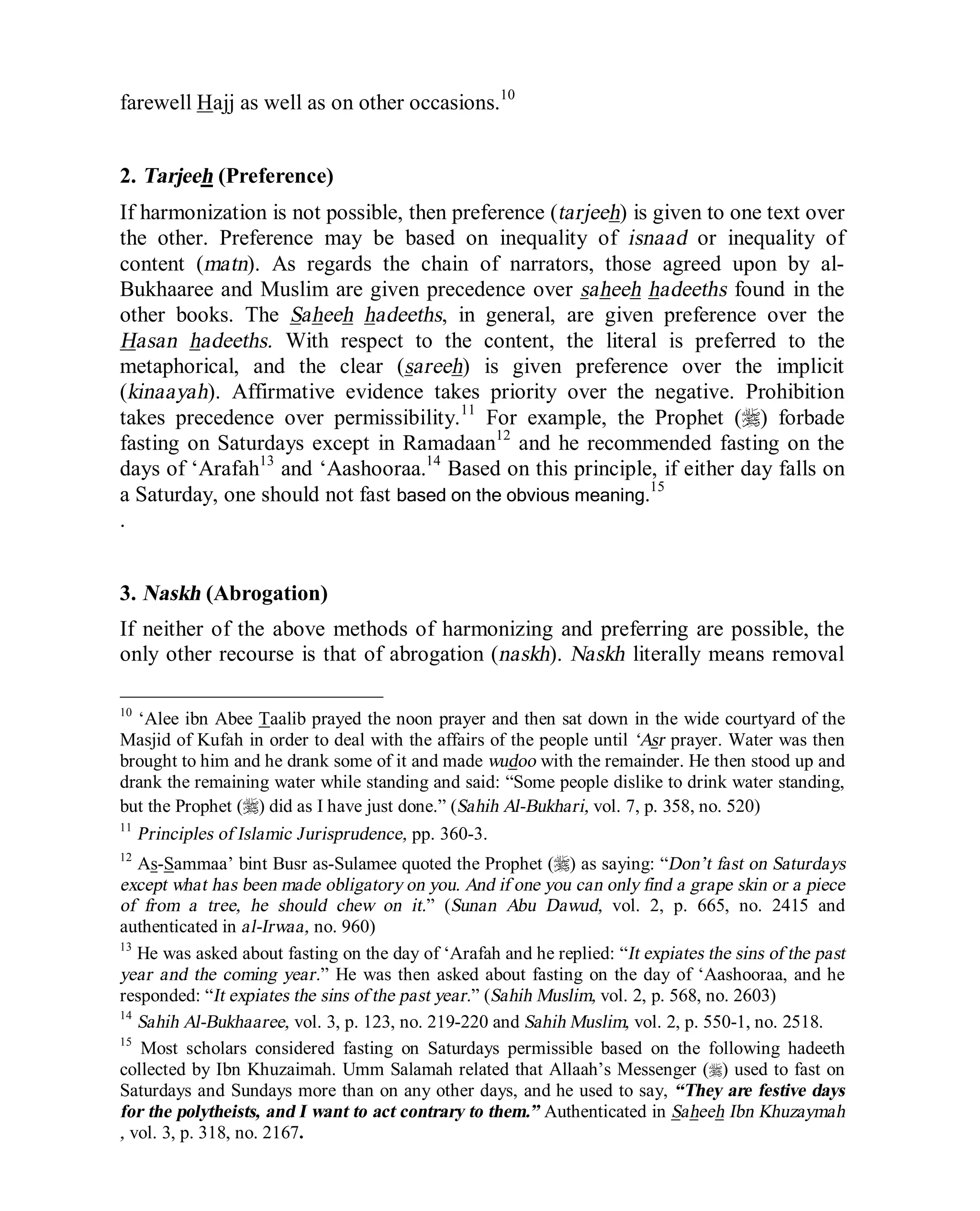
![© Islamic Online University Usool al-Hadeeth 101
http://www.islamiconlineuniversity.com 6
or transfer (that is why in Arabic a copyist is called Naasikh). As a technical term
in hadeeth science and Fiqh, it means Allaah’s abrogation of an earlier law by a
later one. Abrogation may occur in Qur’aanic verses and between the Qur’aan and
hadeeth. The abrogation of hadeeths is considered as a final means of resolving
apparent contradictions in hadeeth texts.
The Methods of Recognition
1. Abrogation can sometimes be recognised by a clear statement of the Prophet
(r) to that effect. An example of this can be found in Buraydah’s hadeeth
collected by Muslim that the Prophet (r) said, “I used to forbid from visiting
graves but now you should visit them as surely they are reminders of the next
life.”16
2. Sometimes it may appear as an Athar (statement of a Sahaabee). For example,
Jaabir ibn ‘Abdillaah said, “The latter of the two commands of Allaah’s
Messenger was to not do wudoo from (eating) things touched by fire (i.e.
cooked things).” Collected by at-Tirmithee, Aboo Daawood, an-Nasaa’ee and
Ibn Maajah.17
3. Occasionally the date of the incidents may point out the abrogation of a law.
For example in Shidaad ibn Anees’ hadeeth from the Prophet (r) that he said,
“The cupper18
and the cupped have broken fast.” Collected by Aboo
Daawood19
is abrogated by Ibn ‘Abbaas’ hadeeth in which the Prophet (r)
was cupped while fasting in a state of Ihraam.20
In some of the narrations of
Shidaad’s hadeeth it is mentioned that it was at the time of the conquest of
Makkah, i.e. 8 A.H. (630 CE). While in Ibn ‘Abbaas’ narration it was
mentioned that he accompanied the Prophet (r) during the Farewell
Pilgrimage, i.e. 10AH (632 CE).
4. The Ijmaa‘ of the Sahaabah can also indicate abrogation. Not that they
abrogated it but that it was known amongst them that the Prophet (r) had
abrogated it. An example can be seen in the case of the hadeeth in which the
Prophet (r) said, “Whoever takes intoxicants whip him (each time he is
16
Sahih Muslim, vol. 2, p. 463, no. 2131.
17
Sunan Abu Dawud, vol. 1, pp. 46-7, no. 192 and authenticated in Saheeh Sunan Abee Daawood,
vol. 1, p. 39, no. 177 [old edn.].
18
Cupping is a practice of drawing blood to the surface of the skin by making an incision and
creating a vacuum at the point. It is done for medicinal purposes.
19
Sunan Abu Dawud, vol. 2, p. 650, no. 2363 and authenticated in Saheeh Sunan Abee Daawood,
vol. 2, p. 451, no. 2075 [old edn.].
20
Saheeh Al-Bukhaaree, vol. 3, p. 91, no. 159.](https://image.slidesharecdn.com/usool-al-hadeeth-the-methodology-of-hadith-evaluation-130905043227-/75/Usool-al-hadeeth-the-methodology-of-hadith-evaluation-82-2048.jpg)
![© Islamic Online University Usool al-Hadeeth 101
http://www.islamiconlineuniversity.com 7
caught) but on the fourth occasion execute him.”21
The Sahaabah came to a
consensus of opinion that the intoxicated would not be executed.
21
Sunan Abu Dawud, vol. 3, pp. 1252-3, no. 4467-7 and authenticated in Saheeh Sunan Abee
Daawood, vol. 3, p. 848, no. 3763-4 [old edn.].](https://image.slidesharecdn.com/usool-al-hadeeth-the-methodology-of-hadith-evaluation-130905043227-/75/Usool-al-hadeeth-the-methodology-of-hadith-evaluation-83-2048.jpg)


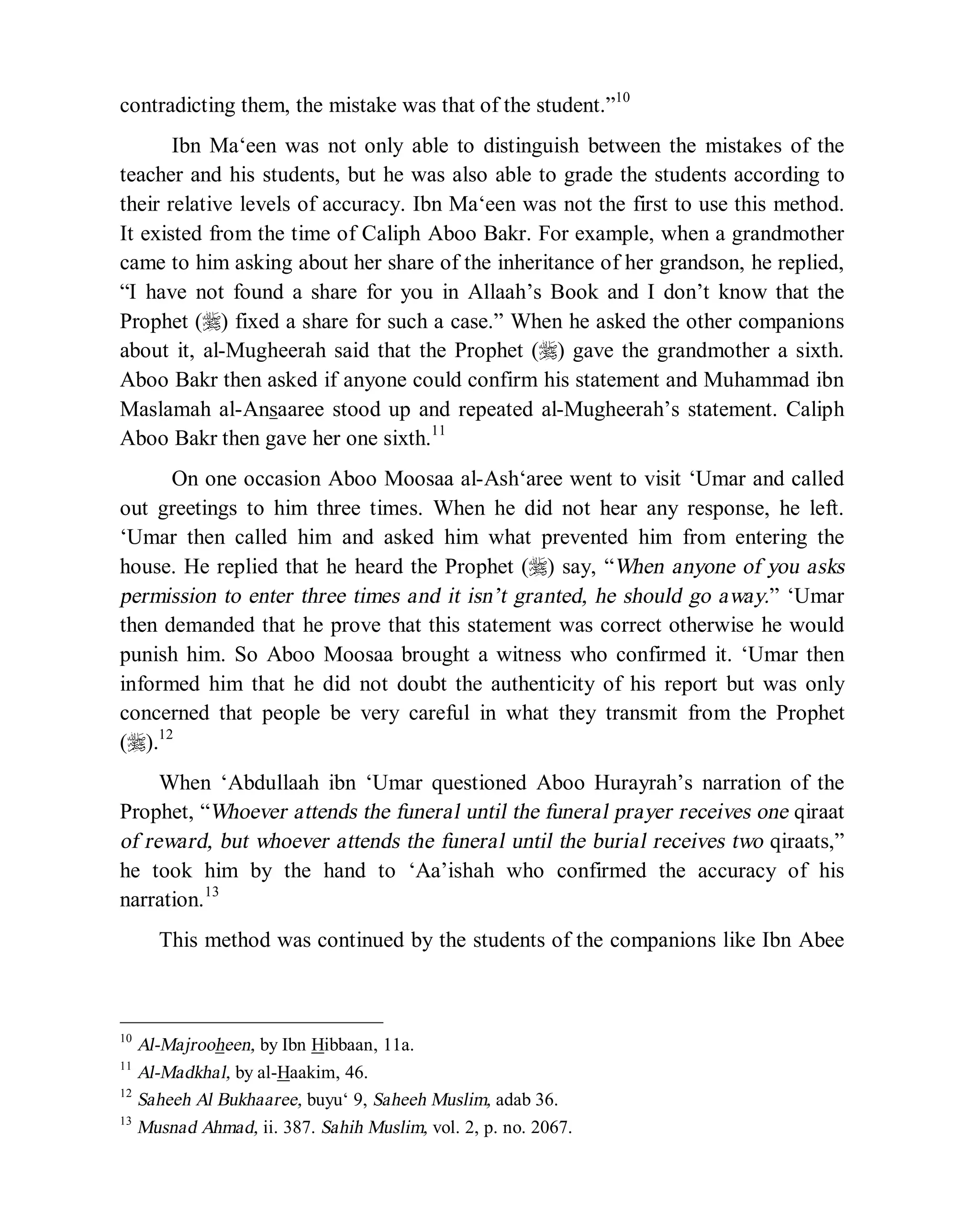


![© Islamic Online University Usool al-Hadeeth 101
http://www.islamiconlineuniversity.com 8
them in ash-Sha‘bee’s direction saying, “Woe be to you. How can you narrate that
when ‘Umar said, “We cannot abandon the Book of Allaah and the Sunnah of the
Messenger (r) for the words of a single woman. We don’t know whether she
remembered or forgot. There is maintenance and lodging for [the irrevocably
divorced woman.] Allaah, the Exalted and Majestic, said, “Do not expel them
from their houses, nor should they themselves leave, unless they have
committed clear indecency.” (Soorah at-Talaaq, 65: 1)20
This method was also applied by ‘Aa’ishah in several cases.
Rational Criticism of Hadeeth
The previously mentioned methods of comparison all involve rational thinking.
Reasoning was used by the hadeeth scholars in criticizing both the texts and
chains of narrators of hadeeths. It cannot be said that authentication was without
rational analysis. However, rational criticism does have its limits as ‘Alee ibn
Abee Taalib had said, “If the religion were based purely on [human] logic and
reason, the bottom of the sock has more right to be wipe than the top. However, I
saw the Messenger of Allaah wipe the bottom [and not the top].”21
The criticisms
of Modernist Muslims tend to be based on rational arguments. For example, the
hadeeth concerning the leadership of women is criticized based on the perceived
inherent equality of men and women. Similarly, Dr. Maurice Bucaille, in the end
of his excellent work, The Qur’an the Bible and Modern Science, argues that the
hadeeth of the fly must be false because modern science only know of disease
coming from flies. Were the same arguments used concerning the prohibition of
sleeping on the stomach due to medical arguments prior to the seventies, they
would have all been proven wrong by medical knowledge of the past two decades.
Era Classification of Narrators
Scholars of hadeeth, in the early stages of the development of the hadeeth
sciences, classified the narrators and collectors of hadeeths into various
20
Saheeh Muslim, vol. 2, p. 772, no. 3524.
21
Sunan Abu Dawud, vol. 1, p. 40, no. 162, and authenticated in Saheeh Sunan Abee Daawood,
vol. 1, p. 33, no. 147.](https://image.slidesharecdn.com/usool-al-hadeeth-the-methodology-of-hadith-evaluation-130905043227-/75/Usool-al-hadeeth-the-methodology-of-hadith-evaluation-89-2048.jpg)






![© Islamic Online University Usool al-Hadeeth 101
http://www.islamiconlineuniversity.com 5
practical legal matters, a preferable conjecture is sufficient as a basis of
obligation.’8
Ahaad as Evidence in ‘Aqeedah
Regarding the use of hadeeth as evidence, the Egyptian Jurist, Aboo Zahrah,
claimed that according to the majority of scholars the aahaad should not be relied
upon as the basis of belief (‘aqeedah).9
However, the texts of the Qur’aan and the
Sunnah, the way of the Companions and the sayings of scholars are all clear
evidence to the necessity of accepting hadeeth aahaad in all matters of religion,
whether laws or ‘aqeedah. To differentiate between them is an innovation
(bid‘ah) unknown among the Salaf. This is why Ibn al-Qayyim said: “This
differentiation is false, according to the consensus of the Ummah (the Muslim
nation). This Ummah used to accept, and still does, these hadeeths in matters of
the unseen (matters of ‘Aqeedah), the same way it accepts them in matters of laws
and actions. The reason being that even legal matters contain reports about Allaah
commanding such and such, and prescribed it as a necessity of the religion. His
laws and religion are a reflection of His Names and Attributes. The Companions,
the Successors, their followers and followers of hadeeth and Sunnah, all accepted
these reports in matters of the Divine Attributes, predestination, the Names (of
Allaah) and in laws. It has never been reported from any of them, that they
accepted [hadeeth aahaad] only in matters of laws and not in matters of Allaah,
His Names or His Attributes. Therefore, where are the Salaf of those who
differentiate between these two [‘Aqeedah and Laws]? Yes, indeed. Their Salaf
are some of Ahlul-Kalaam10
of later generations. These people had no interest in
what Allaah, His Messenger and the Companions have said. They hinder people’s
hearts from following the guidance of the Qur’aan, the Sunnah and the sayings of
the Companions regarding such matters. Instead, they refer to the sayings of
Ahlu1-Kalaam and the principles of those who seek to complicate matters... They
8
Badraan, Usool, p. 91; Khudaree, Usool, p. 227.
9
Aboo Zahrah, Usool, p. 85. “As for the aahaad pertaining to subsidiary matters which are not
essential to dogma such as the torture of the grave, intercession, etc., these must be accepted and
believed. Anyone who denies them is a sinner but not a disbeliever, as he denies something which
is not decisively proven.” (Kamali, p. 85)
10
Scholastic theologians and philosophers.](https://image.slidesharecdn.com/usool-al-hadeeth-the-methodology-of-hadith-evaluation-130905043227-/75/Usool-al-hadeeth-the-methodology-of-hadith-evaluation-96-2048.jpg)

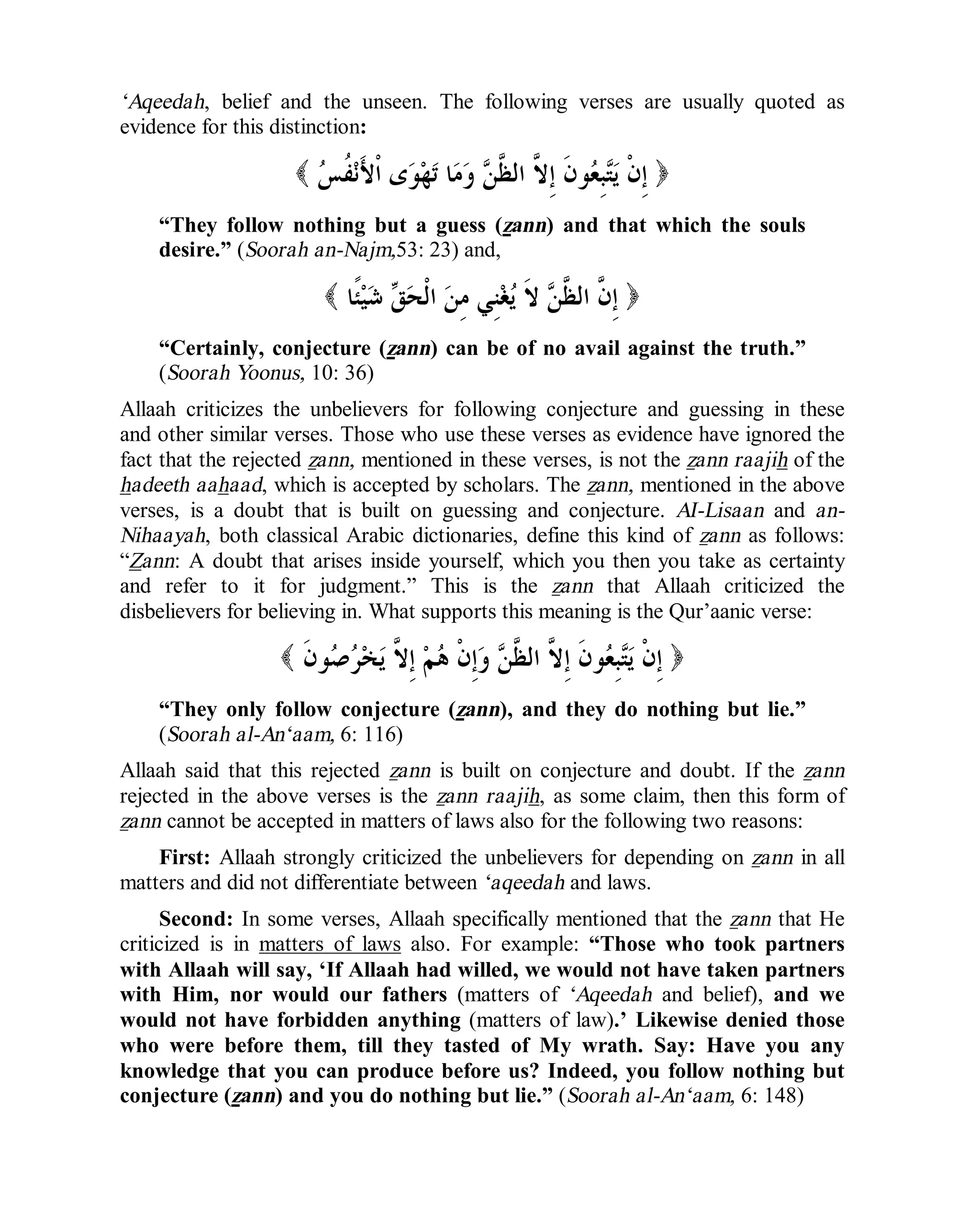
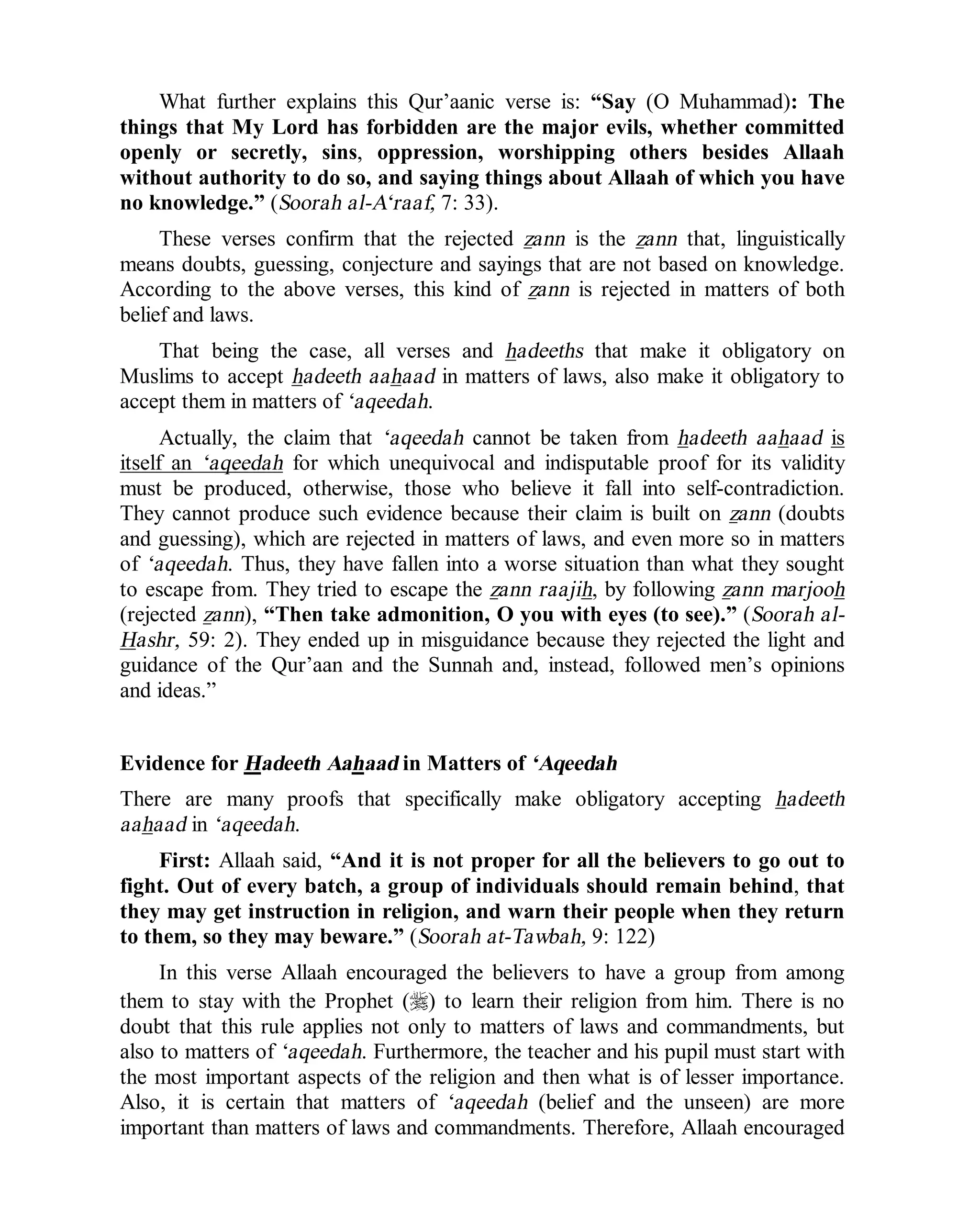

![© Islamic Online University Usool al-Hadeeth 101
http://www.islamiconlineuniversity.com 10
Bukhaaree - the most correct book after Allaah’s Book, the phrase: ‘The
Messenger of Allaah (r) said…’ [The term “said”] is an expression of certainty,
otherwise [Imaam al-Bukhaaree] would have said: ‘The Messenger of Allaah (r)
was reported to have said…’ Likewise, many hadeeths narrated by the
Companions contain the phrase: ‘The Messenger of Allaah (r) said...’ even
though the Companion who narrated the hadeeth only heard it from another
companion, and not directly from the Prophet (r). The statement, ‘the Prophet
(r) said...’, is a testimony from the narrator that he accepts, with certainty, that
the Messenger (r) did or said what the report says he did or said. If the aahaad
report does not lead to certainty, then the Companion or the narrator has followed
that which he has no knowledge of and used it as proof coming from the
Messenger (r).” (I‘laam al-Muwaqqi‘een).
Fourth: The Sunnah of the Messenger (r) and his Companions confirm that
aahaad reports are acceptable in matters of ‘aqeedah. The Sunnah of the
Messenger (r) and his Companions, during the Messenger’s life and after his
death, unequivocally confirm that there is no difference between ‘aqeedah and
laws, if both are narrated in hadeeth aahaad. The Sunnah confirms that the
hadeeth aahaad is a proof in itself in all matters of belief and law. The following
are some examples of authentic hadeeths that prove this point:
Imaam al-Bukhaaree wrote [in his book]: “Chapter: Accepting the aahaad
report by a truthful man in Athaan, prayer, fasting, inheritance and laws, and
Allaah’s saying: “Out of every batch, a group of individuals should remain
behind, that they may get instruction in religion, and warn their people when
they return to them, so they may beware.” (Soorah at-Tawbah, 9: 122)
A single man may be referred to as a group (taa’ifah) because Allaah said:
)ﺎﻤﻬﻨﻴﺑ ﻮﺍﺤِﻠﺻﹶﺄﹶﻓ ﹸﻮﺍﻠﺘﺘﹾﻗﺍ ﲔِﻨِﻣﺆﻤﹾﻟﺍ ﻦِﻣ ِﻥﺎﺘﹶﻔِﺋﹶﺂﻃ ﹾﻥِﺇﻭ(
“And if two groups among the believers fight, reconcile between
them...” (Soorah al-Hujuraat, 49: 9).
If two individual men fought each other, they are also addressed by this Qur’aanic
verse. Also, “O you who believe! If a corrupt person comes to you with a
news, verify it.” (Soorah al-Hujuraat, 49: 6) The Prophet (r) continuously sent
governors to the provinces and leaders for the armies, one after another. If one of
them forgot the Sunnah, he would be reminded of it and would have to accept it
without verification.”11
11
Saheeh Al-Bukhaaree,](https://image.slidesharecdn.com/usool-al-hadeeth-the-methodology-of-hadith-evaluation-130905043227-/75/Usool-al-hadeeth-the-methodology-of-hadith-evaluation-101-2048.jpg)
![© Islamic Online University Usool al-Hadeeth 101
http://www.islamiconlineuniversity.com 11
Afterwards, al-Bukhaaree narrated many hadeeths to support the acceptance
aahaad reports. He wanted to prove that aahaad reports must be adhered to and
accepted with certainty. The following are some of these hadeeths followed by
my explanation:
1. Maalik ibn al-Huwayrith said: “Some young men of around the same age
came to the Prophet (r) and stayed with him for about twenty days. The
Messenger of Allaah (r) was very merciful and kind [to us]. When he felt that we
missed our families and felt homesick, he asked us about those [of our families]
whom we left behind, and we told him about them. He then said: Go back to your
families and stay with them, teach them, instruct them [to do good] and pray as
you saw me pray.”12
The Messenger (r) ordered each one of these young men to teach his family.
Teaching contains matters of belief The first of what is contained in the meaning
of teaching must be about ‘Aqeedah. If aahaad report was not accepted, then this
order of the Prophet (r) would have been empty of any meaning.
2. Anas ibn Maalik said that people of Yemen came to the Messenger of
Allaah (r), saying: “Send someone with us to teach us Islaam and the Sunnah.”
The Messenger (r) took hold of Aboo ‘Ubaydah’s hand and said: “This is the
trusted man of this Ummah.”13
If aahaad reports were not accepted with certainty, then the Prophet (r)
would not have sent Aboo Ubaydah by himself to Yemen. The same can be said
about other occasions when the Prophet (r) sent other companions, like ‘Alee,
Mu‘aath and Aboo Moosaa al-Ash‘aree, to Yemen and other provinces. There is
no doubt that these emissaries of the Prophet (r) taught those who received them
‘aqeedah along with other matters of the religion. If their reports were not
accepted and were not a proof against those who received these Companions, the
Prophet (r) would not have sent them one after another, as this would have been
a wasted effort. The Messenger of Allaah (r) would never fall into such a
situation as this. And this is what Imaam ash-Shafi‘ee meant when he said, in his
book, ar-Risaalah: “The Prophet (r) would not send anyone carrying his
instructions, unless the report of the one carrying the message was certain proof,
either for or against those who received it. He could have sent for them and
addressed them directly. Or he could have sent many Companions. Instead, he
sent to them a single Companion who was known to be trustworthy.
12
Sahih Al-Bukhari, vol. 1, p. 345, no. 604.
13
Saheeh Muslim and Saheeh Al-Bukhaaree](https://image.slidesharecdn.com/usool-al-hadeeth-the-methodology-of-hadith-evaluation-130905043227-/75/Usool-al-hadeeth-the-methodology-of-hadith-evaluation-102-2048.jpg)
![© Islamic Online University Usool al-Hadeeth 101
http://www.islamiconlineuniversity.com 12
3. ‘Abdullaah ibn ‘Umar said: “While the inhabitants of Qubaa where praying
Fajr, a man came to them and said: ‘[Verses of the] Qur’aan have been revealed to
the Messenger (r) tonight, and he was ordered to face the Ka‘bah [during
prayer], so face it.’ Their faces were towards Shaam, but they turned [their faces]
towards Ka’bah.”14
This hadeeth is textual evidence that the Companions accepted the aahaad
report that nullified facing Jerusalem during prayer… If they did not accept the
aahaad report with certainty, why would they contradict what they knew for
certain concerning their original prayer direction? Ibn al-Qayyim noted:
“Furthermore, the Messenger of Allaah (r) did not criticize them. On the
contrary, they were praised for this action.”
4. Sa‘eed ibn Jubayr related that he informed Ibn ‘Abbaas that Nawf al-
Bakkali was claiming that Moses, the companion of al-Khidr, was not Moses of
the Israelites. Ibn ‘Abbaas replied: “That enemy of Allaah has lied. Ubayy ibn
Ka‘b informed me that the Messenger of Allaah (r) stood and said...” and he
mentioned the hadeeth of Moses and al-Khidr in a way that proves that Moses
[sent to the Children of Israel] was the same Moses who accompanied al-Khidr.15
Ash-Shaafi‘ee said: “Ibn ‘Abbaas, as knowledgeable and pious as he was,
accepted the report by Ubayy ibn Ka‘b from the Messenger of Allaah (r). He
even called a Muslim a liar. This is because Ubayy ibn Ka‘b told him from the
Prophet (r) what clearly indicates that Moses, who was sent to the Children of
Israel, was the same one who accompanied al-Khidr.”
The above saying by Imaam ash-Shaafi‘ee is clear evidence that he did not
differentiate between ‘aqeedah and laws with regards to aahaad reports. To
decide whether Moses, of the Children of Israel, was the companion of al-Khidr
or not, is a matter of the unseen and not a matter of laws and actions, as is evident.
What further supports this conclusion, is that ash-Shaafi‘ee included an important
chapter in his book, ar-Risaalah, entitled “Chapter: Evidence for the Necessity of
Accepting the Aahaad Report.” In this chapter, he introduced many general
proofs from the Qur’aan and the Sunnah which confirm that the aahaad report
must also be accepted in matters of ‘aqeedah. Furthermore, the Imaam’s
explanations of these proofs are general and include accepting hadeeth aahaad in
matters of ‘aqeedah. He ended the chapter with the following statement: “There
are many hadeeths, with regards to accepting the aahaad report. I have introduced
sufficient evidence to this fact. This is the way of our Salaf, and the generations
that followed, until our current generation. This is the [correct] way. Also, this
14
Saheeh Al-Bukhaaree, and Saheeh Muslim.
15
Saheeh Al-Bukhaaree and Saheeh Muslim.](https://image.slidesharecdn.com/usool-al-hadeeth-the-methodology-of-hadith-evaluation-130905043227-/75/Usool-al-hadeeth-the-methodology-of-hadith-evaluation-103-2048.jpg)
![© Islamic Online University Usool al-Hadeeth 101
http://www.islamiconlineuniversity.com 13
[understanding] is what has been reported to us from scholars in other countries.”
The meaning of this statement is general enough to include the acceptance of
aahaad reports in matters of ‘aqeedah.
Ash-Shaafi‘ee also said: “If anyone were permitted to say that all Muslim
scholars of the past and present, without exception, have agreed to accept the
aahaad report and adhere to it, I would be the one to do so. However, I can only
say: I do not know of any Muslim scholar who disagreed on the matter of
accepting the aahaad report.’ ”16
Ibn al-Qayyim further said: “Some of them say: ‘The major matters (usool)
are matters concerning the unseen (‘aqeedah), and the minor matters (furoo‘) are
matters concerning laws.’ This is, indeed, a false claim. Two basics are required
in matters of laws: Knowledge [that Allaah revealed the law and made it
obligatory] and adherence. The same basics are required for matters of the unseen.
Adherence in matters of the unseen can be attained by the love, or hatred, felt by
the heart. The heart must feel love for the truth that these reports of the unseen
contain, and hatred for misguidance that opposes what they contain. Actions are
not only required of the limbs. On the contrary, action taken by the limbs follows
actions taken by the heart. Actions of the heart are the basis for actions performed
by the limbs. All matters of the unseen require belief, acceptance and love felt in
the heart for them. These are all actions of the heart and this is the basis of all
actions of the limbs. This is a fundamental principle concerning matters of belief
that so many people of Ahlul-Kalaam have ignored. They considered belief to
consist of matters of acceptance but not matters of action!
The above error is a major mistake. Many disbelievers believed that the
Prophet (r) was truthful and they did not doubt this fact. This belief, however,
was not coupled with the actions that must be taken by the heart; loving what the
Messenger (r) was sent with, accepting, approving and being loyal to it, and
disassociation from those who defy it. Do not ignore this subject because it is very
important, and, by knowing it, you will understand the essence of eemaan.
All matters of belief contain actions, and all matters of actions contain belief
The Legislator [Allaah] did not require only the performance of actions without
belief, nor did He require only the belief in matters of the unseen, without
actions.”
What we can understand from what Ibn al-Qayyim has explained above, is
that differentiating between ‘aqeedah and laws is false according to the consensus
16
The Hadith is Proof, pp. 55-82.](https://image.slidesharecdn.com/usool-al-hadeeth-the-methodology-of-hadith-evaluation-130905043227-/75/Usool-al-hadeeth-the-methodology-of-hadith-evaluation-104-2048.jpg)


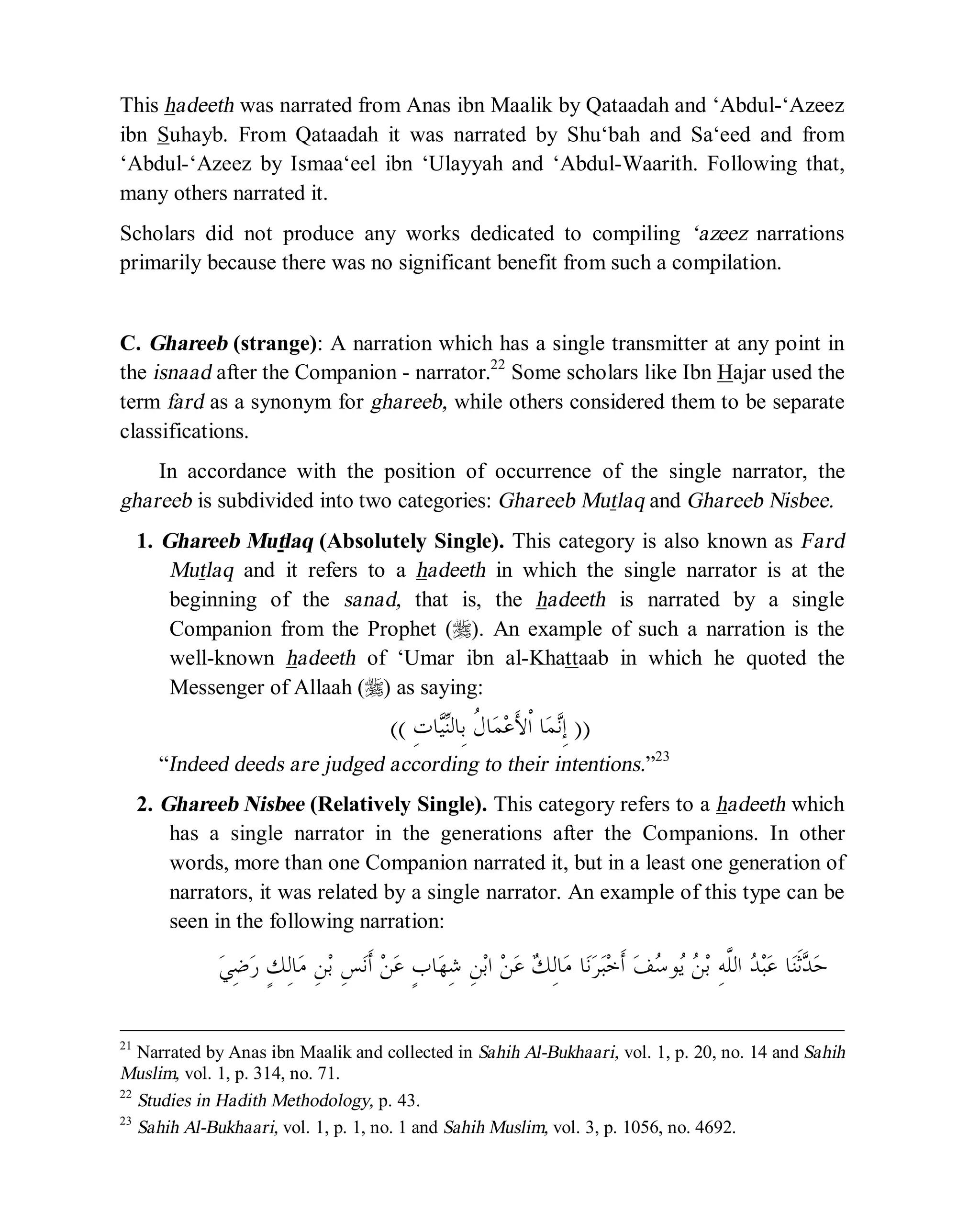
![© Islamic Online University Usool al-Hadeeth 101
http://www.islamiconlineuniversity.com 17
ِﻪﱠﻠﺍﻟ ﹶﻝﻮﺳﺭ ﱠﻥﹶﺃ ﻪﻨﻋ ﻪﱠﻠﺍﻟﱠﻰﻠﺻﺧﺩ ﻢﱠﻠﺳﻭ ِﻪﻴﹶﻠﻋ ﻪﱠﻠﺍﻟِﻪِﺳﹾﺃﺭ ﹶﻰﻠﻋﻭ ِﺢﺘﹶﻔﹾﻟﺍ ﻡﺎﻋ ﹶﻞ
ﺮﹶﻔﻐِﻤﹾﻟﺍَﺀﺎﺟ ﻪﻋﺰﻧ ﺎﻤﹶﻠﹶﻓﹲﻞﺟﺭِﺔﺒﻌﹶﻜﹾﻟﺍ ِﺭﺎﺘﺳﹶﺄِﺑ ﻖﱢﻠﻌﺘﻣ ٍﻞﹶﻄﺧ ﻦﺑﺍ ﱠﻥِﺇ ﹶﻝﹶﺎﻘﹶﻓﹶﻝﹶﺎﻘﹶﻓ
ﻩﹸﻮﻠﺘﹾﻗﺍ
Maalik from Ibn Shihaab from Anas ibn Maalik that the Messenger of
Allaah entered [Makkah] in the year of the Conquest wearing a helmet.
When he removed it, a man came and said that Ibn Khatal was clinging
to the curtain of the Ka‘bah. He said: “Kill him.”24
Imaam Maalik was the single narrator of this hadeeth from Ibn Shihaab az-
Zuhree and he was from the generation of the students of the Successors.
The category of Ghareeb Nisbee may be applied to a hadeeth for a variety
of other reasons.
a) A single narrator who is graded Thiqah (reliable)
b) A specific single narrator from another specific single narrator. Hadeeth
scholars say: So-and-so is the sole narrator from so-and-so.
c) Single narrations from people of a specific town or region. Hadeeth
scholars say: The sole narrators of this hadeeth are the people of
Makkah or Syria.
d) Narrations by people of a specific area from other people of a specific
area.
The most well-known text written on Ghareeb hadeeths is that of Imaam ad-
Daaraqutnee called Gharaa’ib Maalik.
The Fiqh Value of Hadeeth Aahaad
With regard to the use of aahaad as evidence, Aboo Haneefah added the
condition that the narrator’s action should not contradict his narration. On the
basis of this principle, Aboo Haneefah rejected the hadeeth of Aboo Hurayrah in
which he quoted the Prophet (r) as saying, “If a dog licks one of your dishes,
wash it seven times, one of which with clean earth.”25
Since the requirement of
washing is normally three times, the report is considered weak, including its
attribution to Aboo Hurayrah.26
On the other hand, the majority of scholars took
24
Sahih Al-Bukhaari, vol. 4, p. 176, Chapter 169.
25
Sahih Muslim, p. 41, no. 119.
26
Aboo Zahrah, Usool, p. 85.](https://image.slidesharecdn.com/usool-al-hadeeth-the-methodology-of-hadith-evaluation-130905043227-/75/Usool-al-hadeeth-the-methodology-of-hadith-evaluation-108-2048.jpg)





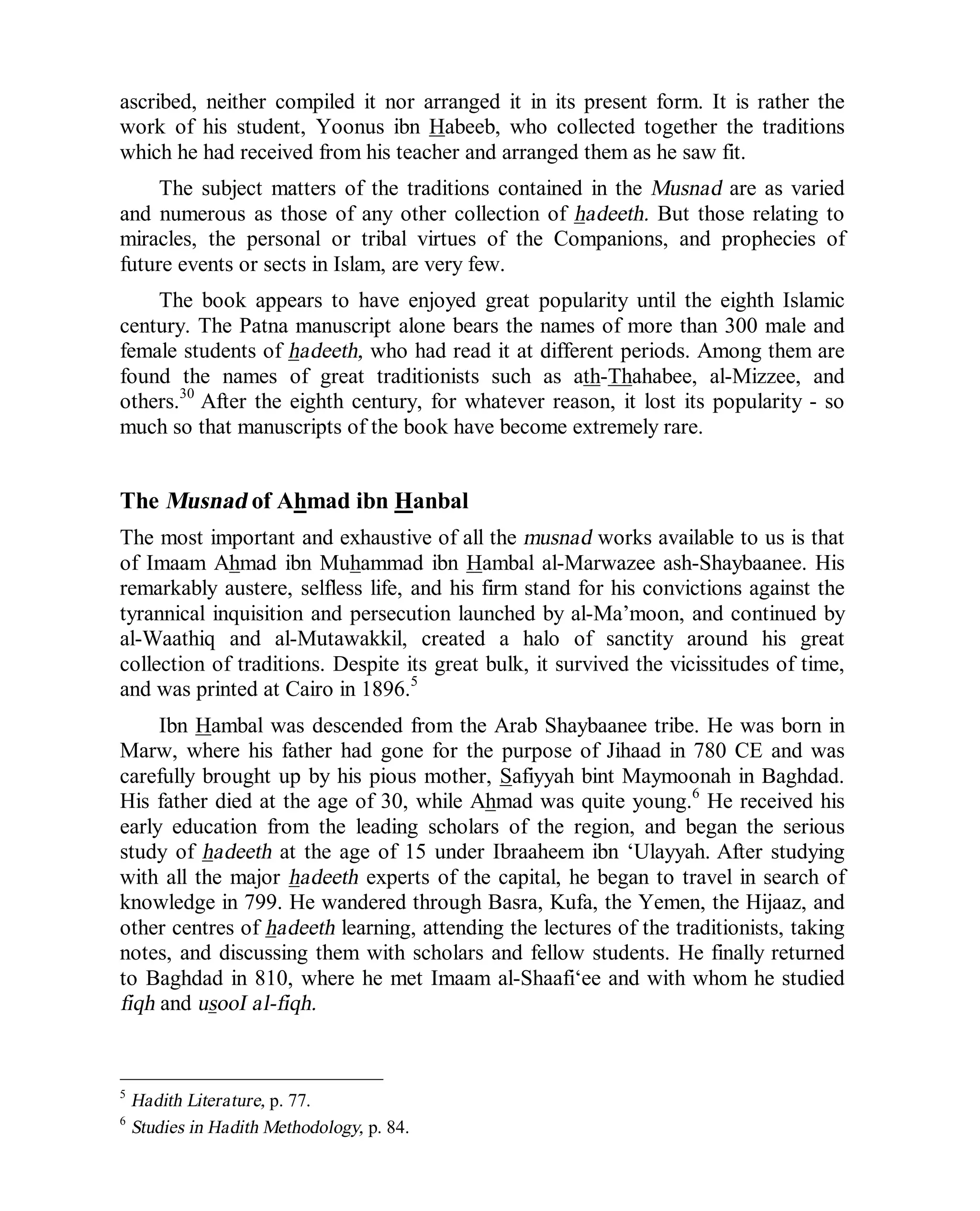

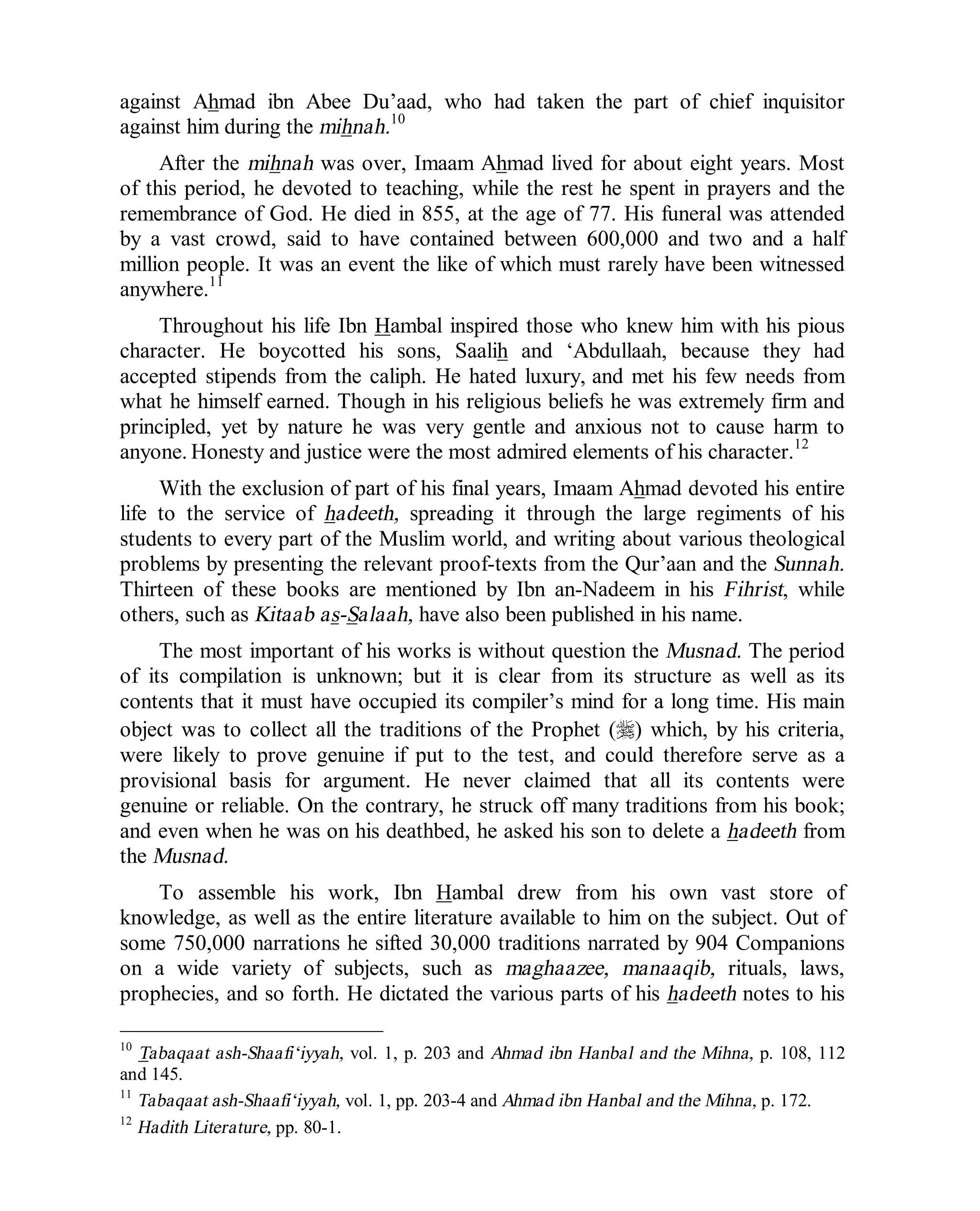

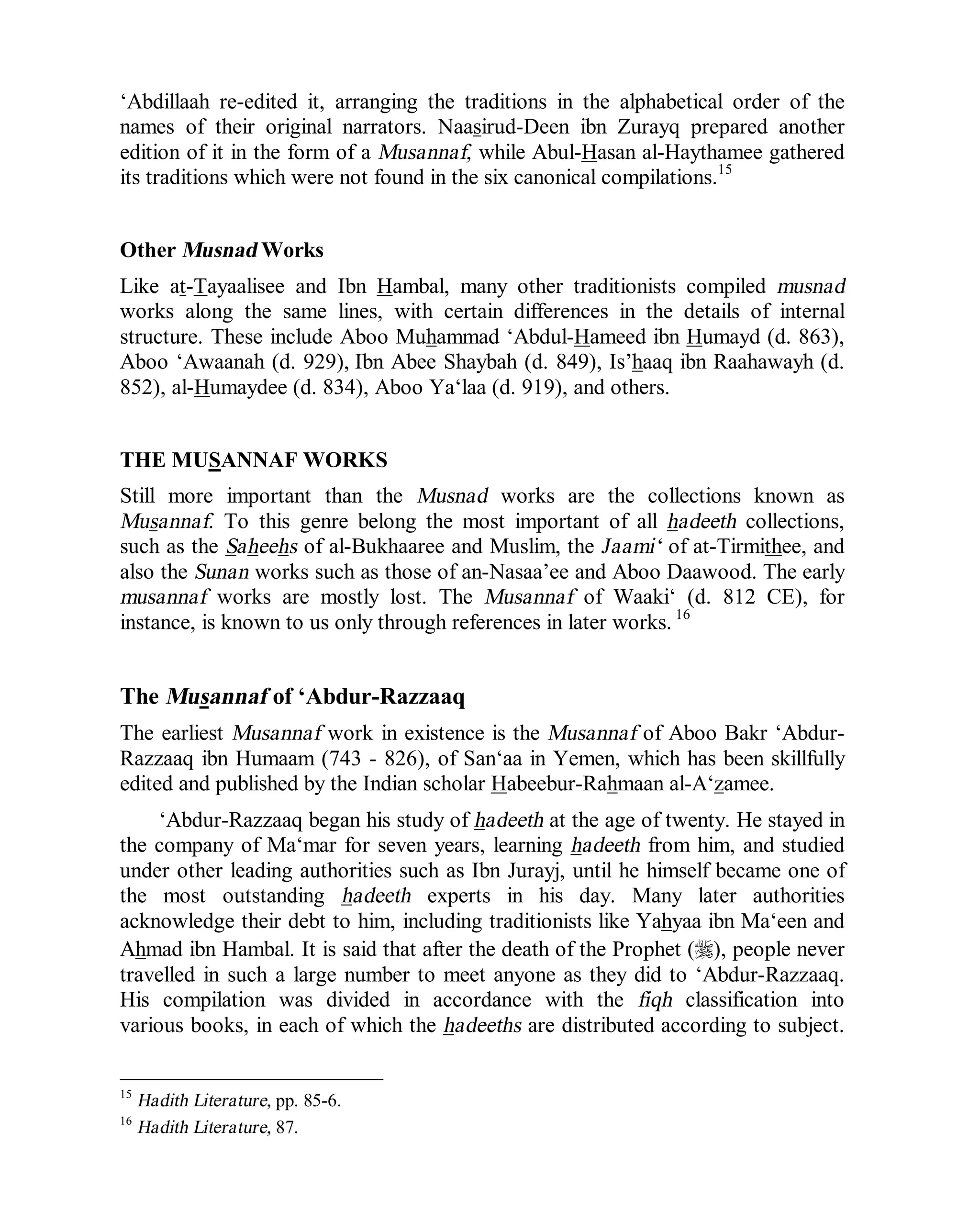
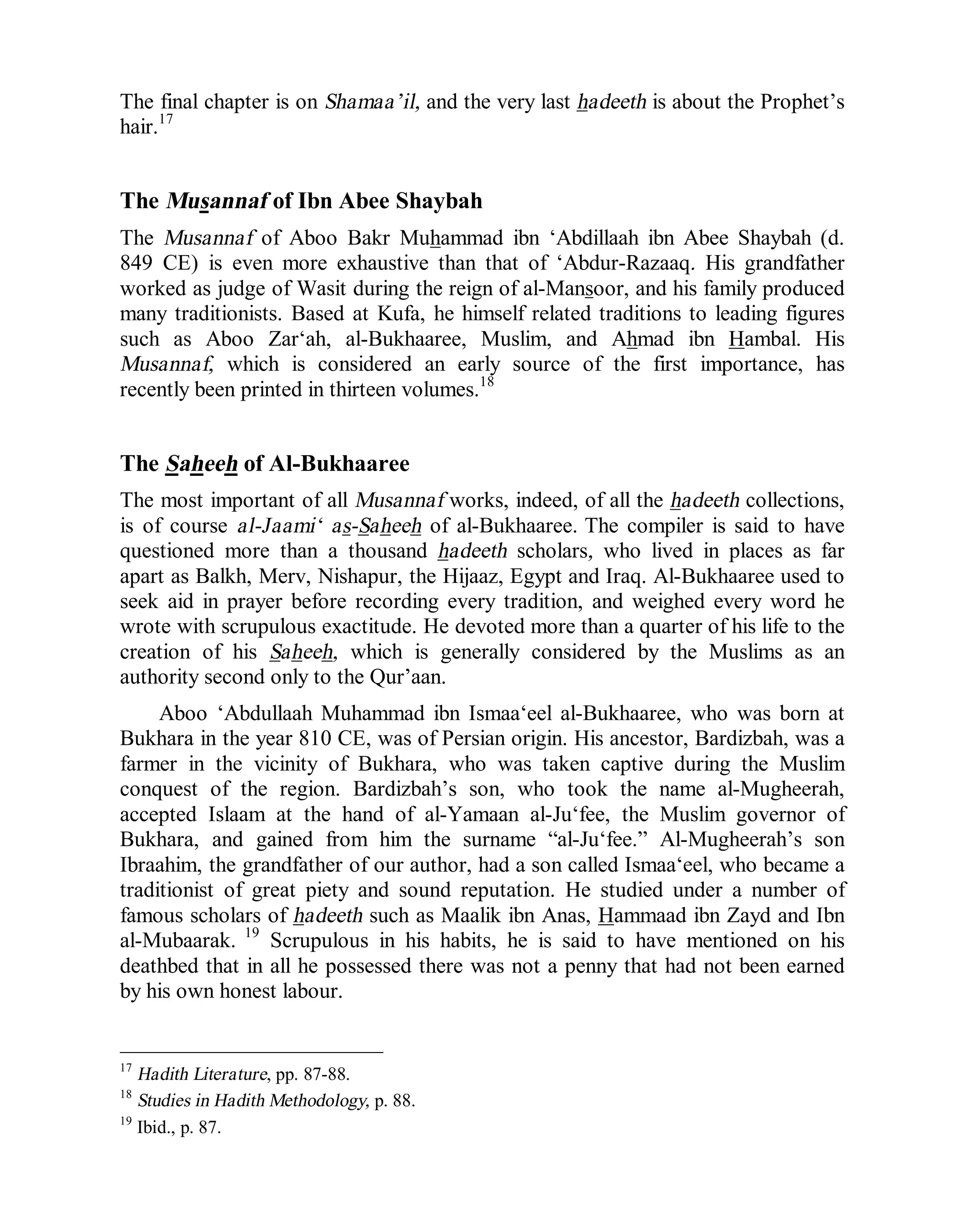
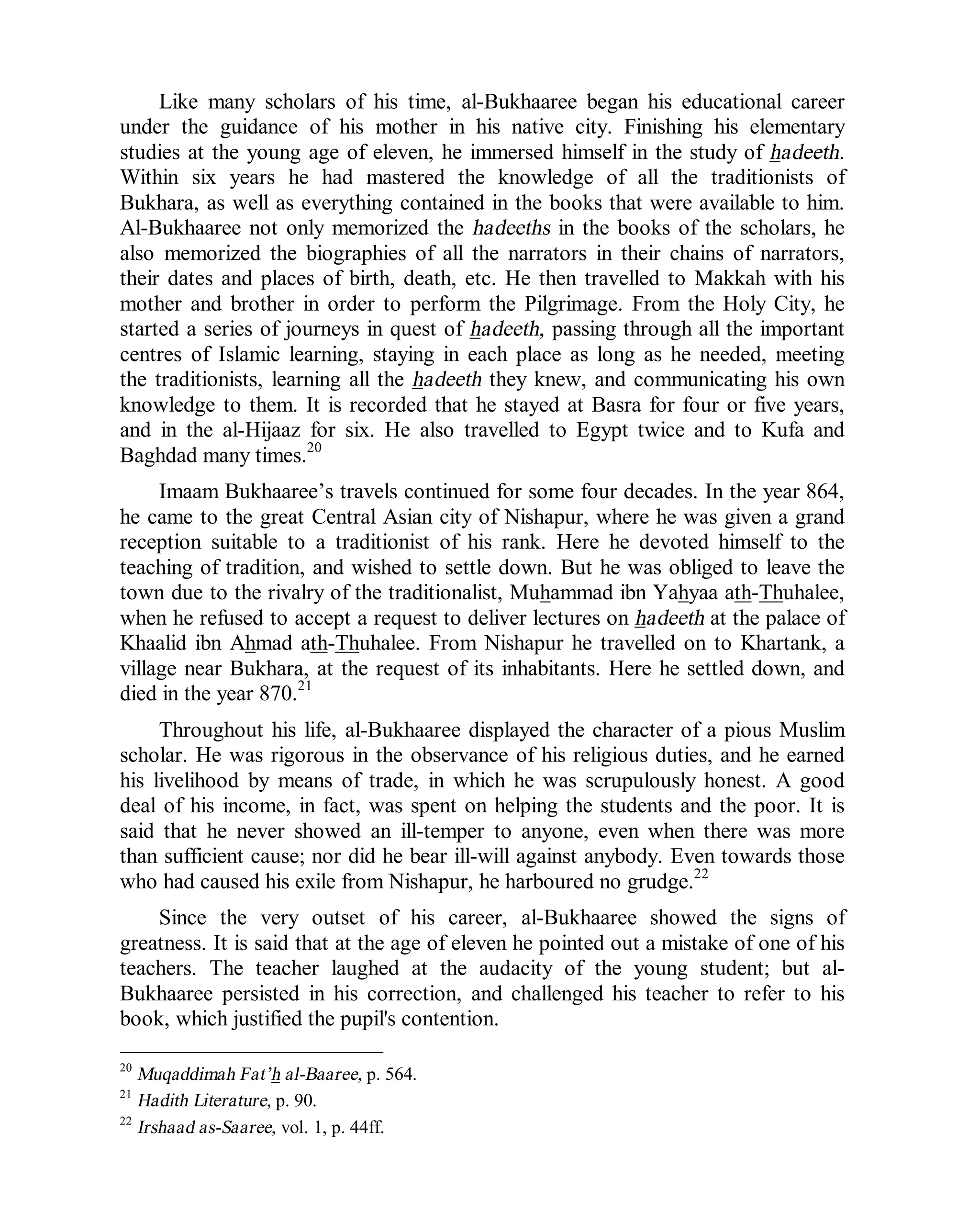
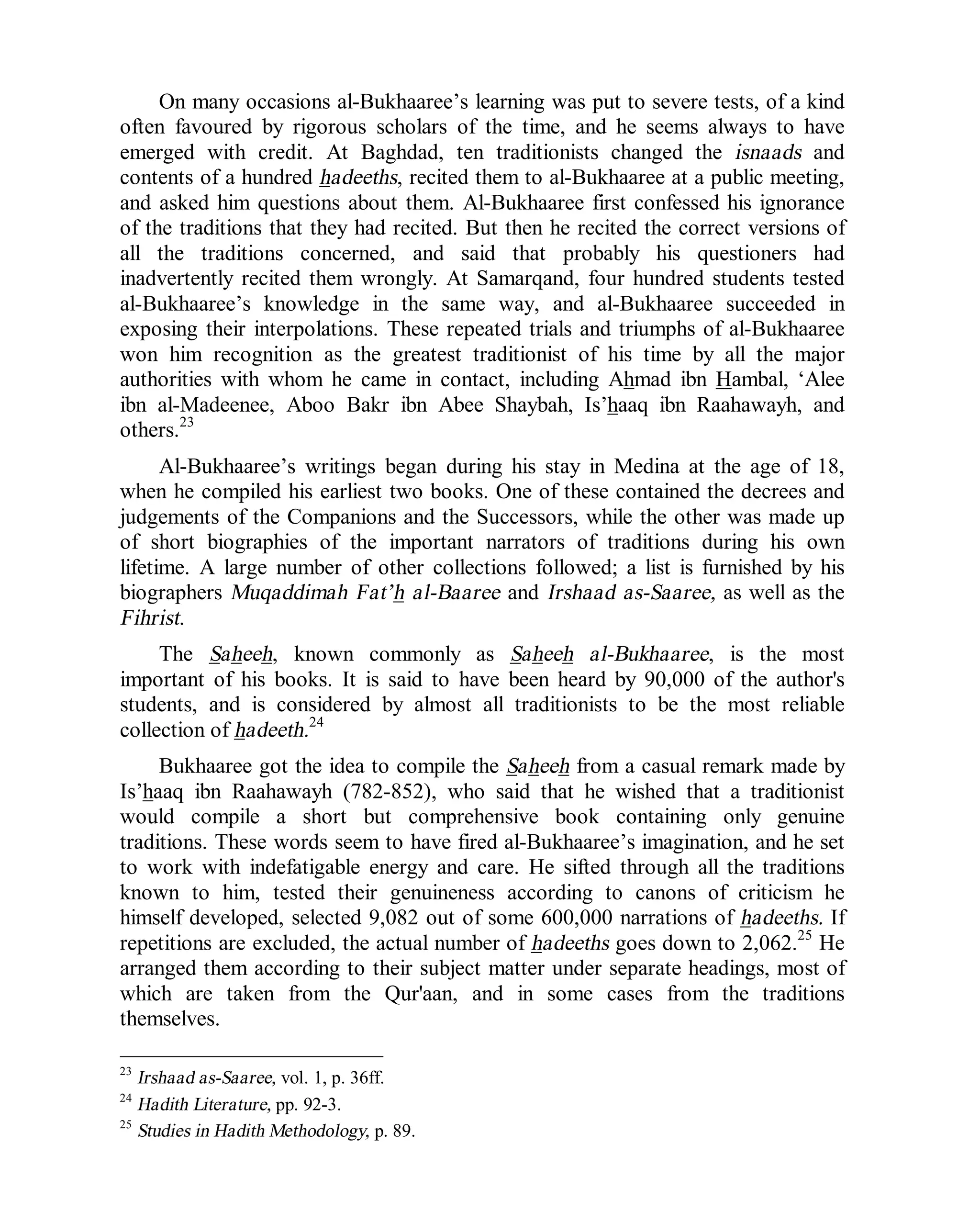


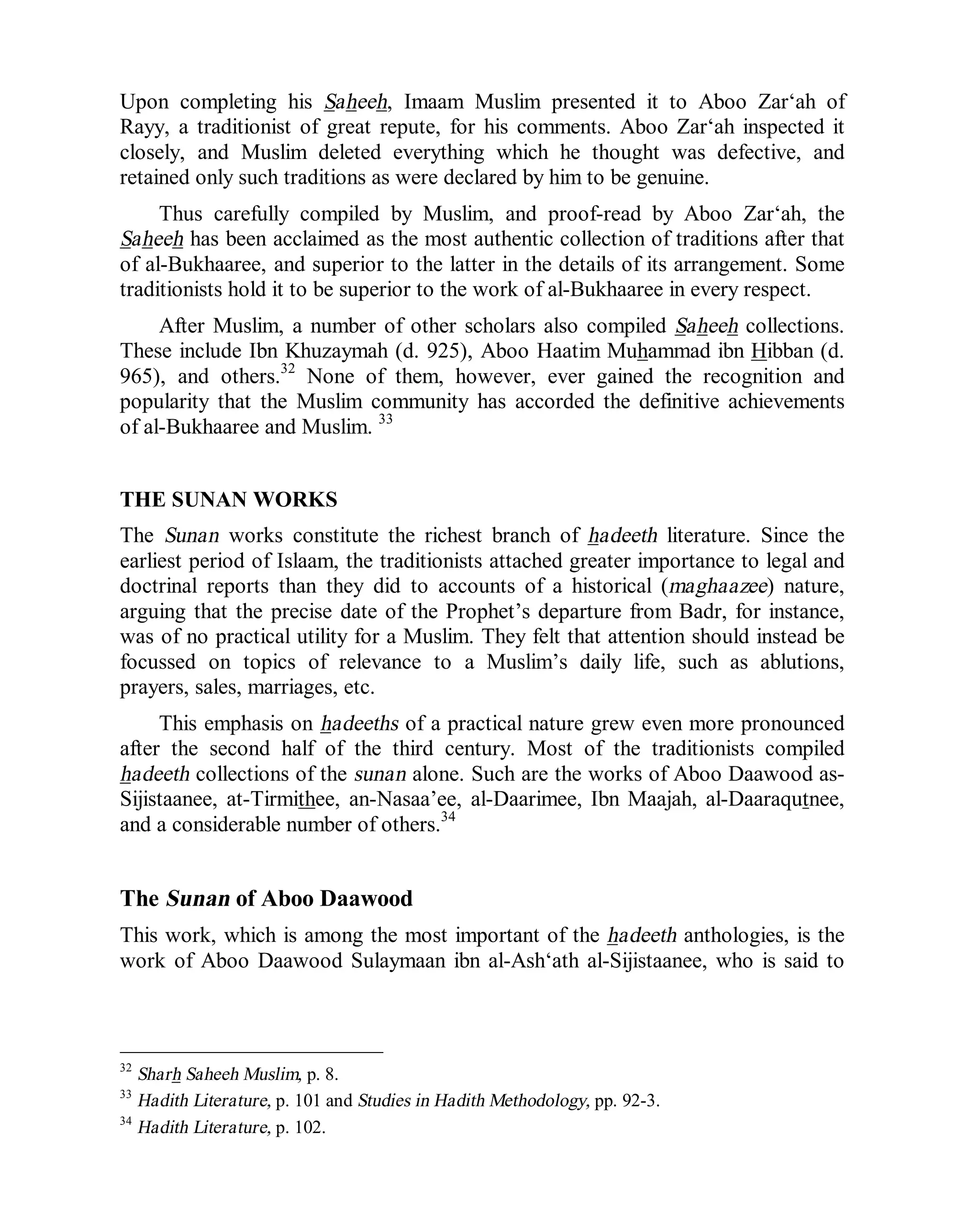

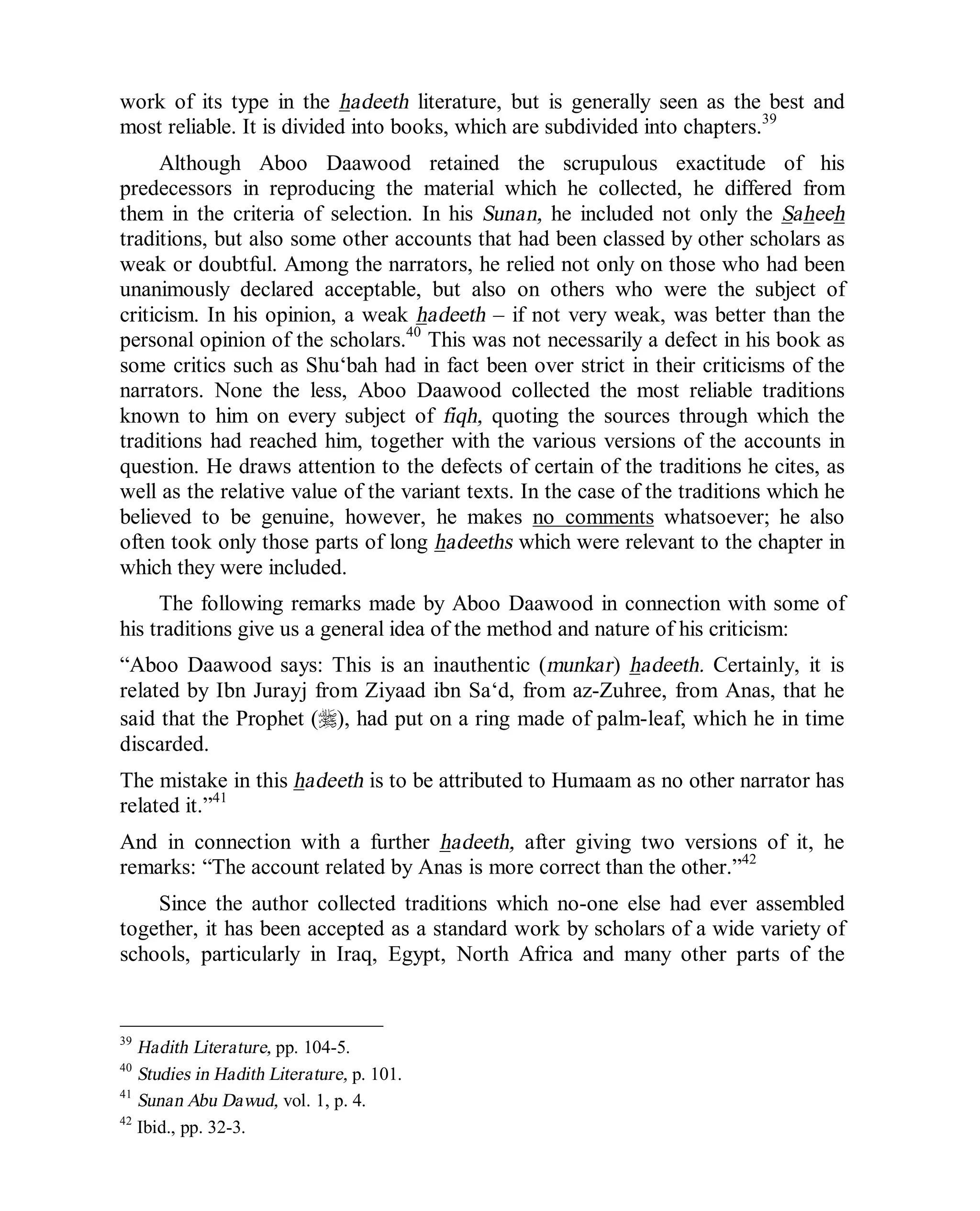

![© Islamic Online University Usool al-Hadeeth 101
http://www.islamiconlineuniversity.com 20
student's conduct. At-Tirmithee, however, explained that he remembered every
word of what had been dictated to him. The teacher was reluctant to believe him,
and challenged him to recite the traditions from his memory. At-Tirmithee
accepted this challenge, and proceeded to recite all the traditions without
committing a single mistake. At this, the teacher doubted his statement that he had
not been able to revise from his notes, and decided to test his student by reciting
forty other traditions, and ask at-Tirmithee to reproduce them. Without hesitation,
at-Tirmithee repeated what he heard verbatim, and his teacher, convinced now of
the truth of his statement, declared his pleasure and satisfaction at the young
man’s powers of retention.47
At-Tirmithee’s Jaami‘, assembled through the use of this gift, is recognised
as one of the most important works of hadeeth literature, and is unanimously
included among the six canonical collections of hadeeth. It contains altogether
3956 hadeeths.48
Not only did he take great pains to determine the identity,
names, titles and pet names of each narrator in the traditions he cited; he also
attempted to state the degree of reliability and how the jurists of the various
schools of law used them. He added a note to almost every hadeeth, prefaced with
the words, ‘Aboo ‘Eesaa says…’ He then proceeds to state a range of points
connected with the tradition. The following example will show the nature and
importance of these notes.
Qutaybah, Hannaad, Aboo Kurayb, Ahmad ibn Manee‘, Mahmood ibn Ghaylan
and Aboo ‘Ammaar have related to us saying that Wakee‘ related to them from al-
A‘mash, from Habeeb ibn Abee Thaabit, from ‘Urwah from ‘Aa’ishah that the
Prophet (r) once kissed one of his wives, and then went out to offer prayers
without performing ablution. ‘Urwah asked ‘Aa’ishah: “Who could that be but
yourself?” and ‘Aa’ishah laughed.49
Aboo ‘Eesaa says: “A similar tradition has been related by many of those
who possessed knowledge among the Companions and the Followers, and this is
the opinion of Sufyaan ath-Thawree and the jurists of Kufa, who hold that a kiss
does not invalidate one’s ablution. Maalik ibn Anas, al-Awzaa‘ee, al-Shaafi‘ee,
Ahmad [ibn Hambal] and Is’haaq [ibn Raahawayh], however, hold that a kiss
does invalidate ablution, and this is the opinion of many learned Companions and
Successors. Our people [Maalik, Ahmad et al.] did not follow the hadeeth related
by ‘Aa’ishah from the Prophet (r) because it did not appear to be genuine to
47
Hadith Literature, pp. 107-8.
48
Studies in Hadith Methodology, p. 103.
49
Sunan Abu Dawud, vol. 1, p. 43, no. 179, at-Tirmithee, an-Nasaa‘ee and Ibn Maajah, and in
Saheeh Sunan Abee Daawood, vol. 1, p. 36, no. 165, as well as by Ahmad Shaakir in Jaami‘as-
Saheeh, vol. 1, pp. 133-4.](https://image.slidesharecdn.com/usool-al-hadeeth-the-methodology-of-hadith-evaluation-130905043227-/75/Usool-al-hadeeth-the-methodology-of-hadith-evaluation-128-2048.jpg)





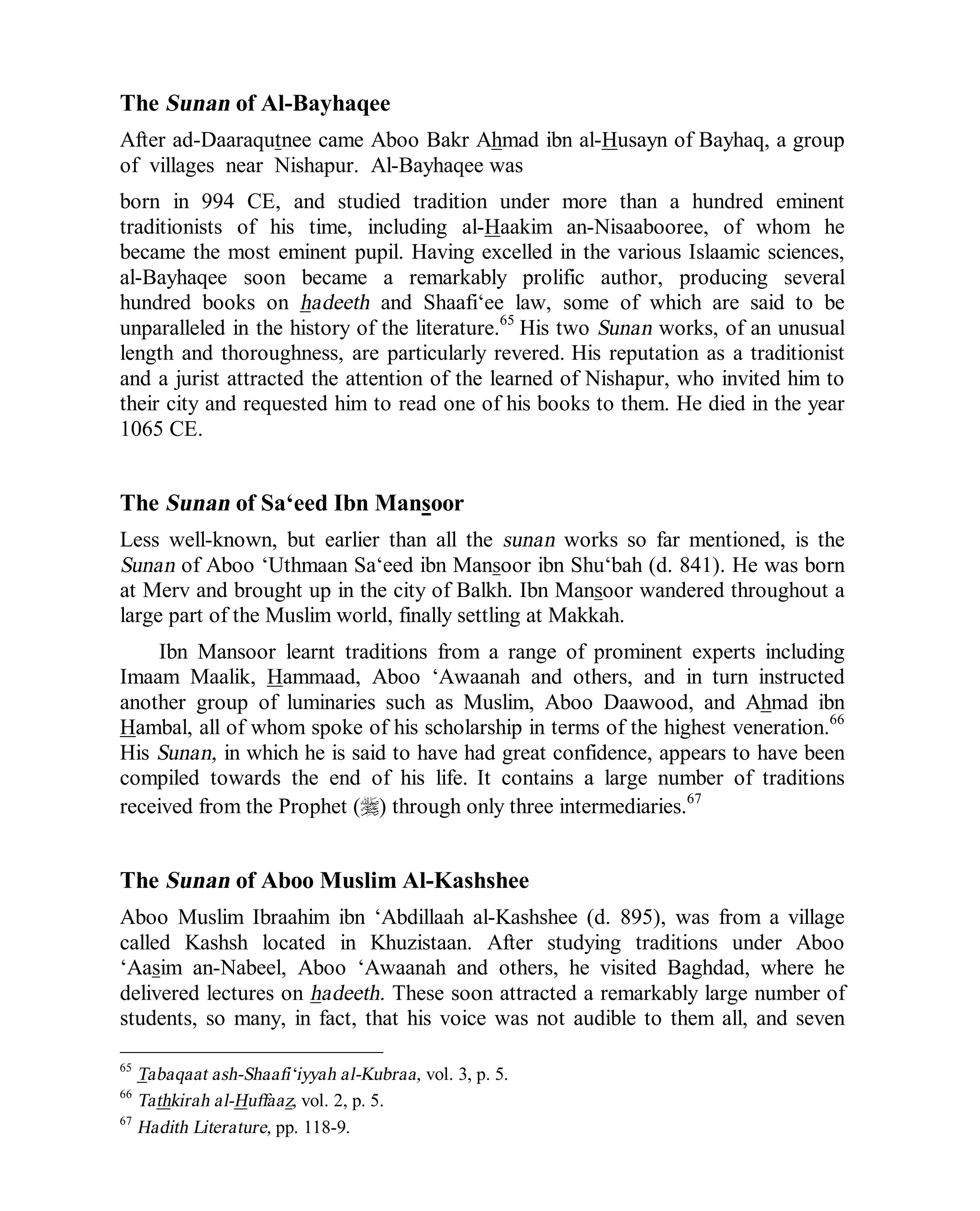







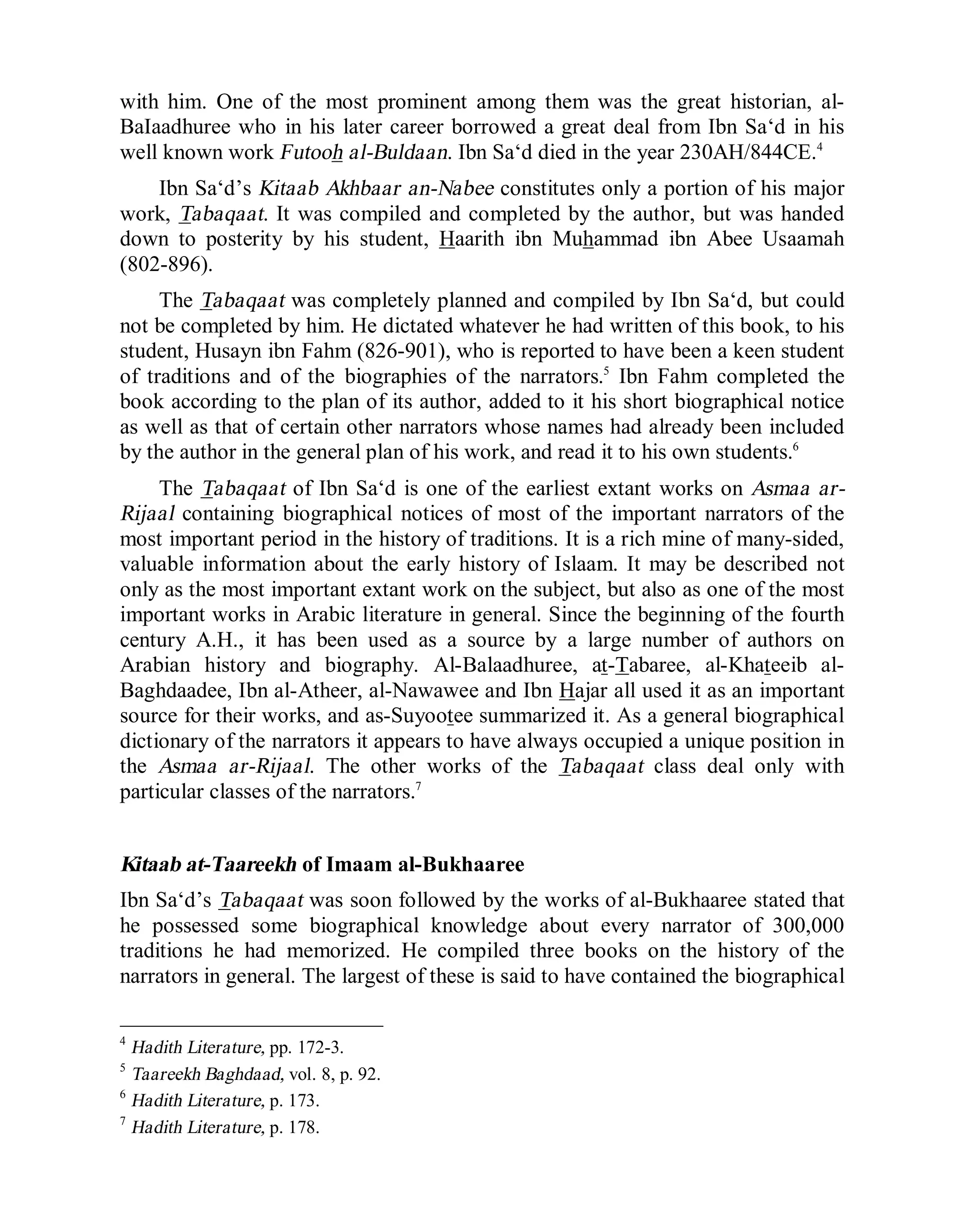



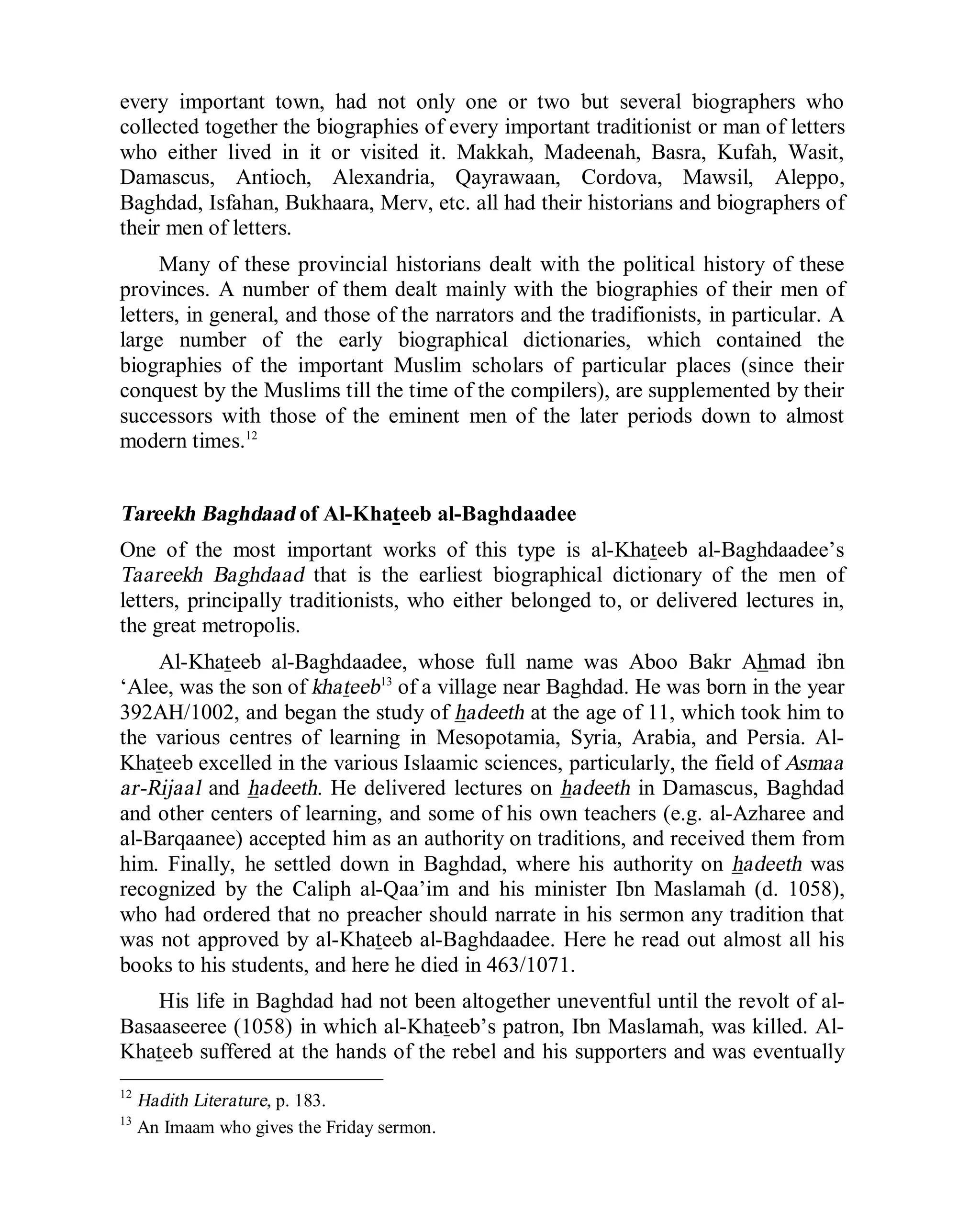
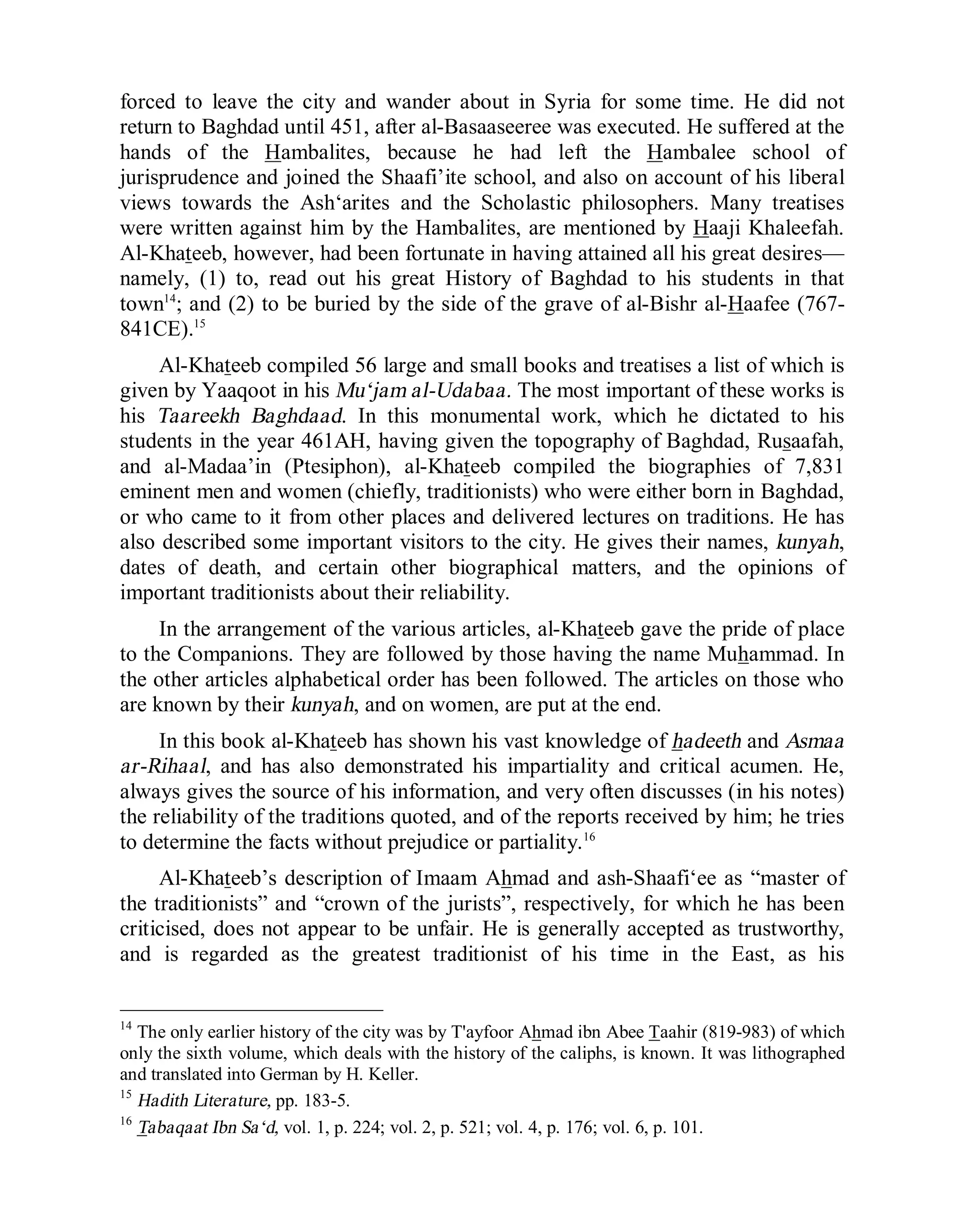
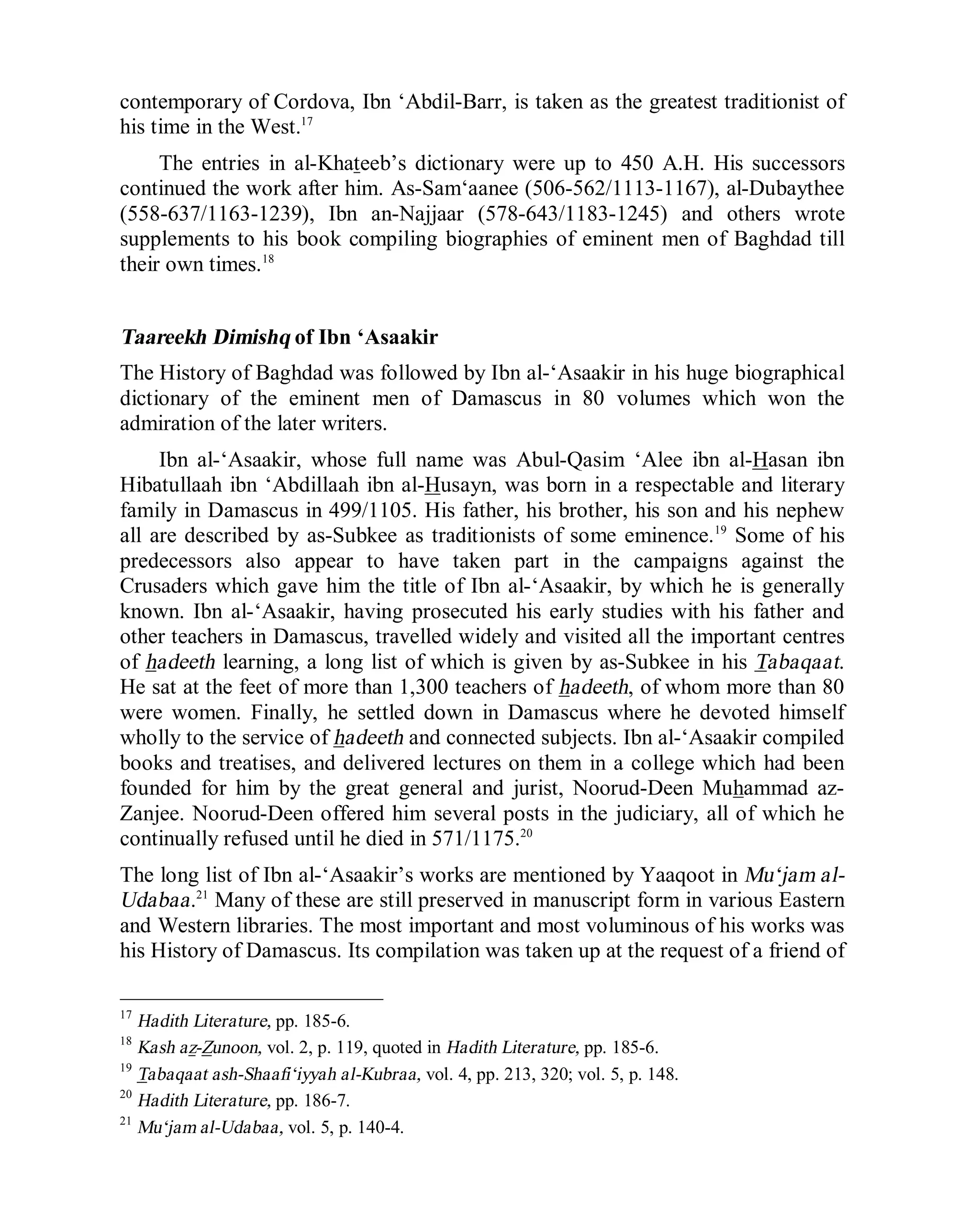
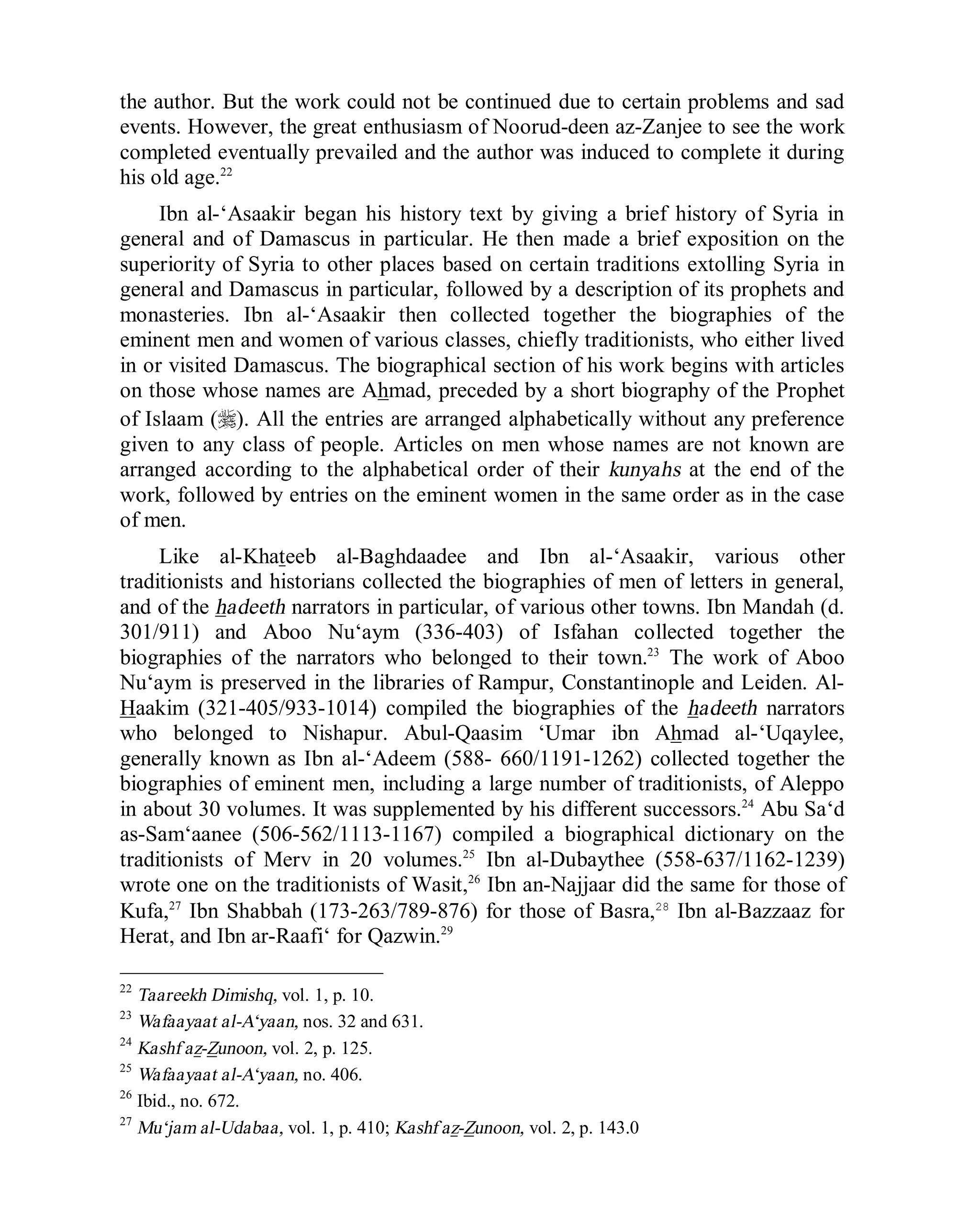



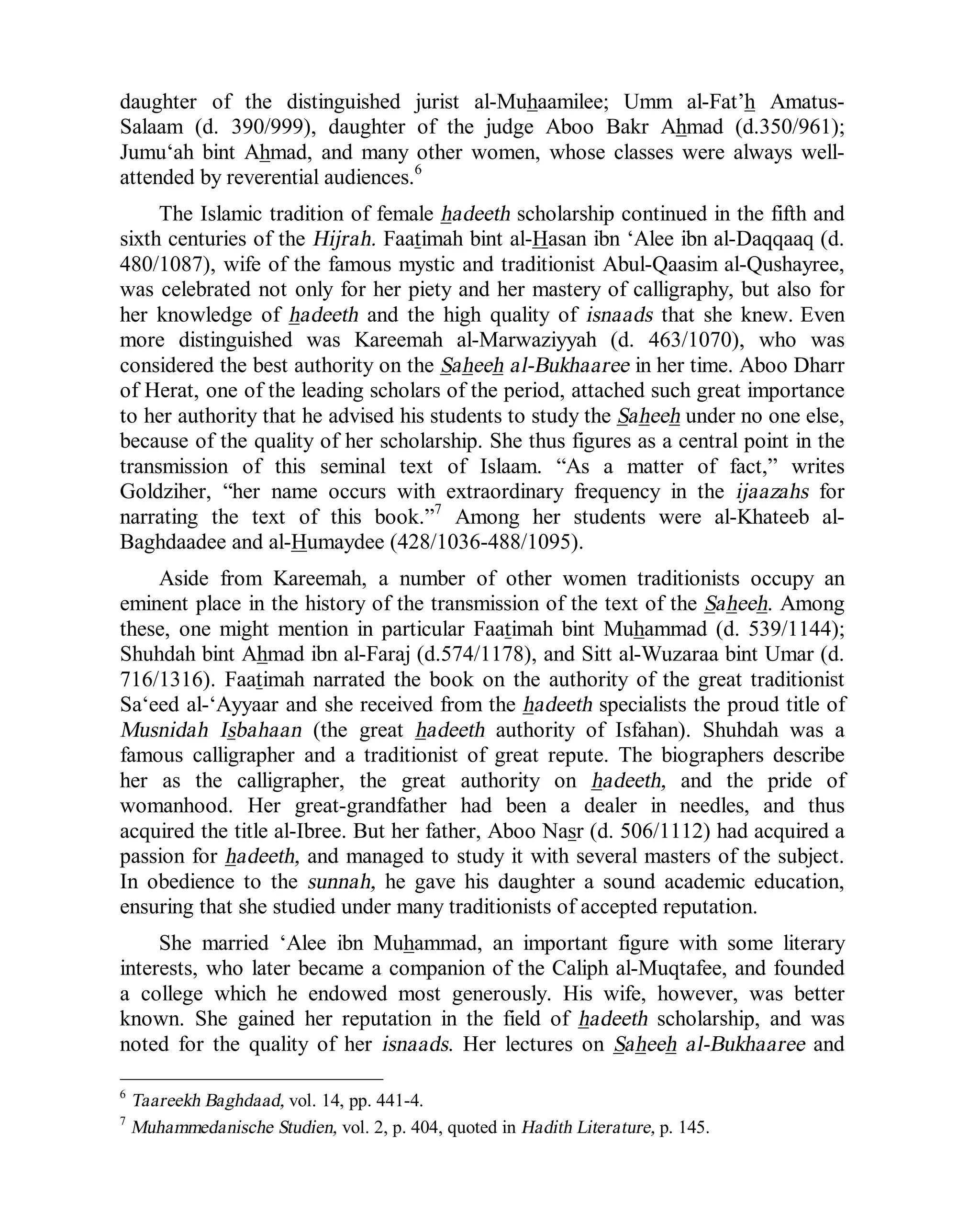










![© Islamic Online University Usool al-Hadeeth 101
http://www.islamiconlineuniversity.com 3
BBIIBBLLIIOOGGRRAAPPHHYY
Albaani, Nasir ad-Din al-. The Hadith is Proof Itself in Belief & Laws. Miami,
Florida: The Daar of Islamic Heritage, 1995.
………………, Da‘eef al-Jaami‘ as-Sagheer. Beirut: al-Maktab al-Islaamee,
1979.
………………, Irwaa al-Ghaleel. Beirut: al-Maktab al-Islaamee, 1st ed., 1979.
………………, Saheeh Sunan Abee Daawood. Beirut: al-Maktab al-Islaamee,
1st ed., 1988.
………………, Silsilah al-Ahaadeeth ad-Da‘eefah wal-Maudoo‘ah. Beirut: al-
Maktab al-Islaamee 3rd. ed. 1972.
Ansari, Muhammad Tufail, Sunan Ibn-i-Majah [Arabic/English], Lahore: Kazi
Publications, 1st. ed., 1993.
Arnaa’oot ‘Abdul-Qaadir al- (ed.). Jaami‘ al-Usool fee Ahaadeeth ar-Rasool.
Beirut: Maktabah al-Hilwaanee, 1969-72.
‘Asqalani, Al-Haafith Ibn Hajar al-, Bulugh Al-Maram (Eng. Translation),
Riyadh: Dar-us-Salam Publications, 1996.
‘Atiyyah, ‘Izzat ‘Alee, Al-Bid‘ah, Beirut: Daar al-Kitaab al-‘Arabee, 2nd
ed.,
1980.
Azami, Muhammad Mustafa, Studies in Hadith Methodology and Literature,
Indianapolis, Indiana: American Trust Publications, 1977.
Davids, Mohammad Adil. The Science of Authenticating The Prophet’s
Traditions. Cape Town, South Africa: Darul Hadith Trust, 1998.
Dihlawee, Shaah ‘Abdul-‘Azeez. Bustaan al-Muhadditheen. Delhi, 1898.](https://image.slidesharecdn.com/usool-al-hadeeth-the-methodology-of-hadith-evaluation-130905043227-/75/Usool-al-hadeeth-the-methodology-of-hadith-evaluation-164-2048.jpg)
